
Information Technology Business Case
Development
University of Wisconsin System Administration
Business Cases 1, 2, & 3
August 2015

© 2015 Huron Consulting Group. All Rights Reserved. Proprietary & Confidential.
Executive Summary
2
BUSINESS CASES
This document presents 3 business cases developed over the course of the 12 weeks that Huron was
engaged by UWSA.
Contents
Business Case Template 3
Organizational Context 6
Business Case Opportunities & Strategic Enablers 13
Business Case 1 17
Business Case 2 37
Business Case 3 60
Appendix 90

Business Case Template
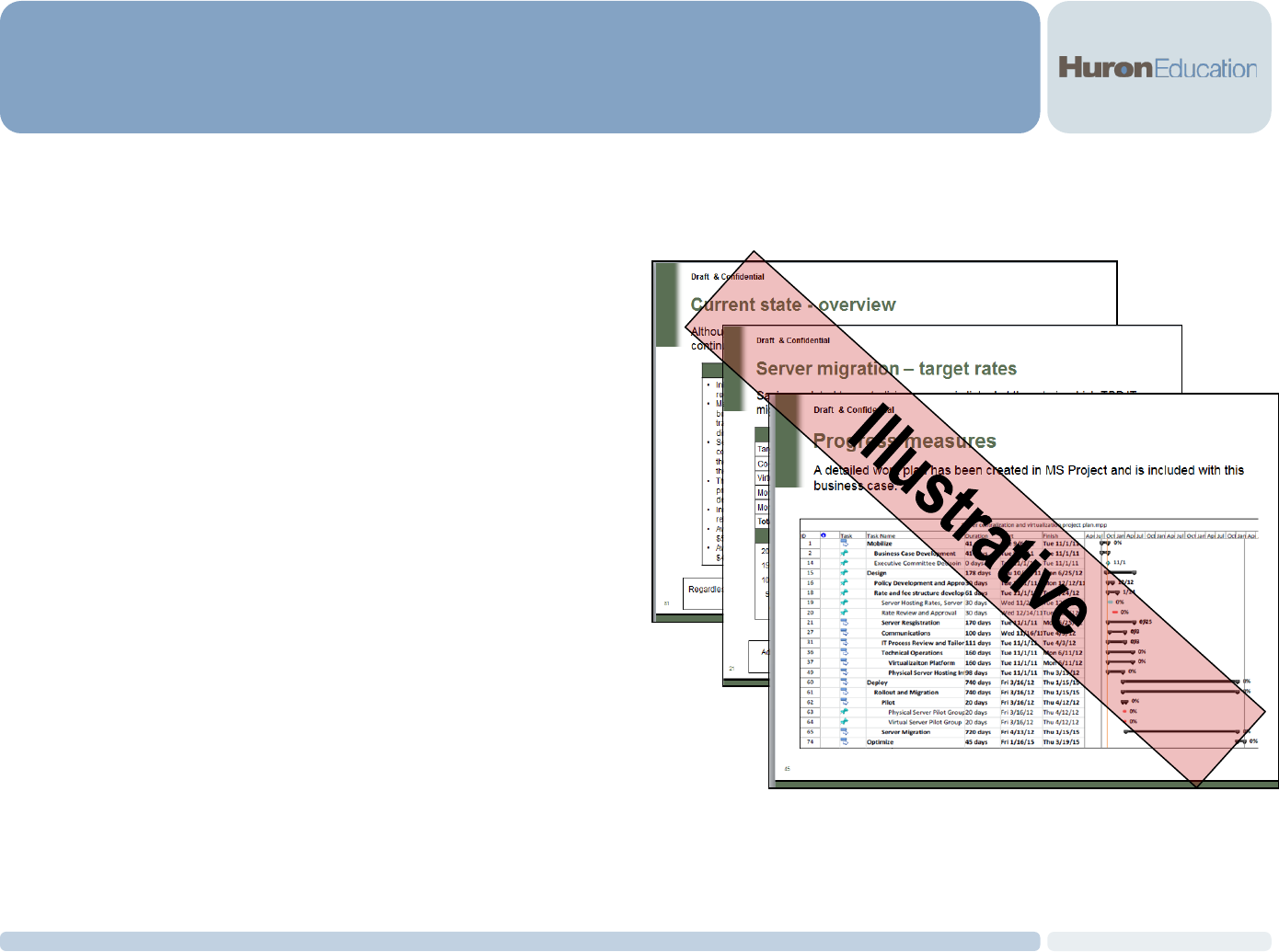
© 2015 Huron Consulting Group. All Rights Reserved. Proprietary & Confidential.
Business Cases
BUSINESS CASE OVERVIEW
Huron’s business cases are structured proposals that outline the benefits and considerations of an
initiative to add informational and analytical value to decision-making.
4
Business cases are designed to:
• Quantify the impact of recommendations
• Provide analysis to support and justify the findings
• Create an impetus to take action
Strong business cases draw conclusions based on:
• Current-state assessment
• Benchmarking, gap analysis or option evaluation
• Cost benefit analysis

© 2015 Huron Consulting Group. All Rights Reserved. Proprietary & Confidential.
Business Cases
DATA & ASSUMPTIONS
5
Data Assumptions and Notes:
• Data available at the time of this report was either inconsistent, incomplete, or unknown. This underscores the
need for a more standardized and transparent approach to data collection and reporting.
• Projected financial impact displayed may not include full cost of implementation. For opportunities selected to
pursue, the UW should engage in more robust data collection and analysis to identify the full scope of
implementation, resource requirements, and associated costs.
• Analyses may not incorporate campus-level initiatives taking place to reduce costs in reaction to the
announced budget cuts. Additional consideration should be given to reductions that have already taken place
at the institutional level.

Organizational Context

© 2015 Huron Consulting Group. All Rights Reserved. Proprietary & Confidential.
Business Cases
ORGANIZATION CONTEXT
7
The work that culminates in the business cases presented in this
document was conducted during a period of immense challenge with
an uncertain budget future and therefore unclear responses to cuts.
Before we get into the detail of the business cases, we wish to
acknowledge the engagement of the IT community across the
University of Wisconsin system campuses, including the CIOs, and the
engagement of Provosts and Chief Business Officers in providing
input, data, guidance, perspective, institutional and historical context,
and encouragement.

© 2015 Huron Consulting Group. All Rights Reserved. Proprietary & Confidential.
Business Cases
ORGANIZATION CONTEXT
8
Providing the full context is infeasible, however, there are several critical elements of context that are
important to understand when considering the ideas and recommendations presented in this document.
Organizational Context:
• The University of Wisconsin System is facing reductions in state funding by approximately $125 million per year
• Those cuts are the largest of a series of cuts the University has received over the past decade
• The campuses that comprise the UW System operate predominately independently with several noted
exceptions including: (System-wide high-speed network, Common Systems Review Group, VoIP collaboration,
virtualization collaborations)
• Recent leadership turn-over throughout the UW System (Chancellors, Provosts, UW system leadership)
• Culture of decentralized and distributed decision making both at the system and institutional level
IT Trends:
• Rapid pace of innovation
• Changing user preferences require that IT functions be increasingly nimble and adaptive
• Increasing adoption of digitization and technology across nearly every facet of the academy
• Increased capacity and capability for 3
rd
party services (e.g., Amazon Web Services)
• Students who are “digital natives” served by faculty and staff with vastly different attitudes, capabilities, and
understanding of technology
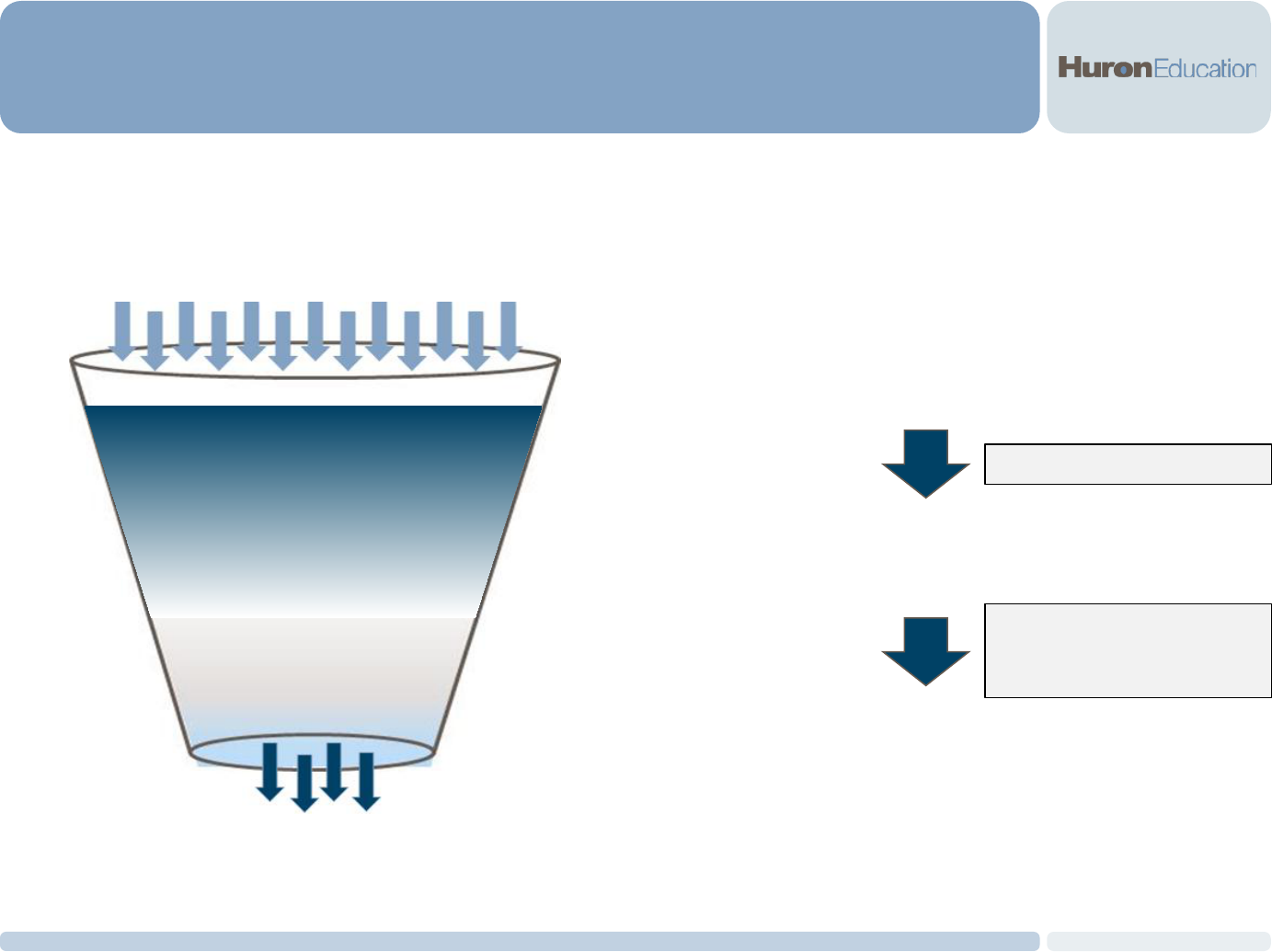
© 2015 Huron Consulting Group. All Rights Reserved. Proprietary & Confidential.
Business Cases
BUSINESS CASE OPPORTUNITY IDENTIFICATION
9
Huron utilized a process by which a broad group of stakeholders provided contextual knowledge of UWS,
engaged in identifying opportunities, and provided input into language / grouping of opportunities.
• Initiated data request to all campuses
• Conducted multiple CIO working sessions
• Utilized ITMC brainstorming notes
• Distributed survey to all CIOs, CBOs, and Provosts
• Synthesized opportunities, applied prioritization
framework, and presented to Advisory Committee
• Finalized opportunities presented to Executive
Leadership Team for consideration
Idea Generation / Brainstorming
Final Opportunities for
Consideration
Advisory Committee
Engagement
Identified 52 Opportunities
Combined multiple
opportunities into three
proposed business cases

© 2015 Huron Consulting Group. All Rights Reserved. Proprietary & Confidential.
Business Cases
CONSIDERATIONS
10
• Culture: UW Institutions have a high degree of autonomy; this independence is ingrained in institutional cultures to varying
degrees. Feedback received from institutional stakeholders indicates that this may be very difficult to overcome for certain
opportunities identified.
• Collaboration: Institutions have begun collaborating with respect to IT initiatives, both as a result to improve service and to
reduce costs (e.g., leveraging institutions for VoIP or backup location for servers).
• Flexibility: CIOs believe that while centralization may make sense for certain initiatives / opportunities, special
consideration should be given to the need to remain flexible / sufficiently nimble to respond to institutional and market
demands in order to better serve constituents and students.
• Trust: Our discussions with stakeholders and respondents to the survey indicated that there is a lack of trust with respect to
centralization initiatives. Historically, results have been mixed and the corresponding service enhancements and costs
reductions have not been achieved.
• Timing: The timing / implementation of opportunities should be carefully considered as it will have significant impact on
change management, available funding, and service provided to constituents.
• Accountability: For any opportunity pursued, there must be clearly articulated service expectations and responsibilities
among the institutions and UWSA.
1
2
3
4
5
6
The following contextual considerations were identified through our working sessions, surveys, and
discussions with UW stakeholders.

© 2015 Huron Consulting Group. All Rights Reserved. Proprietary & Confidential.
11
EFFECTIVE IT DECISION MAKING STRUCTURES
Business Cases
A disciplined governance structure aligns investment decisions with institutional and system priorities.
Leadership aligned at the appropriate levels can focus IT priorities with long-term strategies and goals.
Components of Successful IT Decision Making Structures:
• Clearly delineated decision rights and ownership
• Transparency and active communication with stakeholders
• Decisions aligned with strategic direction
• Stakeholder control of cost management and investment
• Defined triage and intake process for new issues that require attention
• Process for business case analysis, review, and input based on institutional needs and appropriate justification
• Consistent, repeatable processes for executing approved initiatives that are scalable for large and small
projects
IT Decision Making Structures
Decision making structures in the case of IT are:
• Mechanisms through which clear and repeatable sets of data, inputs, analyses, priority-setting, and accountability are provided
• Supported by processes and norms that engage stakeholders and increase transparency
Decision making structures in the case of IT are not:
• IT strategy, but the processes and organization to enable strategic decisions and successful execution
• Bureaucratic structures to slow the evaluation and execution of initiatives

© 2015 Huron Consulting Group. All Rights Reserved. Proprietary & Confidential.
Business Cases
BUSINESS CASE OPPORTUNITIES
12
The following opportunities were selected by UWSA leadership for business case development.
Business Cases:
1. Migrate specific ERP systems currently hosted internally to third-party providers.
2. Explore alternative delivery models for IT services and administration.
3. Engage in enhanced strategic sourcing for IT hardware, etc.

Business Case Opportunities
& Strategic Enablers
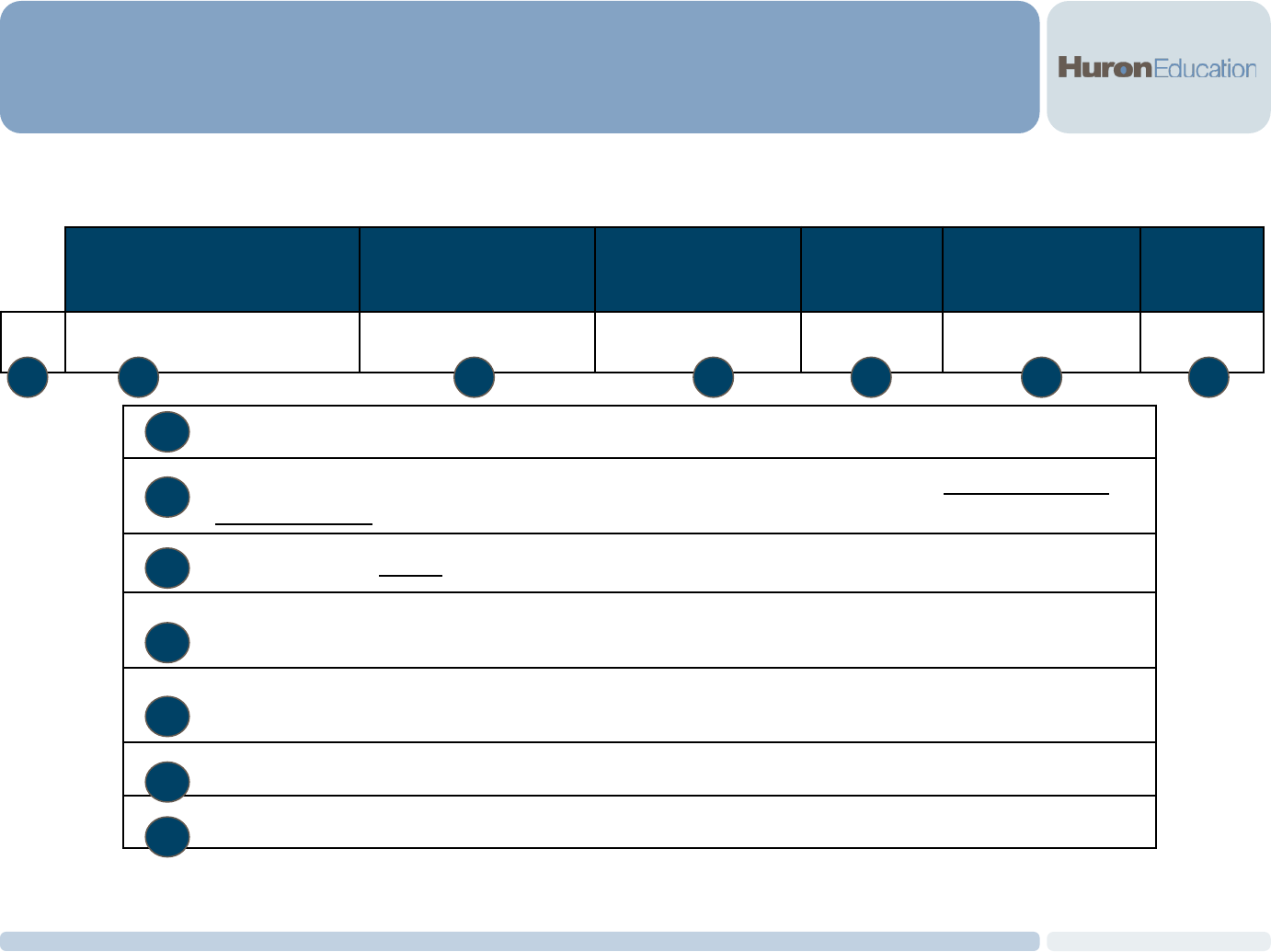
© 2015 Huron Consulting Group. All Rights Reserved. Proprietary & Confidential.
Opportunity number
Description of each opportunity worded as an action to clarify the opportunity, not to represent a
recommendation
Estimation of the annual cost savings or revenue enhancement (Net initial investment required)
1
Assessment of the risk assumed if implemented on a scale of low to high, either for the UW System
or institutional-level
Assessment of the indirect or “systemic” effects of the opportunity on other opportunities for
efficiency
Assessment of the complexity of moving forward with implementation for each opportunity
Estimate of the timeframe to realize efficiency savings (beginning from a decision to implement)
Business Cases
IDENTIFIED COST SAVINGS AND STRATEGIC ENABLEMENT OPPORTUNITIES
14
Each opportunity will be presented in the following “menu” format representing summary-level analyses
found within the business cases.
Opportunity
Annual
Financial Impact
UWS Risk
Exposure
Efficiencies
Gained
Implementation
Complexity
Timeframe
(Months)
#
High-Level Description
1 2 3 4 5 6 7
1
2
3
4
5
6
7
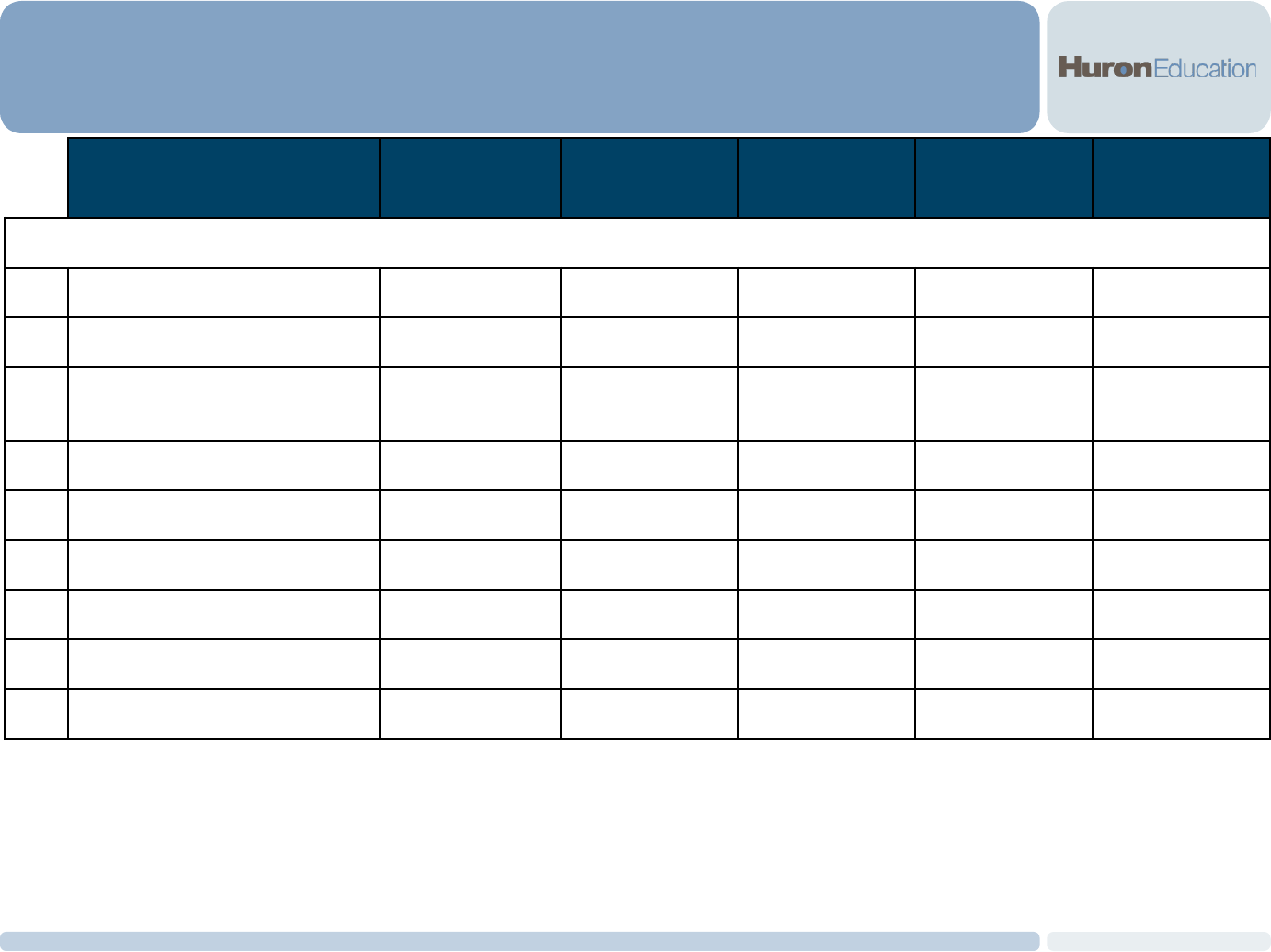
© 2015 Huron Consulting Group. All Rights Reserved. Proprietary & Confidential.
Business Cases
IDENTIFIED COST SAVINGS AND STRATEGIC ENABLEMENT OPPORTUNITIES
15
Opportunity
Annual Est.
Savings
UWS Risk
Exposure
Efficiencies
Gained
Implementation
Complexity
Implementation
Timeframe
Business Case # 1
1
Consolidate hosting of SISs
$$$$
Medium Medium Medium 12-36 Months
2
Reduce customizations within SIS and
consolidate instances
Enabling Low High High 24-36 Months
3
Explore vendor
managed infrastructure and
rationalize current infrastructure for HRS
and SFS
$$$$
Medium Medium Medium 6-18 Months
4
Reduce customizations within HRS and
SFS
Enabling Low High High 36-60 Months
5
Develop
financial model allocating the costs
of customizations to requesting campus
Enabling Low High Low 0-6 Months
6
Develop a total cost of ownership model for
future customization requests
Enabling Low High Low 3-6 Months
7
Develop a System-
wide IT decision making
process and mechanism
Enabling Low High Low 6-12 Months
8
Include cloud option as part of vendor
system selection for Budget System
Strategic Investment Low High High 12-36 Months
9
Explore transition of non-ERP systems to
cloud solutions
TBD TBD TBD TBD TBD

© 2015 Huron Consulting Group. All Rights Reserved. Proprietary & Confidential.
Business Cases
IDENTIFIED COST SAVINGS AND STRATEGIC ENABLEMENT OPPORTUNITIES
16
Opportunity
Annual Est.
Savings
UWS Risk
Exposure
Efficiencies
Gained
Implementation
Complexity
Implementation
Timeframe
Business Case # 2
10
Centralize IT security resources Enabling Low High Medium 6-12 Months
11
Consolidate IT Helpdesks
$$$$
Medium Medium High 12-24 Months
12
Consolidate High Performance Computing
Enabling Low Medium Medium 6-24 Months
13
Consolidate datacenter facilities
$$$$
High High High 24-48 Months
14
Identify additional areas for system-wide
collaboration
TBD
TBD TBD TBD TBD
15
Re-Organize IT Leadership
$$$$
Medium High High 24-48 Months
Business Case # 3
16
Create System-wide
standardized bundles
for laptops, desktops, and peripherals
$$$$
Low Medium Medium 6-12 Months
17
Enforce policies for preferred purchases
(Madison foregone savings displayed)
$$$$
Low Low Low 0-6 Months
18
Develop a collaborative, System-wide
procurement function to take advantage of
scale
Enabling Low High High 12-24 Months

Business Case #1:
Evaluate Alternative Hosting Models
for Primary Systems

© 2015 Huron Consulting Group. All Rights Reserved. Proprietary & Confidential.
Business Case # 1
OBJECTIVES
Our objective in this business case was to evaluate the feasibility of migrating primary information systems
to alternative hosting models or cloud based environments.
18
Though the focus of this business case was on the UW’s primary systems (SIS, HRS, SFS, Budget), Huron believes that
additional services should be considered for cloud computing.
Objectives: Huron was asked to evaluate the feasibility and / or impact of transitioning UW’s ERP systems to
alternative hosting models or cloud-based solutions. The following were incorporated into the analysis:
• Identify available options for hosting (e.g., centrally, cloud-based)
• Identify primary solutions available (e.g., Oracle, Workday)
• Evaluate the relative level of cloud maturity (e.g., infrastructure, SaaS / Cloud)
• Evaluate each system’s readiness to transition to cloud-based solutions (e.g., level of customizations)
Future-State Considerations:
• Systems are inter-connected and the development of a holistic approach to future-state system integration and
process re-design is recommended
• The impact of bolt-on and other applications should be considered as part of future-state requirements
determination
• Cloud-based solutions continue to mature; the UW should develop a comprehensive roadmap to system
upgrades and an overall cloud adoption strategy
• Upgrade to Cloud / SaaS solution may require multiple steps – cannot “flip a switch”

© 2015 Huron Consulting Group. All Rights Reserved. Proprietary & Confidential.
Business Case # 1
CONTEXT AND BACKGROUND
The rapid evolution of technology is fundamentally changing the way companies and higher education
institutions consider, consume, and manage IT.
19
Context:
• As technology continues to become more pervasive across all facets of university activities, the demand to do
more with less becomes stronger
• UW institutions are having issues recruiting, hiring, and retaining technical IT staff (e.g., DBAs)
• Responses to the problem this poses include changing what institutional IT does, what system-level IT does,
and what is procured from third-parties
o Vendor solutions continue to mature
o Scale economies may drive down cost
o Vendor pricing models impact the beneficiaries from increased efficiencies
• Timing and approach to any transition will be critical factors in determining success and realization of efficiencies
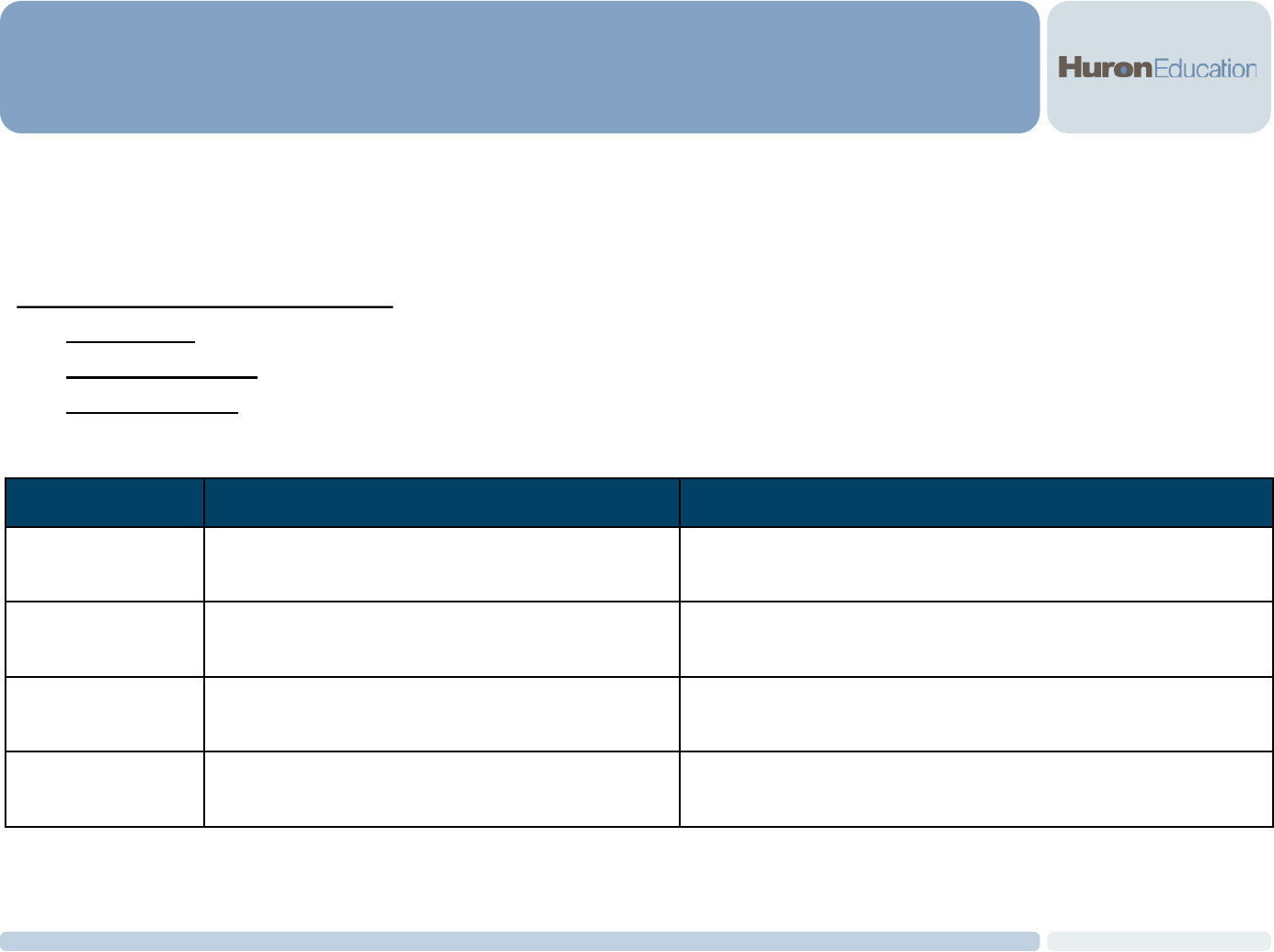
© 2015 Huron Consulting Group. All Rights Reserved. Proprietary & Confidential.
Business Case # 1
WHAT IS CLOUD COMPUTING
Cloud computing is the delivery of IT resources and applications through the use of the internet rather than
through the utilization of a local server or personal computer.
20
Characteristic Comments Benefits
Scale
Immediate provisioning and de-provisioning of
compute resources
Increases ability to manage and plan for IT resources
Speed
Often offers improved infrastructure and speed
over traditional, on premise environments
Servers or new environments can be deployed in minutes /
hours vs. days / weeks
Cost
Utilize a pay-as-you-use pricing model
Reduced capital expenditures and increased ability to
manage budgets
Resiliency
Geographically dispersed infrastructure Improved ability to mitigate risks
Who is Using Cloud Computing?
• Companies: Netflix does not own or operate their own datacenters outsourced to Amazon
• Higher Education: Consortiums such as Unizin or Internet2 collaborations able to leverage scale
• Personal Users: All iPhone users have access to Apple’s iCloud storage personal cloud

© 2015 Huron Consulting Group. All Rights Reserved. Proprietary & Confidential.
Business Case # 1
WHAT IS CLOUD COMPUTING
21
Essential Characteristics*
1. On Demand: Consumer can provision computing capabilities as needed, such as server time and network storage, without requiring human
interaction with each service’s provider
2. Broad Network Access: Capabilities are available over the network and accessed through standard mechanisms that promote heterogeneous
thin/thick client platforms (e.g., mobile phones)
3. Resource Pooling: Provider’s computing resources are pooled to serve multiple consumers using a multi-tenant model, with different physical and
virtual resources dynamically assigned and re-assigned according to consumer demand
4. Rapid Elasticity: Capabilities can be rapidly and elastically provisioned, in some cases automatically, to quickly scale out and rapidly released to
quickly scale in
5. Measured Service: Cloud systems automatically control and optimize resource use by leveraging a metering capability at some level of abstraction
appropriate to the type of service (e.g., storage, processing, bandwidth, and active user accounts)
*Source: EDUCAUSE
Characteristics Localized Private Cloud
Virtual Private
Cloud
Public Cloud
Location
On Premise Off Premise Off Premise Off Premise
Hardware Owner
Institution Vendor Vendor Vendor
Payment Model
Capital + Support Provision + Usage Monthly / Usage Pay-per-use
Scalability
Low-Medium Medium High Very High
App. Migration Effort
None Low Low Dependent on App.
Break / Fix Approach
Repair H/W Repair VM or H/W Repair VM Recreate VM

© 2015 Huron Consulting Group. All Rights Reserved. Proprietary & Confidential.
Business Case # 1
WHAT IS CLOUD COMPUTING
In addition to the localized (on premise) hosting model, “X as a service” options are changing the way
corporations and higher education institutions manage, provision, and invest in IT resources.
22
Infrastructure as a Service
(IaaS)
Platform as a Service
(PaaS)
Software as a Service
(SaaS)
Overview
Virtualized computing
infrastructure (pooling of
resources)
Web and mobile application
development using pre-
configured components
Delivers on-demand
applications that are hosted
and managed by vendor
Benefits
• Vendor manages
infrastructure
• Highly scalable
• Reduced capital expenditures
• Service provider
maintains programming
languages, application
servers, and databases
• Reduced upgrade times
• Pay-as-you-use pricing
model
• Encourages
standardization
Considerations
• Reduced control of local IT
resources
• Requires careful analysis of
actual resources required
• Increased vendor lock-in
• Integration and support
to existing applications
• Customizations can
quickly increase costs to
support and upgrade
complexity
• High vendor lock-in
Example Companies
Providing Service
• Amazon, Microsoft, Google,
Rackspace, IBM, HP
• Amazon, Oracle,
Microsoft, Engine Yard
• Salesforce, Microsoft,
Google
Level of Standardization
Level of Local Control
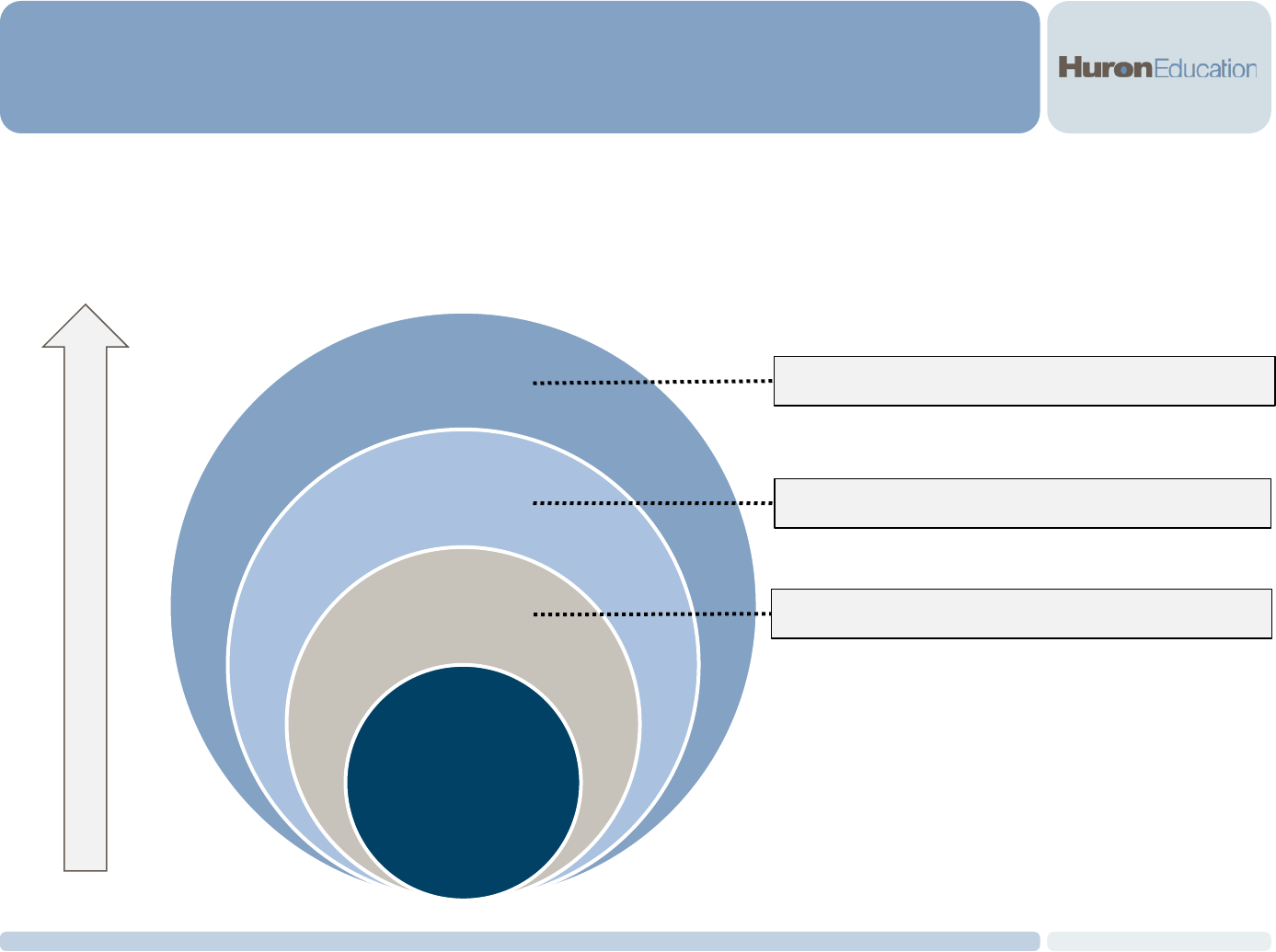
© 2015 Huron Consulting Group. All Rights Reserved. Proprietary & Confidential.
Business Case # 1
WHAT IS CLOUD COMPUTING
Within higher education and more broadly, organizations seek increased efficiency through a transition to a
hybrid service delivery environment comprised of a network of internal and external service providers.
23
Public
Computing
Consortiums
System Level
Campus
Level
Ex: Infrastructure, Hosted Services
Ex: Unizin, Internet2
Ex: Collaborative Disaster Recovery
Scale
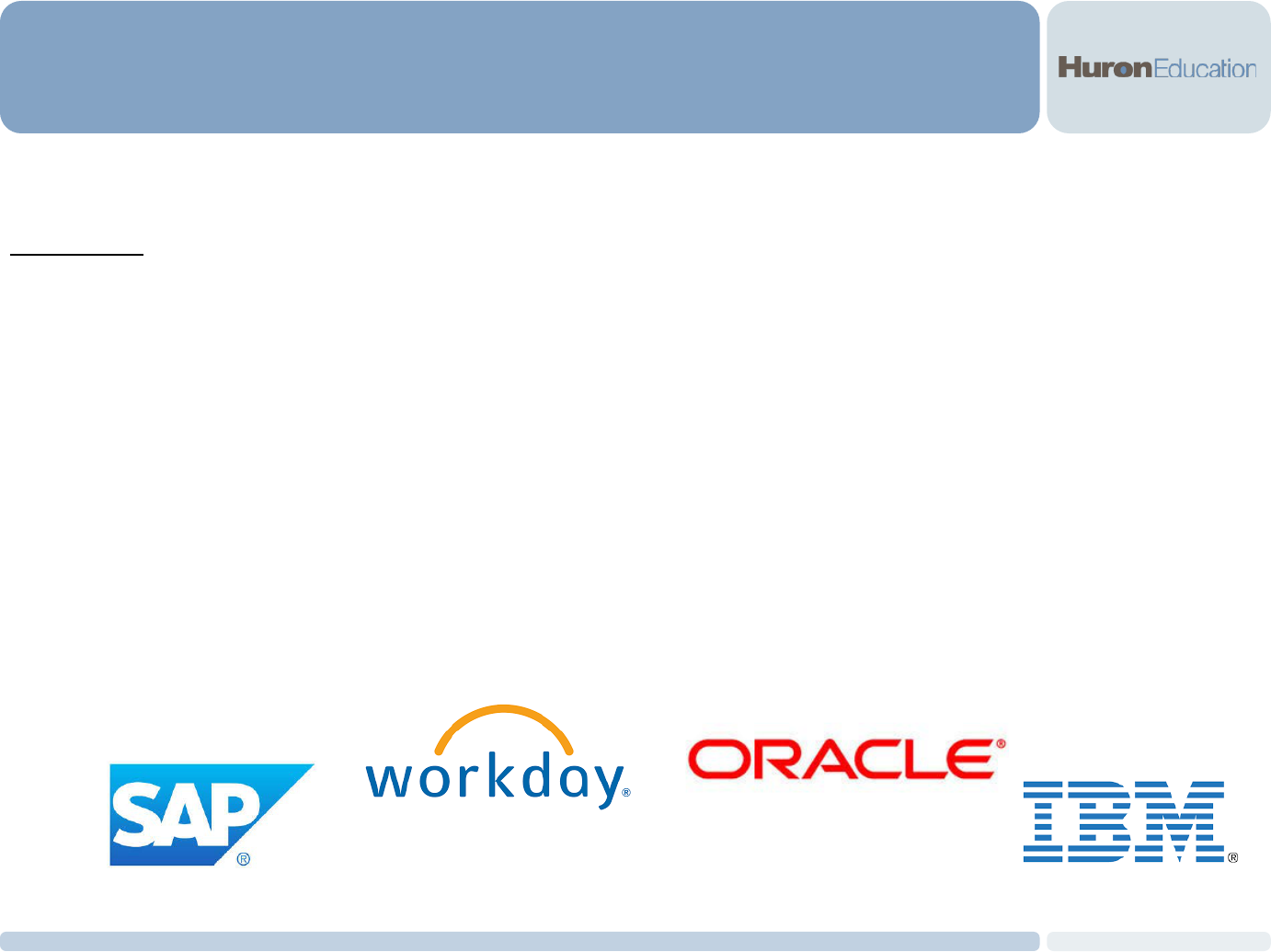
© 2015 Huron Consulting Group. All Rights Reserved. Proprietary & Confidential.
Business Case # 1
LEADING HIGHER EDUCATION ERP VENDORS
24
Increasingly, vendors and companies are investing in cloud-based solutions as a transition from
“traditional” ERPs.
Comments:
• Industry investment in “cloud” based ERP systems is strong and appears to be the signaled direction of
technology migration
• PwC predicts that by 2016, investments by companies in SaaS solutions will double to $78 billion, vs.
investments in traditional ERP systems, declining by over 30% to less than $15 billion*
• Gartner predicts that by 2018, at least 30% of service-centric companies will move the majority of their
ERP applications to the cloud**
• Gartner predicts that by 2017, 70% of hybrid ERPs (combination of cloud and “traditional” solutions) will fail
to improve cost-benefit outcomes unless cloud applications provide differentiated functionality – cloud
applications do not provide value without careful consideration of process, etc.
• Companies like Oracle and Workday are rapidly investing in, and developing, integrated cloud solutions
Source:
*Forbes: Five Catalysts Accelerating Cloud ERP Growth in 2015
**Gartner
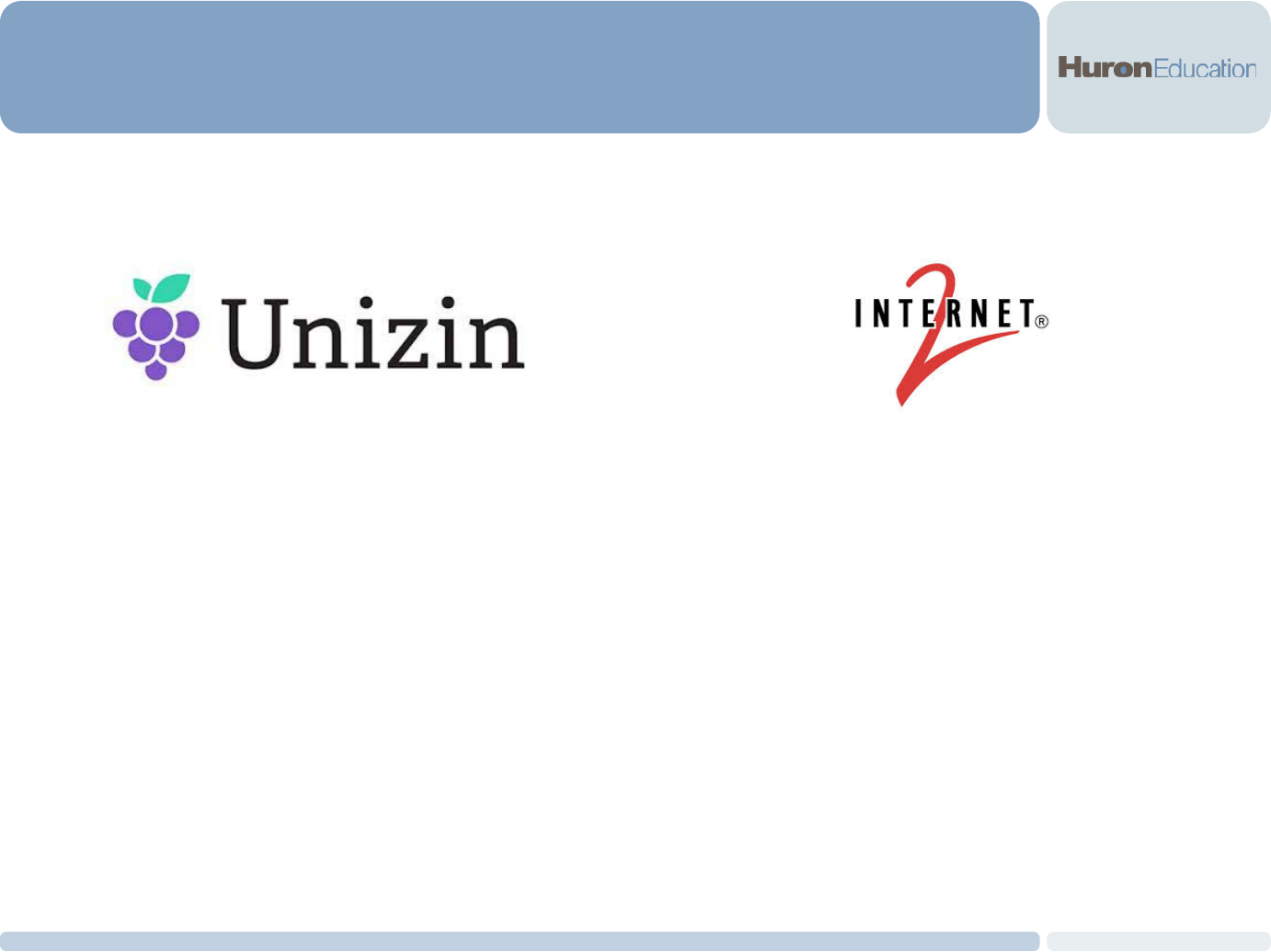
© 2015 Huron Consulting Group. All Rights Reserved. Proprietary & Confidential.
Business Case # 1
HIGHER EDUCATION CLOUD CONSORTIUMS– UNIZIN AND INTERNET 2
Large, Higher Education led consortiums are changing the way cloud-based services are developed and
made available to institutions, research centers, and other governmental / industry partners.
25
• Founded in 2014
• Consortium founded and led by higher education
institutions with a focus on developing a new approach to
digital learning
• Sought an alternative option for learning management
systems with a focus on collaboration rather than
institution-specific initiatives
• Cloud-scale service operator and integrator supporting
Digital Education offerings to partners including Content,
Software Platforms, and Analytics
• Designed to better support faculty and enable student
success
• Focus to provide “common gauge rail approach” for
infrastructure – encourages faculty collaboration
• Founded in 1997
• Non-profit computer networking consortium
• Institutions / partners can provision network and other
services
• Connects over 60,000 U.S. educational, research,
government, and community anchor institutions
• Develops and deploys network technologies such as
large-scale performance measurement and management
tools, secure identity and access management tools, and
the ability to schedule high-bandwidth, high-performance
circuits
• Creates a faster alternative to the internet and fostered
creativity, research, and development not previously
possible

© 2015 Huron Consulting Group. All Rights Reserved. Proprietary & Confidential.
Business Case # 1
SELECT EXAMPLES OF ERP CLOUD COMPUTING IN HIGHER EDUCATION
26
Increasingly, institutions are pursuing cloud-based options to reduce expenditures, re-allocate resources
towards strategic initiatives, and enhance services provided to constituents.
Select Examples of Managed Services (Primary Systems)
Institution Service Pursued Stated Institutional Reasoning
Cornell University
Cloud HCM and Payroll
• Elimination of difficult and time-consuming upgrades
• Wanted to streamline administrative operations
Brown University
Cloud Expenses, Financials, HCM,
Payroll, and Time Tracking
• Ability to re-allocate resources to mission critical
endeavors
• Cost of ownership and business model concept –
institution does not want to be designing business
processes
Boise State
University
Oracle ERP Planning Cloud
• Ability to achieve savings from process improvements
• Reduced infrastructure costs, ability to re-purpose staff,
and eliminate costly upgrades
Case Western
Reserve
Opted for vendor managed application
and production support rather than
invest in new infrastructure
• Infrastructure reliability & speed – increased service
provided while avoiding investment in capital expenditures
• Reduced Risk – improved disaster recovery, data security,
ability to recruit and retain staff
In addition to cloud ERPs, some institutions have developed a more holistic approach to the cloud. The University of
Notre Dame instituted a “cloud first” program with the goal of moving 80% of IT services to the cloud by 2017.

© 2015 Huron Consulting Group. All Rights Reserved. Proprietary & Confidential.
Business Case # 1
BENEFITS / CONSIDERATIONS OF CLOUD COMPUTING
27
Benefits Considerations
• Cloud-based computing is emerging as a more mature
market than it was several years ago
• Reduces costs (transition from CapEx and OpEx)
• Increases focus on core business and strategic vision –
frees up internal resources
• 24/7 service and support
• Pay-per-user / pay-as-you-use model vs. building and
maintaining infrastructure
• Accelerates innovation
• Potential reduction in deployment / upgrade time due to
increased standardization
• Not dependent on location Increased mobilization
• Changes the role of institutional IT staff – focus transitions
to service management and other institutional priorities
• Transition to cloud-computing cannot take place overnight –
requires appropriate due diligence and appropriate vendor
management mechanisms
• Inhibits customizations and increases standardization
(customizations may result in increased costs)
• Requires clearly articulated Service Level Agreements that
define expectations and services provided to constituents
• Requires that the vendor remains compliant with state and
federal rules and regulations – certain cloud models (e.g.,
SaaS) may require additional costs to support new
regulations
• Increases focus on data security – management of data
security changes from on premise model to vendor
managed, potentially requiring changes in current policies /
technical standards
• Increased cost / and ramp-up time (e.g., hiring and training
staff) of transition away from cloud computing – can become
heavily vendor dependent
While cloud computing can offer significant benefits with respect to service, standardization, and cost, the
movement to a cloud environment will require significant due diligence prior to migration.
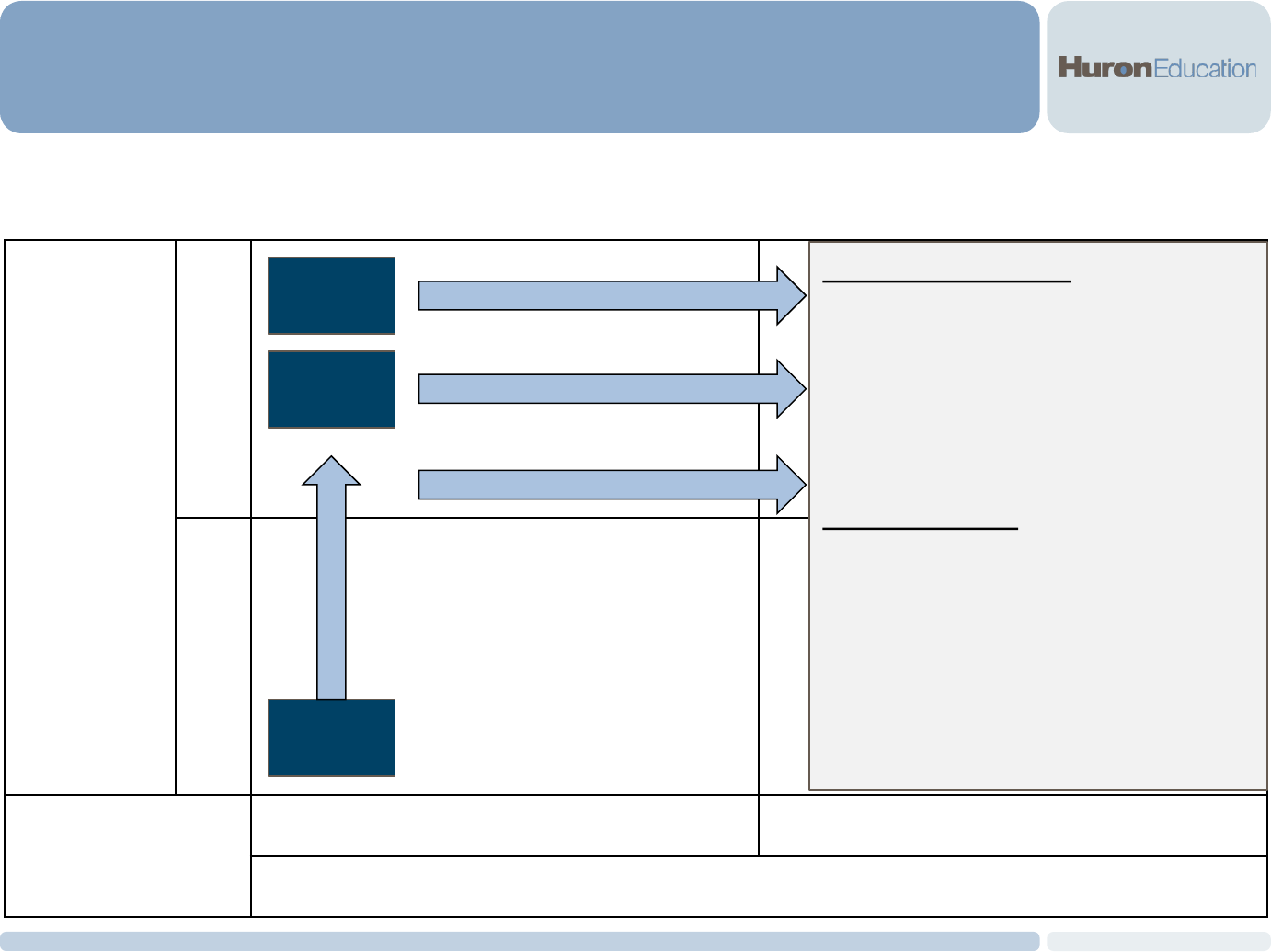
© 2015 Huron Consulting Group. All Rights Reserved. Proprietary & Confidential.
Business Case # 1
HOSTING OPTIONS FOR CURRENT SYSTEMS
28
There are several hosting options available for each system. At present, the largest short-to-intermediate
term opportunity that exists is centralized hosting of Student Information Systems (SISs).
Hosting Model
Centralized Local
Highly Customized “Vanilla”
Level of Customization
SFS
HRS
SIS
Reduce Customizations
Reduce Customizations
Reduce Customizations
Centralize SIS Hosting
Future-State Options: Huron
anticipates that, for the foreseeable
future, the University’s enterprise IT
environment could be a hybrid of
multiple hosting / delivery modalities.
Hosting Options:
1. Hosted centrally
2. Identify vendor managed
infrastructure and application
support
3. Identify cloud / SaaS solution
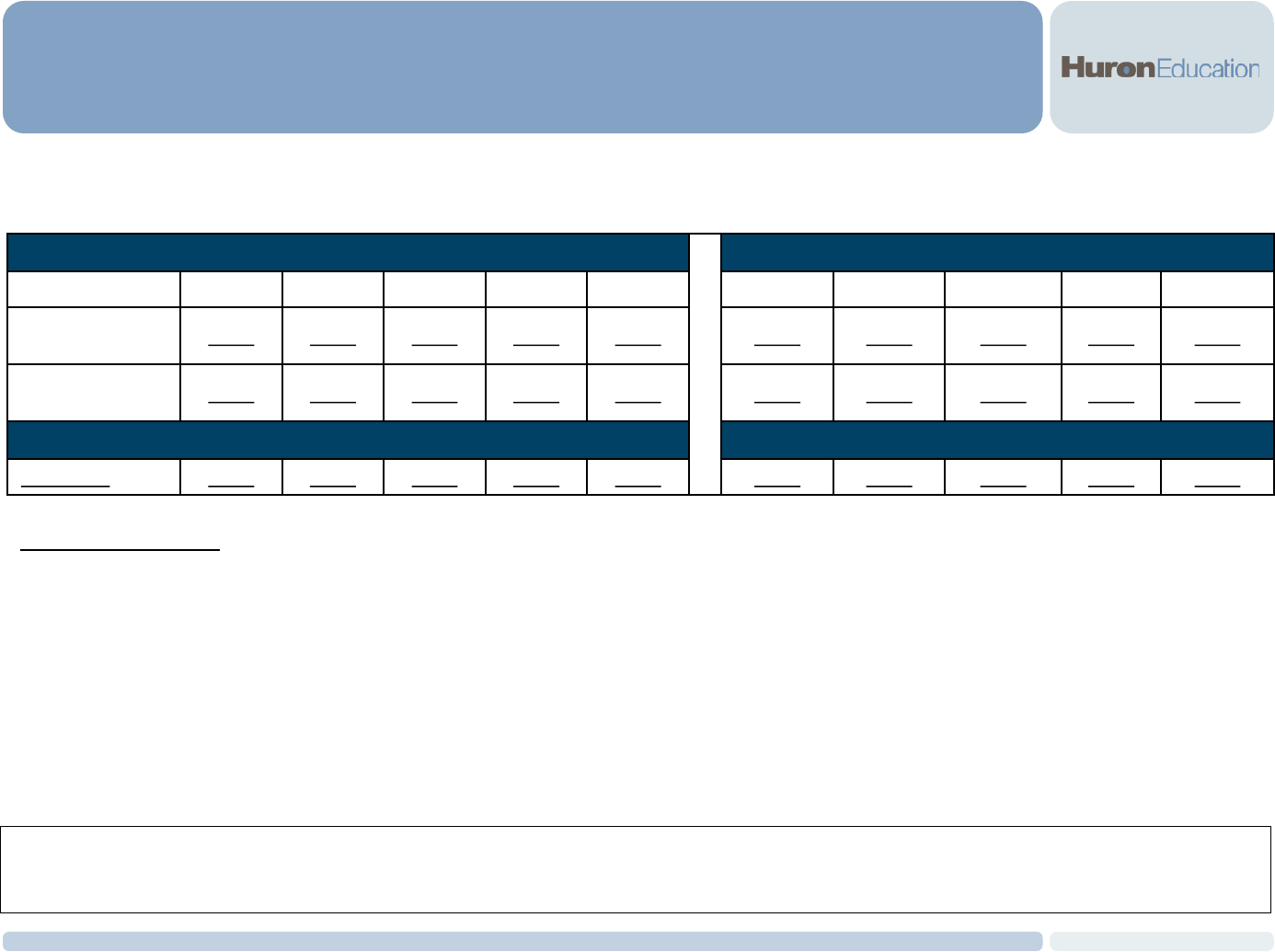
© 2015 Huron Consulting Group. All Rights Reserved. Proprietary & Confidential.
Business Case # 1
SIS RECOMMENDATION OVERVIEW
29
Although precise costs
1
for operating current SISs are unknown, a high-level quantification indicates UW
institutions can realize significant savings by consolidating from campus-based to central hosting of SISs.
* Current state of discussions with CIOs
** Initial survey responses from institutions
***All estimates are based on discussions conducted between UW institution CIOs and UWSA CIO. Data provided by UWSA CIO.
Table Assumptions:
• Current-state salary and fringe estimated to be $95,000 for all FTE salary calculations
• Current-state localized FTE ranges identified through survey and subsequent discussions among CIOs (range 20-35 FTE)
• Future-state hosting assumes centralized staff increased by 4 FTE to manage centralized hardware, etc.
• Multi-year approach assumes financing of Oracle equipment – Future-state consolidation figures provided by Oracle
• UW CIOs suggest potential hardware savings will vary as same hardware supports multiple campus-level service
Note: (1) See Appendix for cost estimates using available data
Huron estimates that, System-wide, the UW could achieve significant annual savings by consolidating the hosting of SISs
to a single location with additional savings opportunities through reducing customizations.
Est. Current State Operating Costs ($000s) Est. Current State Operating Costs ($000s)
Year 1 Year 2 Year 3 Year 4 Year 5 Year 1 Year 2 Year 3 Year 4 Year 5
Current State Low
(20 Inst. FTE)**
$4,500 $4,500 $4,500 $4,500 $4,500 $4,500 $4,500 $4,500 $4,500 $4,500
Current State High
(35 Inst. FTE)***
$6,000 $6,000 $6,000 $6,000 $6,000 $6,000 $6,000 $6,000 $6,000 $6,000
Oracle Consolidation Recommendation – Accelerated ($000s) Oracle Consolidation Recommendation – Multi-Year ($000s)
Annual Cost $5,200 $2,100 $2,100 $2,100 $2,100 $3,500 $3,200 $3,200 $2,400 $2,100
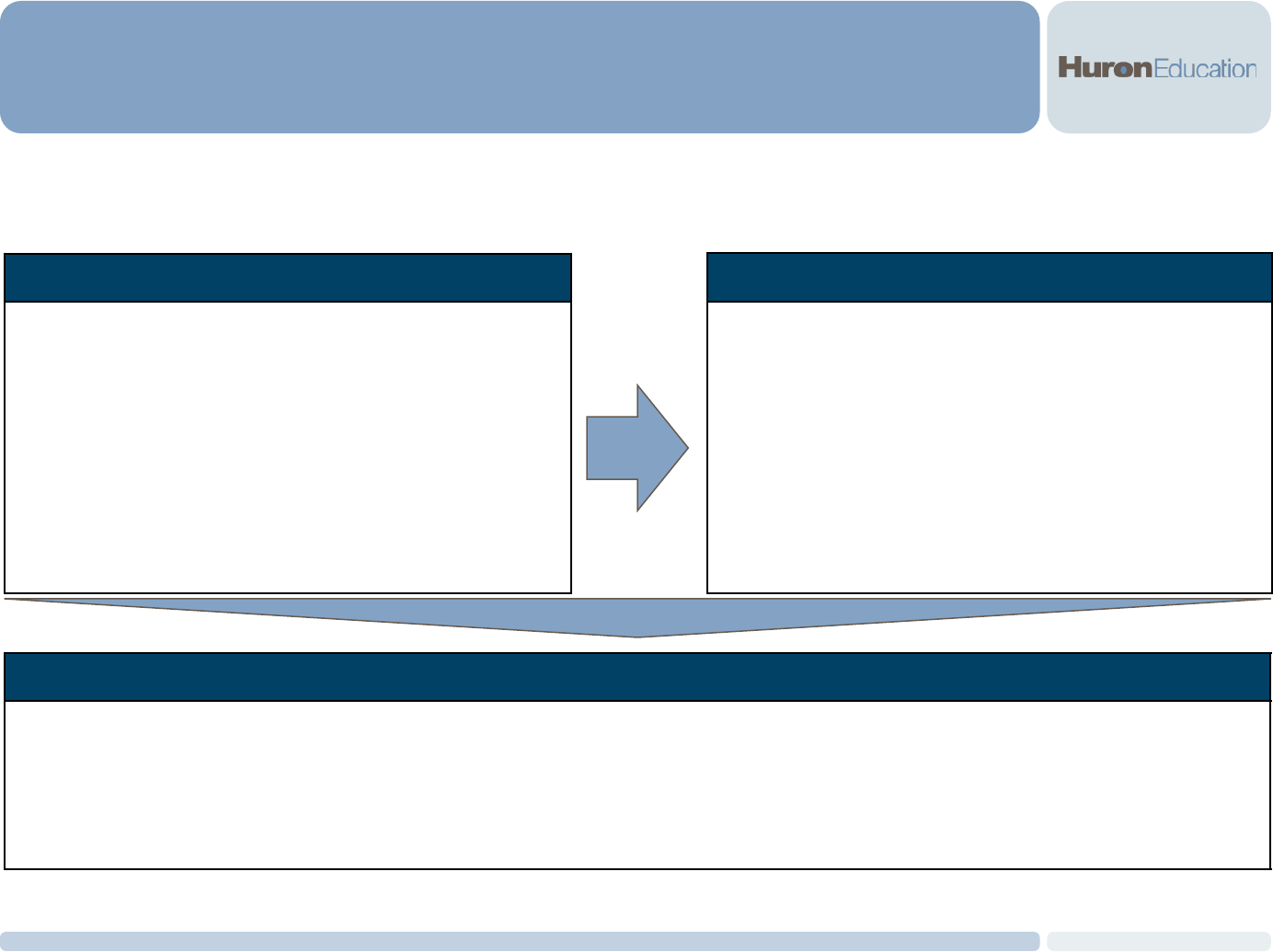
© 2015 Huron Consulting Group. All Rights Reserved. Proprietary & Confidential.
Business Case # 1
STANDARDIZATION OF INSTITUTIONAL BUSINESS PROCESSES
30
In addition to consolidating hosting of all SISs to a centralized model, the UWS should engage in a
comprehensive business process review to identify and remove lower-value-add customizations.
Drivers of Disparate SIS Processes
• Institutional move to PeopleSoft was incremental –
development of business processes not coordinated
• Processes developed around available functionality.
As functionality improved, business processes may
have remained – unclear level of utilized system
functionality
• Disparate use of bolt-on technologies and applications
results in increased institutional customizations and
localized support required
Move Towards Standardization
• Requires directive from System and Institutional
leadership to engage in business process and coding
structure evaluation and re-design
• Recognize and develop common approach to
addressing differences in campus processes
• Develop a systematic approach and strategy for
future-state SIS implementation that identifies
commonalities among institutions
Achievable Outcomes from Standardized Processes & Data Coding
• Allows institutions to re-allocate IT resources to more strategic objectives rather than supporting institution-specific customizations
– may also provide institutions and the system to consolidate systems / applications
• Enables the development of real-time or predictive analytics vs. point-in-time review
• Reduces complexity and enables deployment of shared services for back-office / administrative processing without impact to
constituents
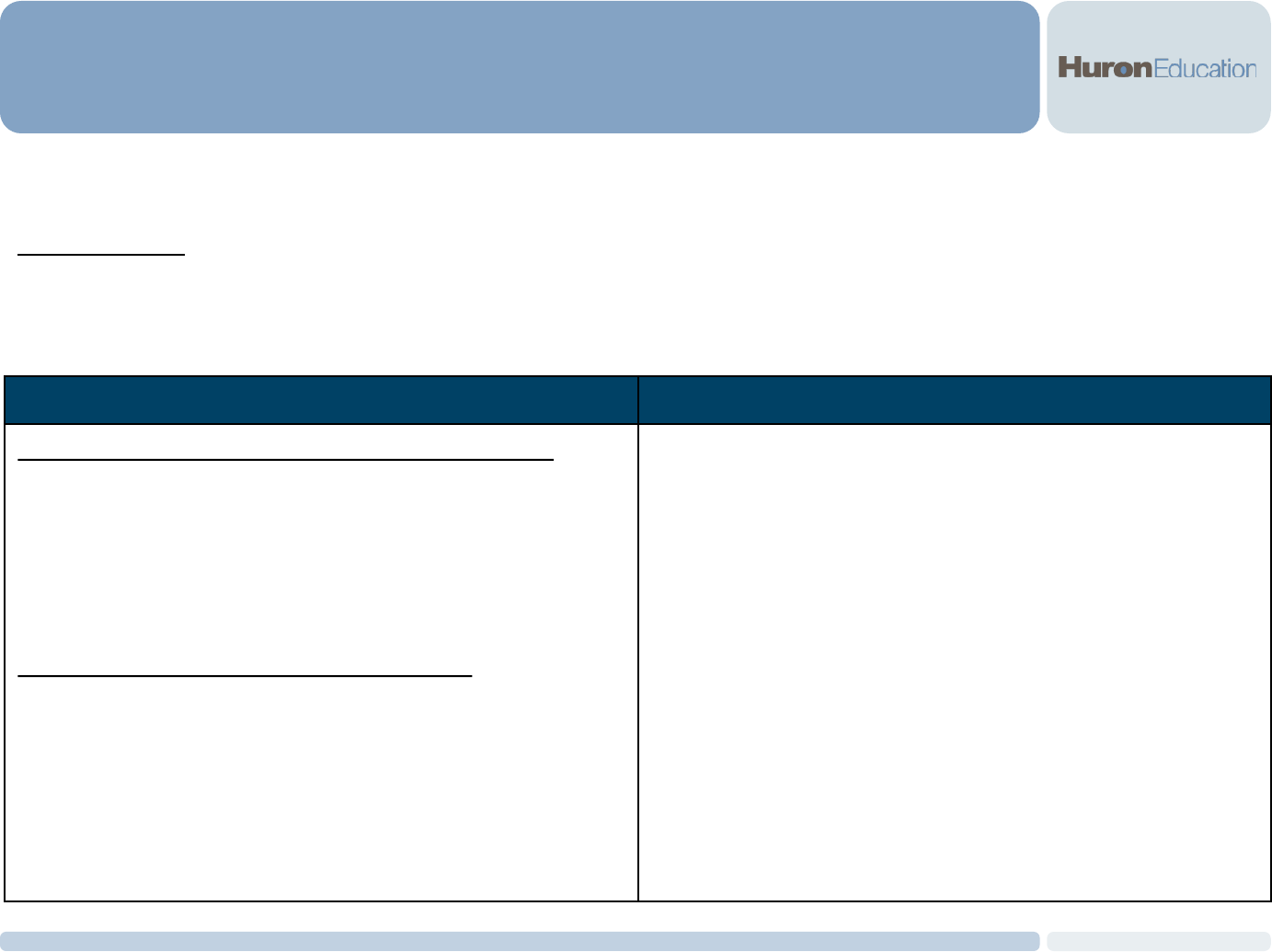
© 2015 Huron Consulting Group. All Rights Reserved. Proprietary & Confidential.
Business Case # 1
VENDOR MATURITY AND UWS READINESS
31
At this point in time, large-scale cloud-based SIS solutions are several years from mainstream adoption.
The UWS should utilize this timeframe to develop an approach to process and data standardization.
Vendor Maturity:
• Gartner predicted (2014) that SIS SaaS models are at least 5-10 years from widespread adoption
• Primary cloud-based vendors, Oracle Campus Solutions and Workday Student, are at least 2-3 years away from being fully
functional, cloud-based student lifecycle solutions – both currently building, testing, and rolling out modules
Examples of Standardization Effort Representatives
Examples of Data Coding Differences (Student Records):
• Basic student demographic information (e.g., gender,
ethnicity)
• Academic identifiers – taking courses at multiple institutions,
course completion / withdraw
• Coding of students (e.g., resident, distance education)
Examples of Institutional Process Differentiators:
• Academic calendars
• Registration timelines
• Posting of grades
• Student billing cycles
• Application of student aid packages (e.g., merit aid)
• Tracking student advising sessions
• How / where data are stored
System-wide standardization will require a sizeable effort from
UW staff across multiple units, including representatives from
each of the following areas:
• Faculty Representation
• Financial Aid
• Registrar
• Bursar
• Institutional Research
• Academic Advising
• Technical Staff
• Professional School and Distance Learning Programs –
tend to be more complex
• Standardization may require significant changes to current
campus business processes and operating culture
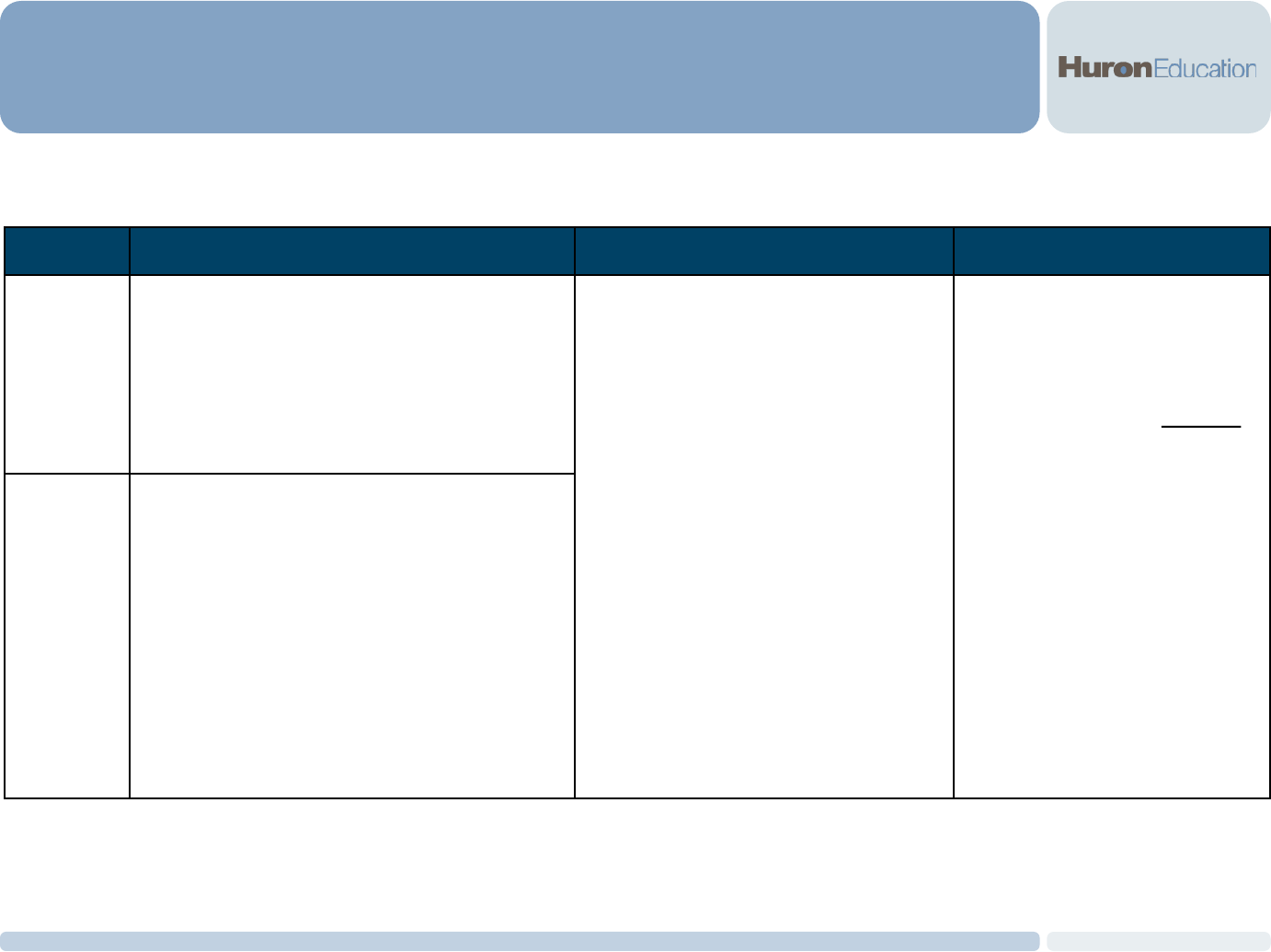
© 2015 Huron Consulting Group. All Rights Reserved. Proprietary & Confidential.
Business Case # 1
HRS & SFS OVERVIEW
32
The current HRS and SFS systems are at similar points with respect to centralization and support. Over the
next several years, both will be considered for upgrades.
System Current State Opportunity Reasoning
SFS
• Centrally hosted and supported at DoIT
and funded through CSRG
• Current version: 9.1
• Approximately 290 unique modifications
• Recently reduced number of instances
and back-up schedule to reduce costs
• Explore vendor managed
infrastructure (IaaS)
• Explore upgrade to PeopleSoft
9.2 and alternative infrastructure
hosting
• Refine and standardize business
processes and then explore
upgrade to cloud solution
• Upgrade decision will
likely be made in the next
few years
• IaaS model has potential
for reduced short-to-mid-
term costs while
processes are
standardized in
preparation for cloud
solution
• Upgrade to 9.2 or cloud
solution presents different
cost scenarios, timelines,
and impact to UW
business processes
HRS
• Centrally hosted and supported at DoIT
and funded through CSRG
• Current version 9.0
• System customizations are in part due
to state legislation and lack of
systematic IT governance
• Unique customization examples include
multiple TAMS, time clock, JEMS,
duplicated personnel systems (UPS)
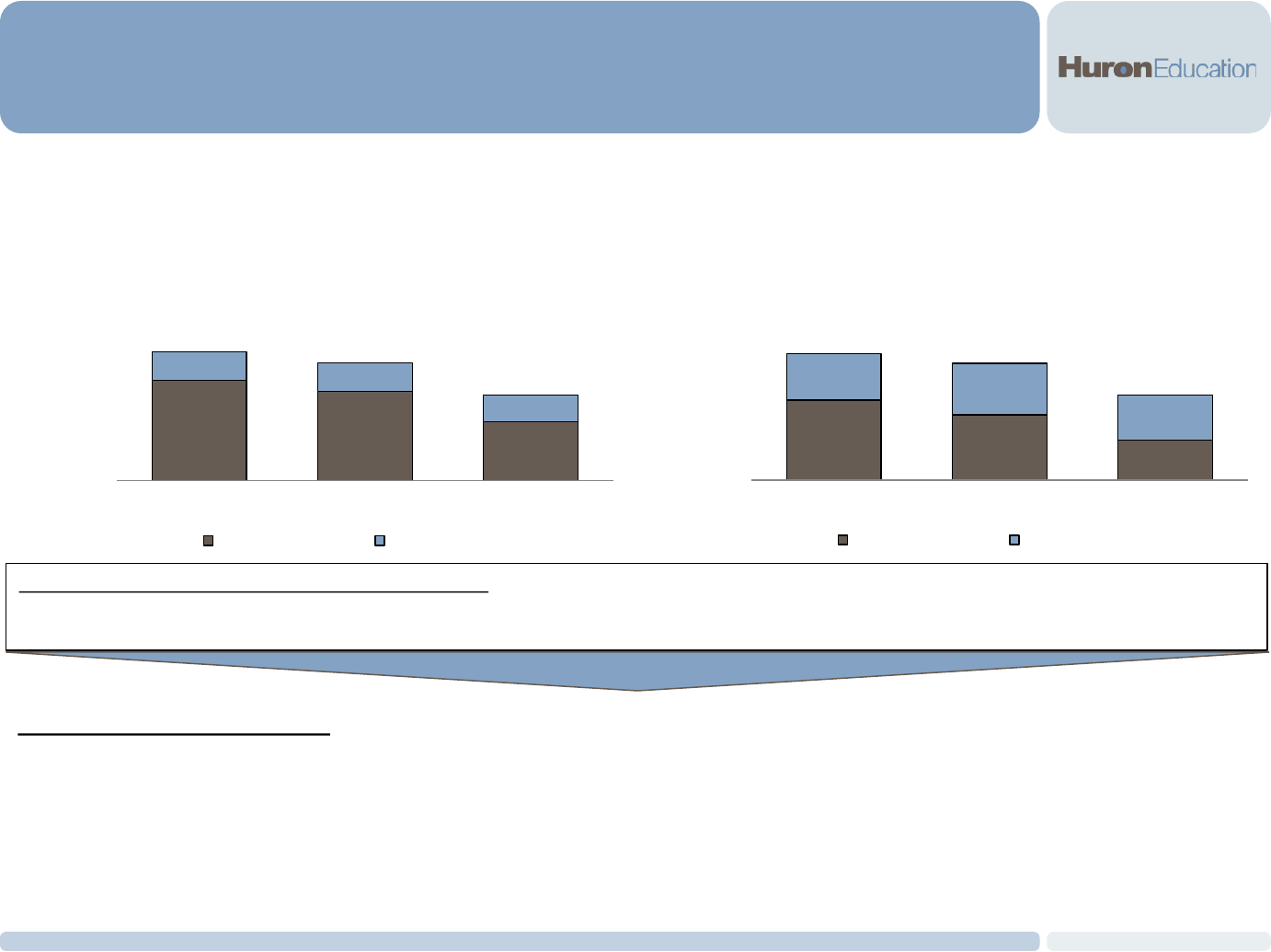
© 2015 Huron Consulting Group. All Rights Reserved. Proprietary & Confidential.
Business Case # 1
HRS & SFS OVERVIEW (CONT’D)
33
According to the Gartner Benchmarking Report completed for the UWS, infrastructure costs exceeded
those of identified peer institutions. The opportunity exists to evaluate annual infrastructure costs for each
system.
$-
$1,000,000
$2,000,000
$3,000,000
UWS System Peer Avg. Peer 25th
2014 Gartner Benchmarking Report
HRS Spend on Infrastructure
Compute - Midrange Storage
$-
$200,000
$400,000
$600,000
$800,000
$1,000,000
UWS System Peer Avg. Peer 25th
2014 Gartner Benchmarking Report
SFS Spend on Infrastructure
Compute - Midrange Storage
Gartner HRS and SFS Benchmarking Analysis:
• Range of annual potential savings for HRS and SFS infrastructure between $200k - $800k and between $60k - $262k to Peer
Avg. and Peer 25
th
(respectively)
Hosting Model Considerations:
• Review current state infrastructure support to identify where reductions can occur (e.g., number of instances, back-up
schedules, number of active projects)
• Engage with vendor to evaluate alternative hosting infrastructure costs to support instances requires increased focus on
vendor management and full analysis of operating infrastructure requirements

© 2015 Huron Consulting Group. All Rights Reserved. Proprietary & Confidential.
Business Case # 1
HRS & SFS OVERVIEW (CONT’D)
34
The UWS should address the underlying drivers of customizations, and overall costs prior to moving to
cloud-based solutions.
Reasoning: Inefficiencies exist that cannot be solved simply by implementing a cloud-based solution. Cloud-based
solutions provide the opportunity to standardize business processes that meet future-state business models.
• Lack of a formalized mechanism through which System-wide IT decisions can be made and the current model of
distributing the costs of customizations into the CSRG charges (across the board) means that requestors of
customizations or configurations may not fully understand implications / costs with requested customizations and
there is no group formally charged to review and approve/ deny requests
• Inefficient processes or one-off customizations are costly and cannot be solved by moving to a cloud-based
system
• Identification of future-state processes / users requirements (e.g., Establish minimum threshold to be
granted administrator access in HRS) can result in reduced costs under a pay-per-user structure
• Utilize a common approach to talent acquisition management systems
• Review of current policies will identify what is / is not operationally required – differentiate between
legislative requirements and UWS policy
• Reduce number of bolt-on / support applications system-wide
Short-term savings may be achieved through a vendor-hosted infrastructure, the UW should accelerate its strategy of
removing customizations to further reduce costs and to prepare for a potential transition to the cloud.

© 2015 Huron Consulting Group. All Rights Reserved. Proprietary & Confidential.
Business Case # 1
BUDGET SYSTEM CONSIDERATIONS
35
As Oracle and other companies are investing in the cloud and following a cloud-first mentality, the
University may consider a cloud-based option as part of its consideration for a new budget system.
On-Premise Hosted Model Cloud Based Model
Benefits
• Increased control over customizations and
configuration of system
• Greater control over system including data,
upgrade timing and cycles
• Fewer local IT resources needed to operate and
maintain system
• Quicker installations and upgrades
• Earlier access to system enhancements
• May be lower cost (depending on licensing
structure and number of users)
Considerations
• Large, complex universities / systems may
require unique hardware to maintain system
performance
• May require specialized technical staff (who are
hard to recruit and retain) to maintain and
operate system
• Some functionality not yet available on cloud
instances
• Upgrades happen on vendor’s schedule
• Data/system integration for custom / local
systems may be more difficult
Depending on the vendor selected, the University should consider cloud based options for a new budget system.
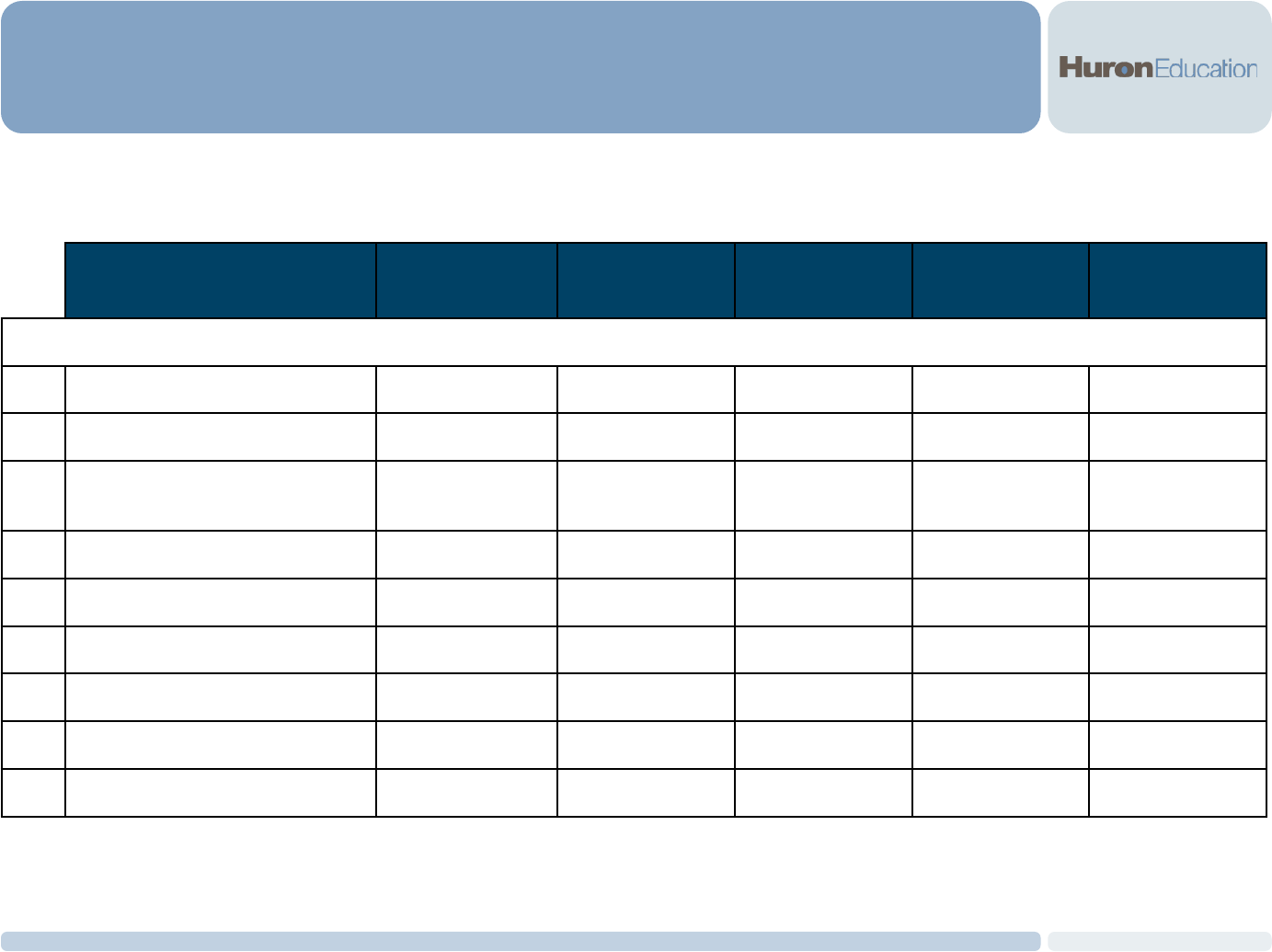
© 2015 Huron Consulting Group. All Rights Reserved. Proprietary & Confidential.
Business Case # 1
RECOMMENDATIONS
36
The UWS should take several steps over the next 36-48 months to achieve immediate cost reductions and
position the System to successfully transition to cloud based solutions as they mature.
Opportunity
Annual Est.
Savings
UWS Risk
Exposure
Efficiencies
Gained
Implementation
Complexity
Implementation
Timeframe
Business Case # 1
1
Consolidate hosting of SISs
$$$$
Medium Medium Medium 12-36 Months
2
Reduce customizations within SIS and
consolidate instances
Enabling Low High High 24-36 Months
3
Explore vendor
managed infrastructure and
rationalize current infrastructure for HRS
and SFS
$$$$
Medium Medium Medium 6-18 Months
4
Reduce customizations within HRS and
SFS
Enabling Low High High 36-60 Months
5
Develop
financial model allocating the costs
of customizations to requesting campus
Enabling Low High Low 0-6 Months
6
Develop a total cost of ownership model for
future customization requests
Enabling Low High Low 3-6 Months
7
Develop a System-
wide IT decision making
process and mechanism
Enabling Low High Low 6-12 Months
8
Include cloud option as part of vendor
system selection for Budget System
Strategic Investment Low High High 12-36 Months
9
Explore transition of non-ERP systems to
cloud solutions
TBD TBD TBD TBD TBD

Business Case #2:
Evaluate Alternative IT Administrative and Service
Delivery Models

© 2015 Huron Consulting Group. All Rights Reserved. Proprietary & Confidential.
38
CURRENT STATE IT ADMINISTRATION & SERVICE DELIVERY
Business Case #2
Each UW has built and supports localized information technology structures designed to meet the needs of
their institution, resulting in system-wide duplication and disparate operating models.
Overview:
• Aligned with the decentralized nature of the UWS, each campus has its own IT organization(s) providing a range
of similar services (e.g., Network and Infrastructure, Client Services, Enterprise Systems, Academic
Technologies) to similar constituencies (e.g., faculty, students, staff) supporting similar functions (e.g., teaching,
research, administration)
• Campus specific organization of IT activities varies greatly from campus to campus, reflective of the differences
in campus structure, culture, and operational norms
• Campus IT organizations and CIOs have engaged in a range of collaborative ventures (e.g., Disaster Recovery,
back-up support), though participation in these ventures is voluntary and they lack an overarching approach to
governance
Huron utilized the following guiding principles regarding the consolidation of IT services; cost reduction, mission
enablement, standardization, and service enhancement to constituents.

© 2015 Huron Consulting Group. All Rights Reserved. Proprietary & Confidential.
39
CURRENT STATE IT ADMINISTRATION & SERVICE DELIVERY
Business Case #2
The opportunity exists to systematically re-envision the way IT is administered and services are delivered.
In order to fully explore the concept of collaboration, we have structured and focused our thinking in two areas:
function-specific opportunities that are achievable within the current operating context and holistic opportunities that
would require a reimagining of the way IT services are delivered across the University of Wisconsin.
Function Specific Assessment:
Hypothesis: The UWS could lower cost, improve service, or a combination of the two by creating a cross-campus
capacity to support specific functions, including:
Holistic Approach:
Hypothesis: The UWS could add substantial capability and expertise without a significant increase in expenditure or
significant reduction to the administrative costs of Information Technology by organizing the provision of IT at a
“System” level.
• Training
• IT Security
• Helpdesk and IT Support
• IT Purchasing
• Research Computing
• Network Support /
Investments
• Datacenters

© 2015 Huron Consulting Group. All Rights Reserved. Proprietary & Confidential.
40
TYPES OF IT MODELS
Business Case #2
While there are nuances to operating models, there are two primary types that the UWS should consider -
consolidation of service-specific operations or a more holistic approach to IT.
Service
Higher
3 1
Same
2
Same Lower
Cost
3
1
2
1
3
2
IT Security
Help-desk
Data Center Consolidation, HPC

© 2015 Huron Consulting Group. All Rights Reserved. Proprietary & Confidential.
41
EXAMPLE 1: IT SECURITY
The opportunity exists to create a centralized team of UW IT security staff focused on developing,
implementing, and ensuring system-wide standards and technical controls are met.
Business Case # 2
Current State:
• 13 known UW contacts (headcount) related to IT security, some split time with other local responsibilities
• Not all campuses have financial resources or ability to attract / retain dedicated IT security staff
• System-wide UW Baseline for IT security has been developed over the previous two years, though it is
unclear if some or all campuses have met those standards at this time
• Disparate approach to IT standards, coupled with shared / common systems present potential systematic
vulnerabilities for individual campuses
Impetus for Change: Institutions are increasingly exposed to security threats:
• Auburn University publically exposed over 360,000 SSNs while replacing a broken server
• Penn State’s Engineering School exposed staff, student, and public/ private research partner information over a
period of two years because of a breach in the school’s computers
• Additional institutions recently impacted by security threats: Johns Hopkins, Carnegie Mellon, UC Berkeley, MIT,
University of Maryland, North Dakota University, Butler University, and Indiana University (among others)

© 2015 Huron Consulting Group. All Rights Reserved. Proprietary & Confidential.
42
EXAMPLE 1: IT SECURITY (CONT’D)
Transitioning to a IT Security team that is, perhaps geographically dispersed but with central reporting,
while complex, can provide the UWS with a standardized approach to IT security.
Business Case # 2
Challenges with transition:
• Lack of standardized IT functions system-wide result in disparate current state operations and standards
• Lack of an existing formalized governance mechanism to empower centralized security efforts (e.g., policy
development and enforcement)
• Centralized security team would require financial and staff resources from institutions:
o Institutional FTE resources to assist in centralization efforts, new policy development, and
implementation efforts (e.g., identification of localized current state)
o Funding to support centralized team and potential changes in current practices to meet system-wide
standards (e.g., changes in system configurations)
o Training of current staff on newly developed policies
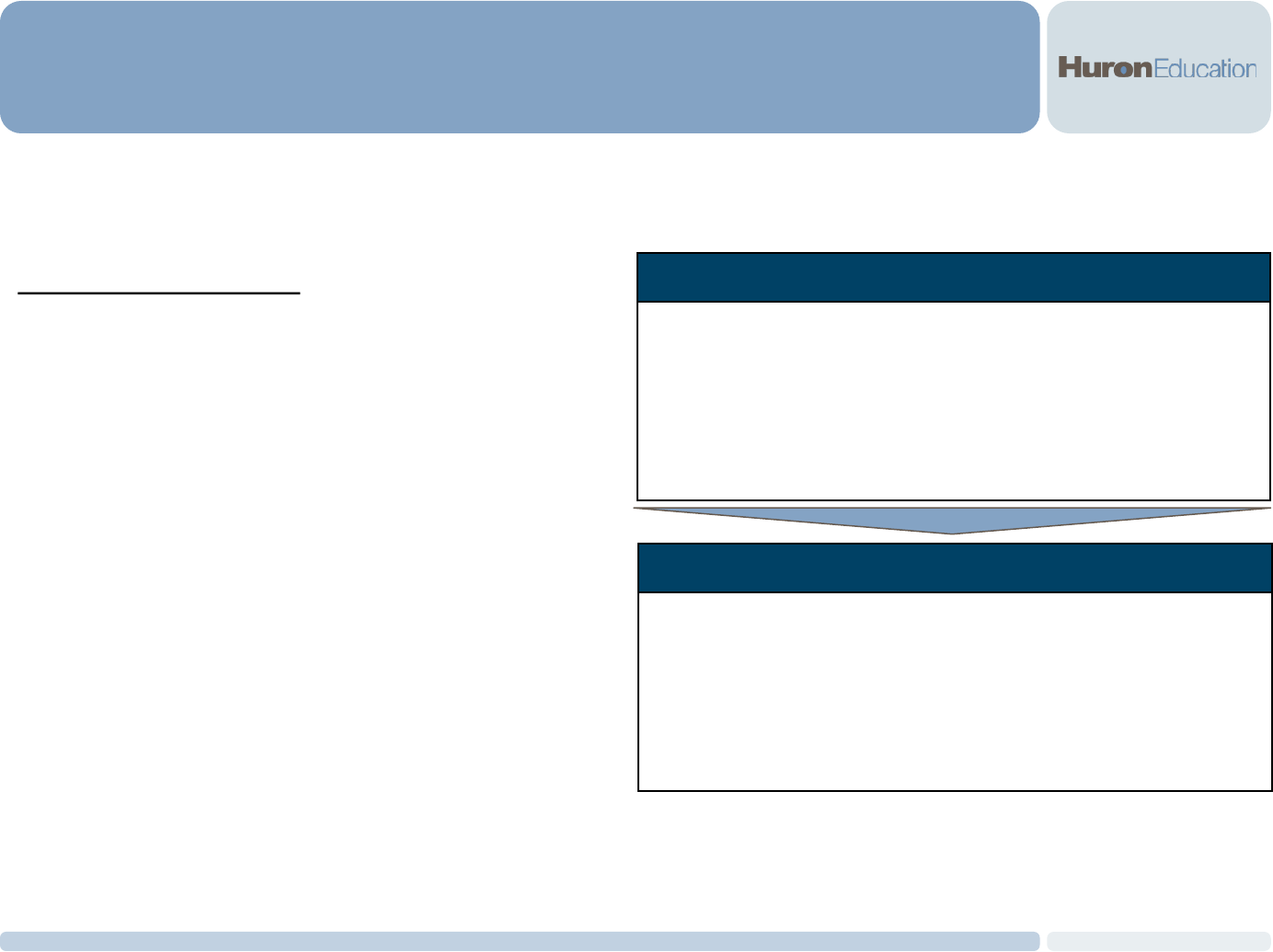
© 2015 Huron Consulting Group. All Rights Reserved. Proprietary & Confidential.
43
EXAMPLE 1: IT SECURITY (CONT’D)
The deployment of a centralized team should be considered as an enabler of a comprehensive and
systematic approach to developing and enforcing standards and risk mitigation strategies.
Business Case # 2
Impact of Consolidation:
• Standard approach to system-wide IT security
management and risk mitigation
• Standard technical auditing and accountability
standardized audit procedures, timing, review, etc.
• Consistent approach leads to reduced institutional
and systematic vulnerabilities
• Alignment of IT procurement and lifecycle
management with end-point risk
• Consistent data security and retention policies
Similar Example – UWSA Internal Audit
• UWSA recently centralized system auditors as a way to
provide increased consistency and a more formalized
approach to process review
• Chief Auditor reports directly to President Cross and the
Board of Regents – delegated authority to develop a
systematic, unbiased, approach to review
Benefits of Centralized IT Security Model
• Consistent, systematic approach and standards to IT
security
• Authority to assess, implement, and refine standards in an
expedited fashion
• Proactive and coordinated approach to meeting newly
established standards

© 2015 Huron Consulting Group. All Rights Reserved. Proprietary & Confidential.
Business Case # 2
EXAMPLE 2: HELPDESK (HD) OVERVIEW
44
Currently, each institution maintains centralized helpdesks for IT support. Madison and Milwaukee list
distributed IT support via locally managed helpdesk (e.g., college level).
*Data Assumptions:
• Does not include distributed Helpdesk staff – number of distributed helpdesks not fully known. Madison and Milwaukee list distributed help desks for certain colleges / schools
• Institutional FTE defined as FTE Faculty, FTE Staff, or FTE Student
• Aggregate ticket information uses most recent complete year as provided by CIOs or publically available information on websites.
• Central HD Ticket information not available for Eau Claire, Oshkosh, or Colleges / Extension – an estimation was made by multiplying the average known (Ticket/Inst. FTE) by the number of institutional FTE
Helpdesk Overview (System-wide)
• 20 known centrally managed helpdesks – Madison and Milwaukee list distributed IT support (e.g., respective Colleges)
• Approximately 339,000 total centralized HD tickets received ranging from basic inquiries through more resource intensive
application support
• Disparate data tracking utilized system-wide resulting in inconsistent data availability – no consistent metric tracking
• Multiple instances and types of ticket management systems and virtual self-service knowledge management documents.
Institutions do collaborate with respect to knowledge bases (e.g., UW Milwaukee utilizes UW Madison’s knowledge base)
• Institutional operating hours vary - most adjust hours for fall/spring/summer terms
• Institutions are utilizing student workers to encourage career development, retention, etc.
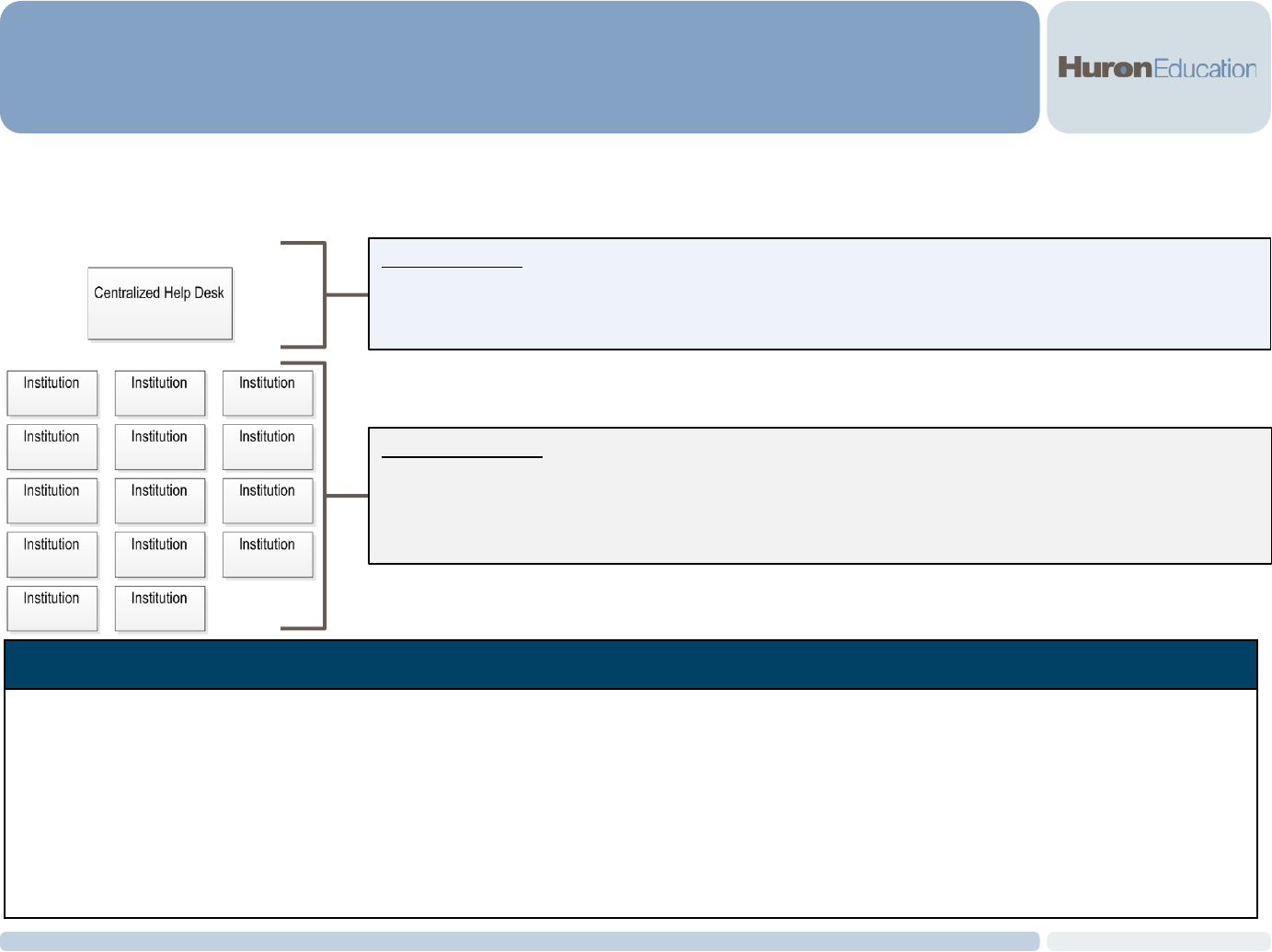
© 2015 Huron Consulting Group. All Rights Reserved. Proprietary & Confidential.
45
EXAMPLE 2: CONCEPTUAL FUTURE STATE HD MODEL
A hub-and-spoke model for helpdesk delivery will require additional analysis, planning, and potential
investment to ensure a seamless transition and uninterrupted service provided to staff and students.
Business Case # 2
Central Helpdesk:
• Highly trained “generalist” and tier-2 staff respond to all incoming tickets, or route calls appropriately to
institutional level (e.g., desktop / classroom support)
• Utilizes a routing resolution priority whereby the most serious issues are prioritized using a single ticketing system
Distributed Support:
• “On-the-ground” staff and students assist with physical desktop support, laptop re-imaging, classroom set-up, etc.
• Promotes the increased use of student workers which can lower operating costs while contributing to student
success and retention (e.g., financial, career building)
• Distance learning faculty and students likely not significantly impacted by change in operations
Change Components
• Disparate knowledge management / virtual self-service systems will need to be consolidated
• Requires the development of unified processes and standardized escalation procedures
• Requires development of system-wide Service Level Agreement
• Constituent change management efforts to new processes
• Development of a formalized training program for all student workers
• Future-state FTE distribution – some institutions may require additional on-site staff to meet institutional policies (e.g., Stout
with student laptop program)

© 2015 Huron Consulting Group. All Rights Reserved. Proprietary & Confidential.
46
EXAMPLE 2: FUTURE-STATE HELPDESK BENEFITS AND CONSIDERATIONS
Centralizing helpdesk activities provides for increased standardization of service provided, the ability to
monitor metrics and demonstrate accountability to stakeholders, and support a growing "bring your own
device" trend.
Business Case # 2
Benefits Considerations
• Consistent ticket tracking and reportable system-wide
metrics
• Consistent, systematic approach to constituent support
(e.g., response times, escalation procedures, follow-up,
etc.)
• Enables the standardization of technologies supported
• Increased use of students can further reduce overall costs
while maintaining consistent levels of service – ability to
scale up / down during academic and summer terms
• Requires change management efforts to coach
stakeholders on new process
• Requires highly trained centralized staff versed in multiple
applications and devices
• May require standardization of applications, hardware, etc.
supported
• UWS can choose to outsource “after-hours” ticketing
management to third-party vendor – requires additional
analysis
Ex: Helpdesk / Desktop Support Consolidation Comments
Institutional Example: University of Minnesota
• Evaluated current Helpdesk and desktop support staffing
(collegiate and non-collegiate) – operated 72 separate
helpdesks
• Identified an annual range of savings / staff re-allocation of
$7.3 - $9.1 million
• Transition to consolidated future-state is still in progress –
achieved annual savings of approximately $2.3 million
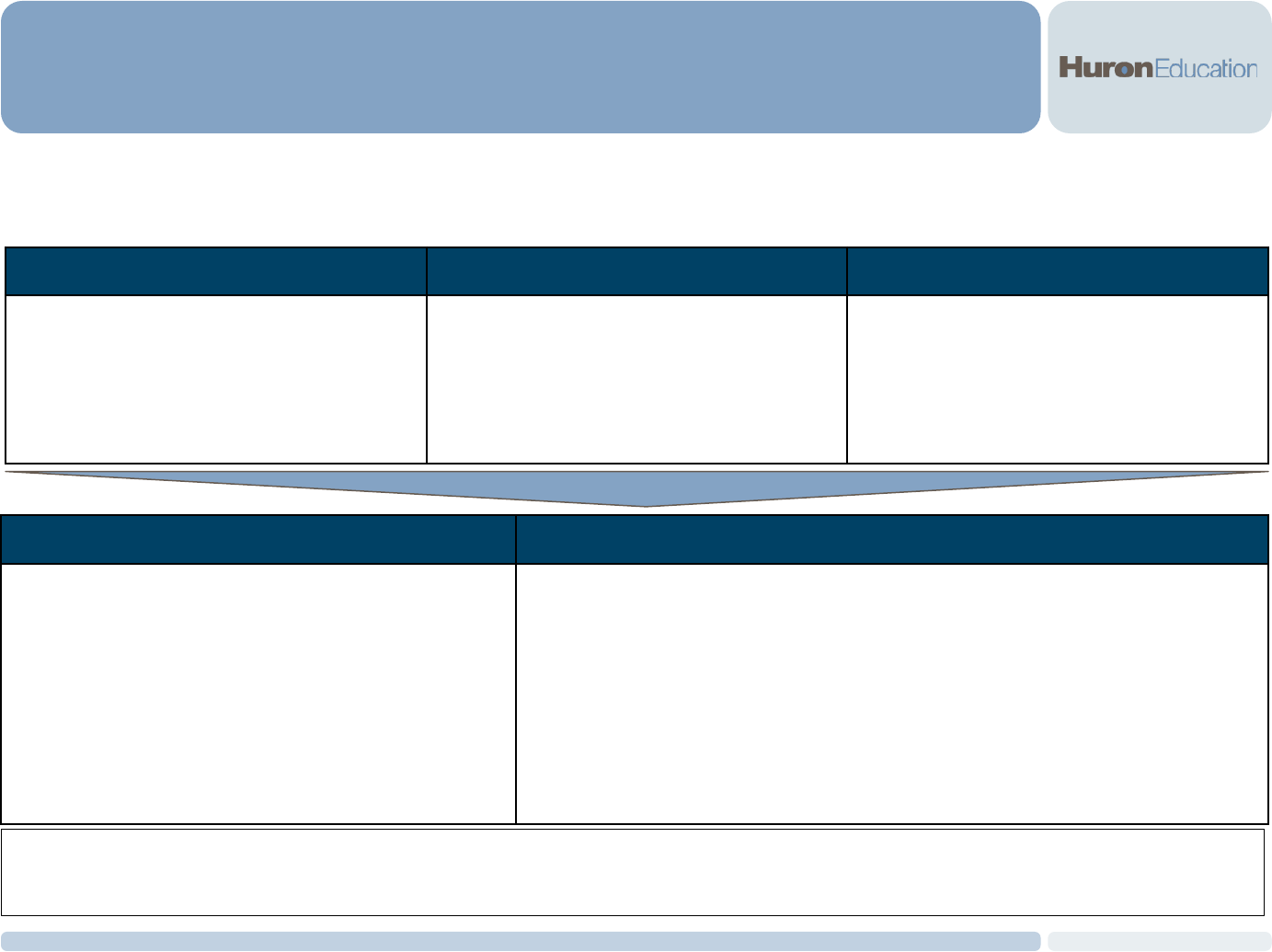
© 2015 Huron Consulting Group. All Rights Reserved. Proprietary & Confidential.
47
EXAMPLE 3: CENTRALIZED HIGH PERFORMANCE COMPUTING (HPC)
The opportunity exists to develop a policy that centralizes research computing and enables all institutional
faculty, researchers, and students to provision computing resources upon request.
Business Case # 2
Examples of Shared HPC Computing Comments
Multi-Institutional Example: POD IU
• High performance computing cluster available for on-demand use by any
domestic or foreign researchers associated with institutions of higher
education, federally funded R&D center, or other federal / state entities
• Collaborative effort among Indiana University, UVA, UC Berkeley, and U.
Michigan and Penguin Computing
• Utilizes a “pay-as-you-go” pricing model with same configurations as
existing government supercomputers cost effective solution to access
compute resources
Examples of HPC Across UW Considerations for Centralization System-wide Mission Enablement
• UW Madison
• UW Milwaukee
• UW La Crosse
• UW Eau Claire
• Some institutions use XSEDE
• Implementation should coincide with
UW Institutions grant funded HPC
cycles
• Leverage existing dedicated
infrastructure
• Provide access to cutting-edge
computing resources to all UW
faculty, researchers, and students
• Utilize a pay-as-you-use cost
recovery model
Huron recommends further analysis regarding realizing scale of existing shared system research / high performance
computing investments and the development of an implementation timeline that incorporates technology refresh cycles.

© 2015 Huron Consulting Group. All Rights Reserved. Proprietary & Confidential.
48
EXAMPLE 4: CONSOLIDATE SYSTEM-WIDE DATACENTERS / SERVER FACILITIES
Currently, each institution maintains their own respective datacenter(s). The opportunity exists to explore
the consolidation of system-wide data-centers and server facilities, resulting in achieved economies of
scale.
Business Case # 2
*Data received was either not explicit in naming number of datacenters or was inconclusive based on wording. Some institutions did not provide data resulting in estimation of a minimum of one datacenter / institution.
Anticipated Approach / Data Issues Known Information
• Assess current inventory of datacenter / server facility
equipment, policies, procedures, usage statistics, operating
costs, space, etc.
• Review level of virtualization and identify estimated near-
term savings by increased virtualization
• Identify estimated savings by co-location / consolidated
facilities and potential cost avoidance
Available data was either inconsistent or not provided at all.
Huron was not provided with UW Whitewater survey.
• Estimated number of “centrally” managed datacenters is 22*
• Limited current server, data center/ facility inventory, etc. –
some institutions provided detailed server information others
did not participate
• Generally, institutions indicated they have or plan to engage
in server virtualization (Centrally)
• Distributed / departmental level datacenters / server
facilities is unknown, though UW Madison estimates their
number to be approximately 96
• UW Madison initially estimated a 5-year savings of ~$6.8
million, primarily by co-locating data centers / server
facilities
• UW Stout’s strategic plan highlights institutional datacenter
consolidation as a priority
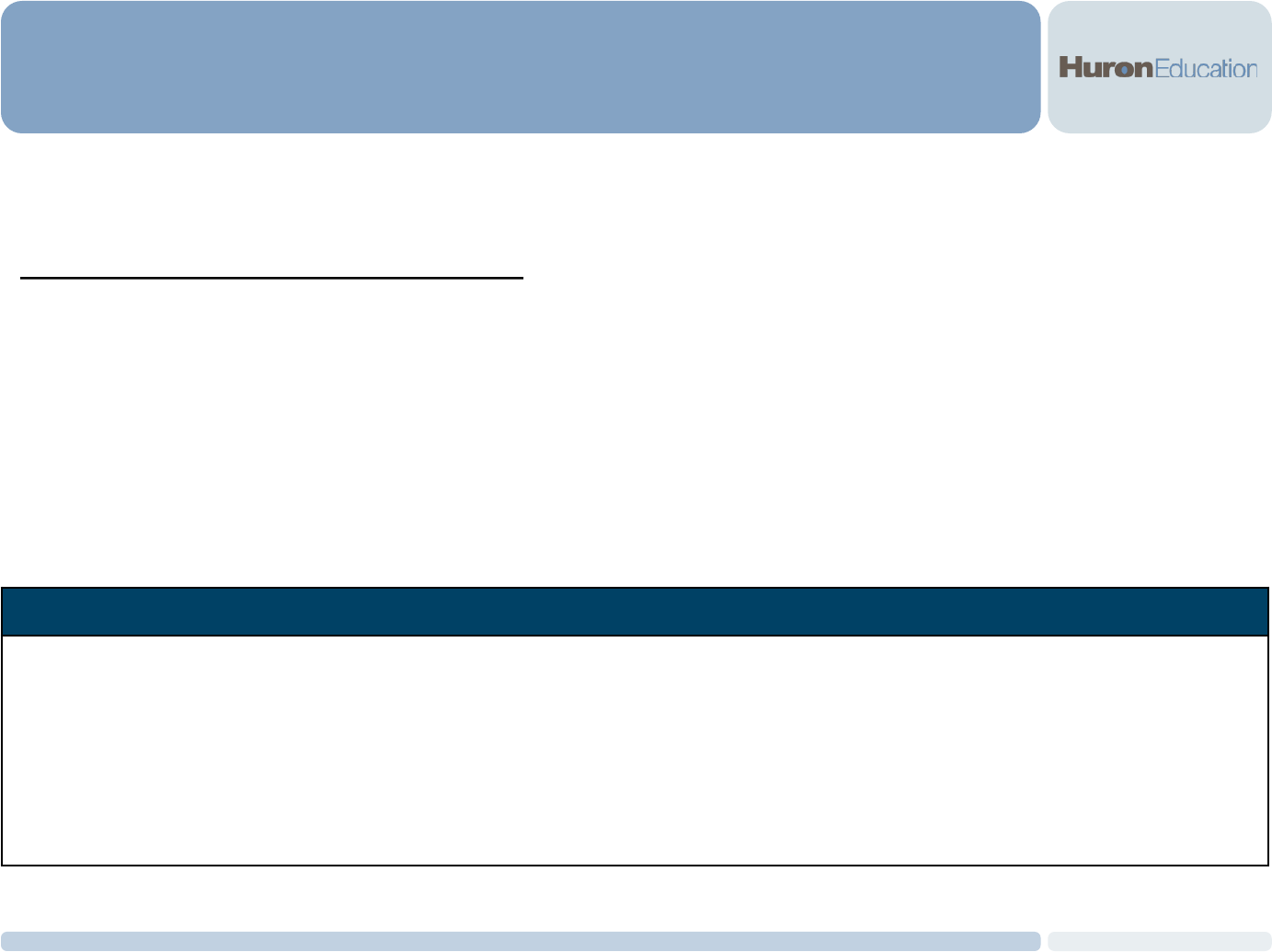
© 2015 Huron Consulting Group. All Rights Reserved. Proprietary & Confidential.
49
EXAMPLE 4: CONSOLIDATE SYSTEM-WIDE DATACENTERS (CONT’D)
The consolidation of UW datacenters would be a complex initiative spanning several years of planning,
rationalization, and migration efforts.
Business Case # 2
*Data received was either not explicit in naming number of datacenters or was inconclusive based on wording. Some institutions did not provide data resulting in estimation of a minimum of one datacenter / institution.
Representative Example: New York State & SUNY
• In 2013, Governor Cuomo announced the consolidation of 50 New York State Datacenters and server rooms spanning 140,000
square feet into one location at SUNY College of Nanoscale Science and Engineering
• Currently engaged in increased server virtualization, physical co-location, and a systematic review of current applications to
reduce amount of storage and compute resources required
• Consolidated datacenter is a 50,000 square foot tier 3 facility promising 99.982% availability
• Estimated $1 billion in savings over 20 years (~$50 million per year)
• Effort is part of an overall consolidation effort by the state of New York to realize IT savings estimated to be $100 million / year
Consolidation Complexities & Components:
• Comprehensive inventory of current infrastructure
• Comprehensive understanding of Tier 1, 2, and 3 applications
• Identification of future-state infrastructure needs
• Identification of future-state datacenter locations
• Identification of project funding and future-state budget model for operation
• System-wide disaster recovery plan
• Development of a institutional data and application migration plan migrate institutions gradually
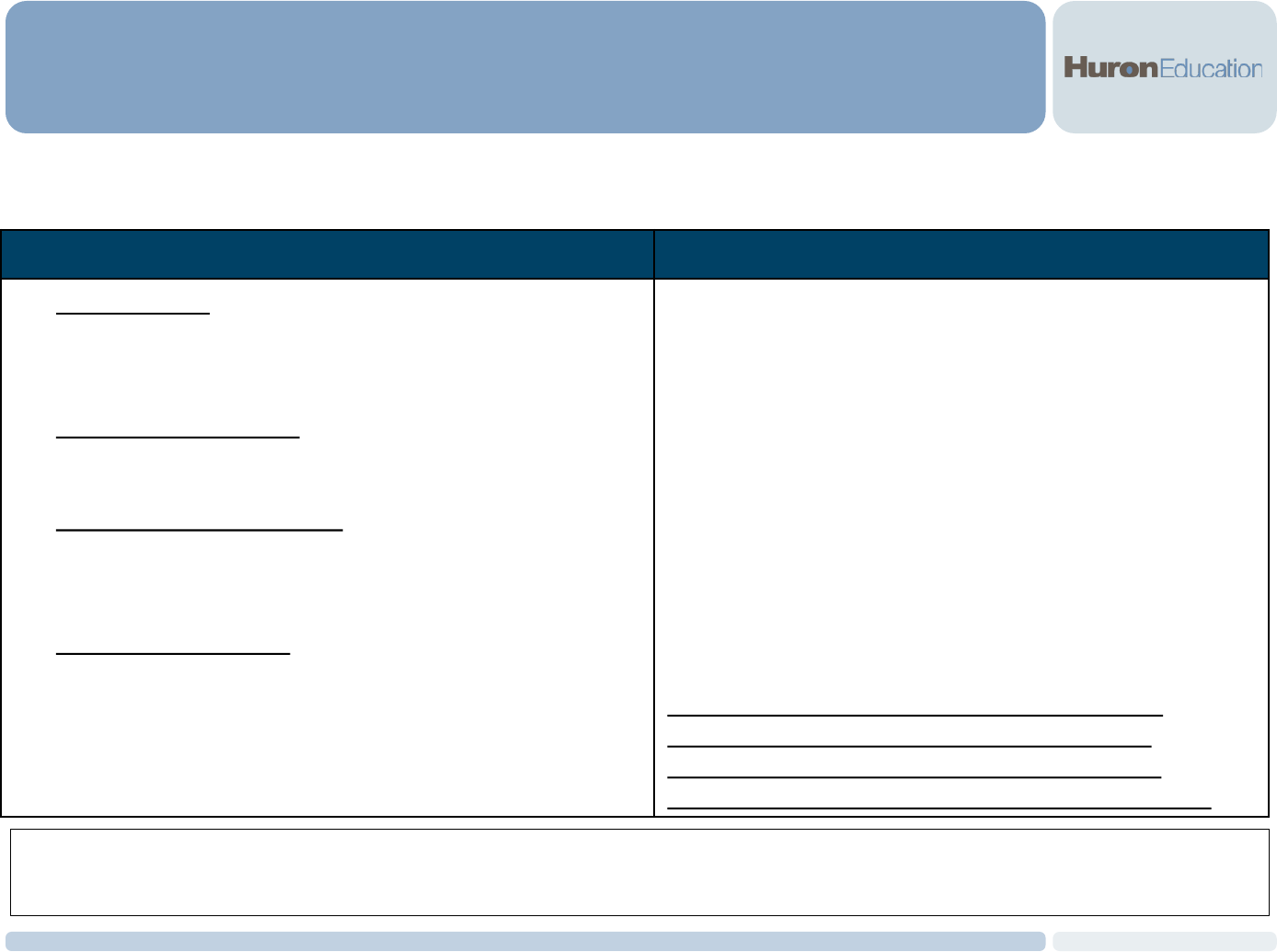
© 2015 Huron Consulting Group. All Rights Reserved. Proprietary & Confidential.
50
EXAMPLE 4: CONSOLIDATING SYSTEM-WIDE DATACENTERS (CONT’D)
Huron recommends that further analyses be conducted to identify the full extent of the opportunity,
including a systematic data collection and evaluation process to understand the true current state.
Business Case # 2
UW Madison anticipates saving ~$7M over 5 years through the consolidation of its data centers and server facilities;
based on the scale and scope of computing across the System, Huron anticipates that number to increase for a
coordinated UW-wide effort.
Benefits of Data Center Consolidation Data Required for Comprehensive Analysis
• Reduced Costs: Reduced network and application
infrastructure results in lower hardware costs, energy
consumption, space requirements, and avoidance in capital
expenditures.
• Increased Control for IT: Simplified architecture and the
ability to deploy management strategies and protocols
designed to maximize bandwidth utilization and performance
• Reduced Scope of Security: Reduced number of sites leads
to a standardized approach to physical center management.
Similarly, reduced centers leads to more consistent disaster
recovery planning, implementation, and execution of solutions.
• Improved Compliance: Promotes process and system
automation (reducing staff involvement) and aligns procedures
and functions with policies, regulations, standards, and
service metrics. Additionally, it encourages comprehensive
auditing and demonstration of operational compliance.
• System-wide inventory of:
o Centralized and de-centralized datacenter and
server facilities, PUE analysis, level of server
virtualization / utilization, and total current state
operating costs
o Plans to reduce level of hosted applications (e.g.,
SIS centralization reduces localized infrastructure)
o Planned or anticipated capital expenditures for
servers, equipment, and facilities
o Future state compute and storage requirements
o Development of a system-wide master plan to
realize facilities savings over the next 10 years
Consolidation efforts can be achieved by two primary
methods; 1) consolidate current infrastructure into 3
regionalized datacenters (e.g., Geographically), or 2)
outsource to a vendor managed provider (e.g., AWS, IBM)

© 2015 Huron Consulting Group. All Rights Reserved. Proprietary & Confidential.
51
HOLISTIC APPROACH: REORGANIZE INFORMATION TECHNOLOGY DELIVERY
The UW has the opportunity to significantly increase service and/or reduce costs by reorganizing the
provisioning and administration of IT at a “System” level.
Business Case # 2
Considerations:
• Current model of a campus-centric service model creates significant redundancy in activities and services
across the System
• Alternative models seeking to organize IT services at a different level (e.g., regional, campus profile) are without
precedent at the University of Wisconsin and run counter to the prevailing organizational cultures
• Alternative models present significant opportunities to increase service and / or reduce costs; these benefits
should be considered in the context of the changes to institutional control, challenges with culture, and
institutional strategies
Decision: Huron does not believe this to be a binary (yes/no) decision. Ultimately, careful consideration
should be given to the following decision components:
• Mix (and location) of leadership / management – how will governing group be selected?
•
Services provisioned – what will this group be responsible for?
• Financial impact – how will budgets / investment priorities be established?
• Changes in risk profile - how does re-organization impact institutional / system risk?
• Changes to control – how will re-organized decision-making be managed and enforced?
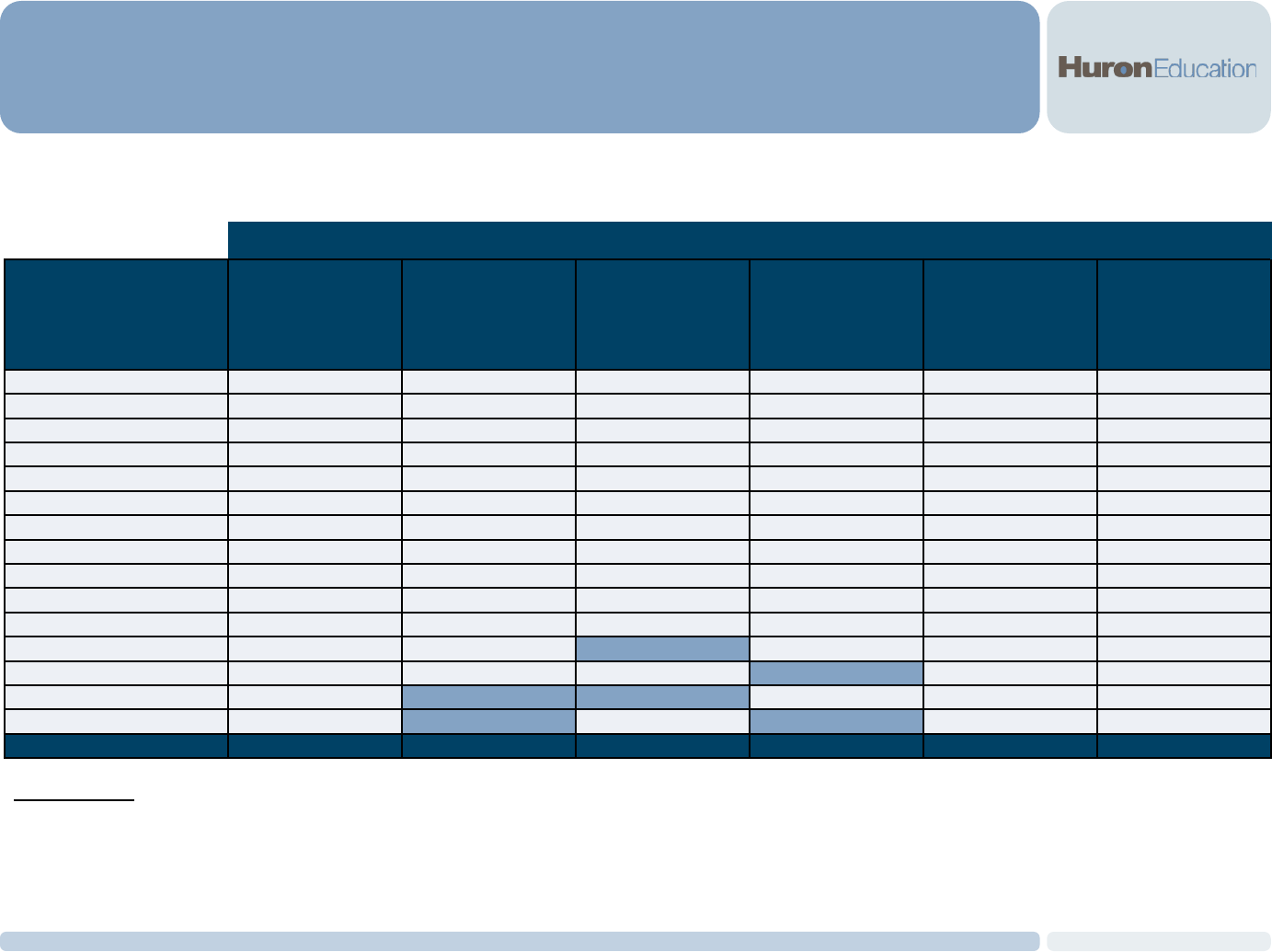
© 2015 Huron Consulting Group. All Rights Reserved. Proprietary & Confidential.
52
REORGANIZE INFORMATION TECHNOLOGY DELIVERY
Although differences exist in scope, diversity, and scale of institutional-specific IT, institutional based CIOs
have significant commonality in organization and service provision.
Business Case # 2
Estimated FTEs / IT Unit
Institution Client Services
Network &
Infrastructure
Services
Enterprise
Software &
Application
Services
Instructional
Technology
Services
Administration/
Finance/ Other
Est. Total FTEs
Eau Claire
13.8 13.0 15.9 10.9 1.0 54.6
Extension / Colleges
4.0 18.7 1.0 6.0 11.0 40.7
Green Bay
7.0 4.0 9.6 12.0 4.0 36.6
La Crosse
13.0 10.0 5.0 8.0 2.0 38.0
Milwaukee
25.0 39.0 16.8 8.0 7.0 95.8
Madison
67.5 204.2 90.7 75.6 25.8 463.8
Oshkosh
12.0 7.0 9.0 13.5 3.0 44.5
Parkside
4.0 3.0 5.0 5.0 8.0 25.0
Platteville
12.0 12.0 12.0 7.0 2.0 45.0
River Falls
4.0 13.0 10.0 2.0 2.0 31.0
Stout
9.0 9.0 7.5 10.0 4.0 39.5
Stevens Point
24.8 10.0 2.0 10.0 46.8
Superior
5.0 6.0 6.0 0.8 17.8
Whitewater
2.0 4.0 33.0 39.0
UWSA
1.0 13.0 3.0 17.0
Total
204.1 348.9 201.5 164.0 116.6 1,035.1
Assumptions:
• Categorized staff based on available organizational charts, public website information, or position descriptions within HR provided file. Description of
categorization can be found in the appendix
• Positions not clearly marked or aligned to a single category placed in Administration/ Finance/ Other category
• Source: HR Personnel file received from UWSA, does not include distributed IT staff

© 2015 Huron Consulting Group. All Rights Reserved. Proprietary & Confidential.
53
REORGANIZE INFORMATION TECHNOLOGY DELIVERY
In order to successfully transition to a System-wide model for the provision and leadership of IT services,
the UWS would have to develop enhanced capabilities to support a new model.
Business Case # 2
Required Core Capabilities:
1. A mechanism through which the System could make decisions regarding IT priorities, budgets, service models,
and service levels – currently, decision-making is institutionally focused
• Campus leadership collectively should consider what technology is truly unique to campus strategic
priorities and rationalize IT Services accordingly
2. Improved data environment, enhanced reporting, and performance measurement – currently, data are not
readily available or fully understood resulting in the inability to inform decision-making
3. Articulation of the value added to faculty, institutional leadership, and the System of new IT-related roles both
on-campus and at the system level

© 2015 Huron Consulting Group. All Rights Reserved. Proprietary & Confidential.
54
DECISION MAKING
The University of Wisconsin has few System-wide mechanisms through which opportunities can be
evaluated and decisions made as a “system.”
Business Case # 2
Common Systems Review Group (CSRG), comprised of IT, academic, and administrative leadership, is one of the
few examples of System-wide IT decision making (though the reality is that only approximately 4% of the CSRG
budget is uncommitted per year and there are far more projects requesting funding than there is funding available).
To be successful, any new model will need to expand the remit of a group like CSRG.
Required Capabilities & Authority:
• Develop shared solutions
• Evaluate opportunities to transition campus based activities to “scale”
• Decide on service levels and functionality of shared systems
• Ensure IT services are aligned with budgets and campus requirements.
Changes to IT funding may include:
• Pay overhead costs for central IT out of a central fund and charge institutions on a direct or marginal basis
• Provide select IT services without a charge to institutions
The University of Wisconsin should empower the CSRG (or a variant) to expand it’s remit to include the development of a
capacity to make broader cross-campus IT decisions and to provide oversight of any System-wide services.
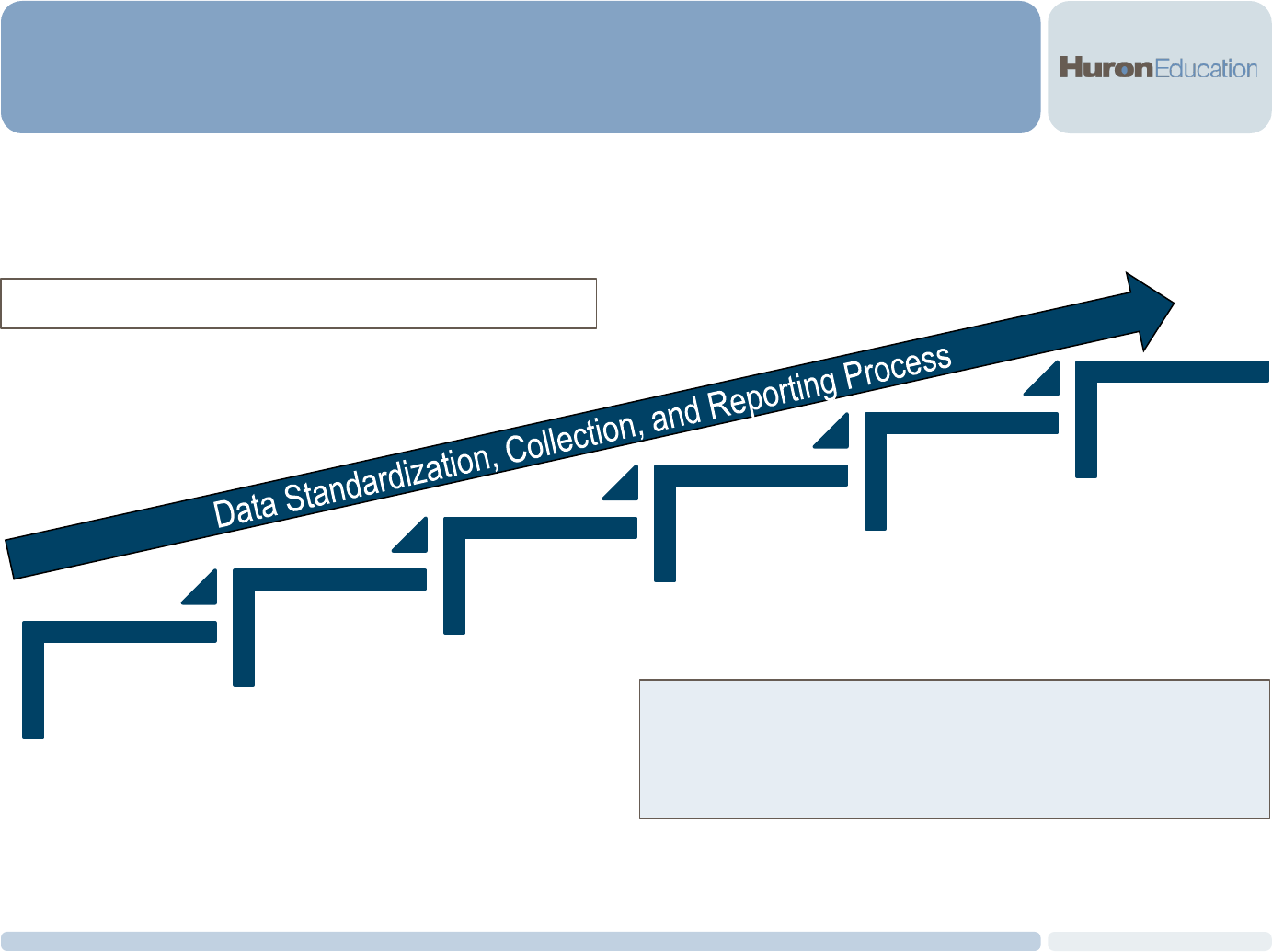
© 2015 Huron Consulting Group. All Rights Reserved. Proprietary & Confidential.
55
SYSTEM-WIDE CAPABILITIES
The current campus-centric model means that the data that comprise IT investment are distributed
throughout the organization, limiting the ability for effective system-wide decision making.
Business Case # 2
Establish
authority of
CSRG (or
similar group)
Identify
reporting
needs
Document
required data
elements
Establish
common data
definitions
Develop data
collection tool
Collect data
(iterative)
Illustrative – for discussion purposes only
IT Data is not readily available or fully known through-out the
system. Creating a standard process for data collection and
reporting will increase transparency and provide for more
informed decision making

© 2015 Huron Consulting Group. All Rights Reserved. Proprietary & Confidential.
56
RE-ENVISIONING THE ROLES OF CAMPUS-BASED IT SERVICES
If we consciously ignored the traditional boundaries of institutions and pushed our thinking beyond the
current state, we believe the UW could serve campus-based IT needs through a regional CIO model.
Business Case # 2
Changing Role of the CIO:
• Shift from “technology – oriented” focus to “business – oriented” strategic partner
• Highly adaptable to rapidly changing IT landscape
• Focused on global security
• Driver of process innovation and improvement
• Shift from asset managers to service managers (e.g., cloud computing)
To successfully transition the role of the UW CIOs and allow them to focus on more strategic and value-add initiatives, IT
services will need to be administered and provisioned differently than they currently are.
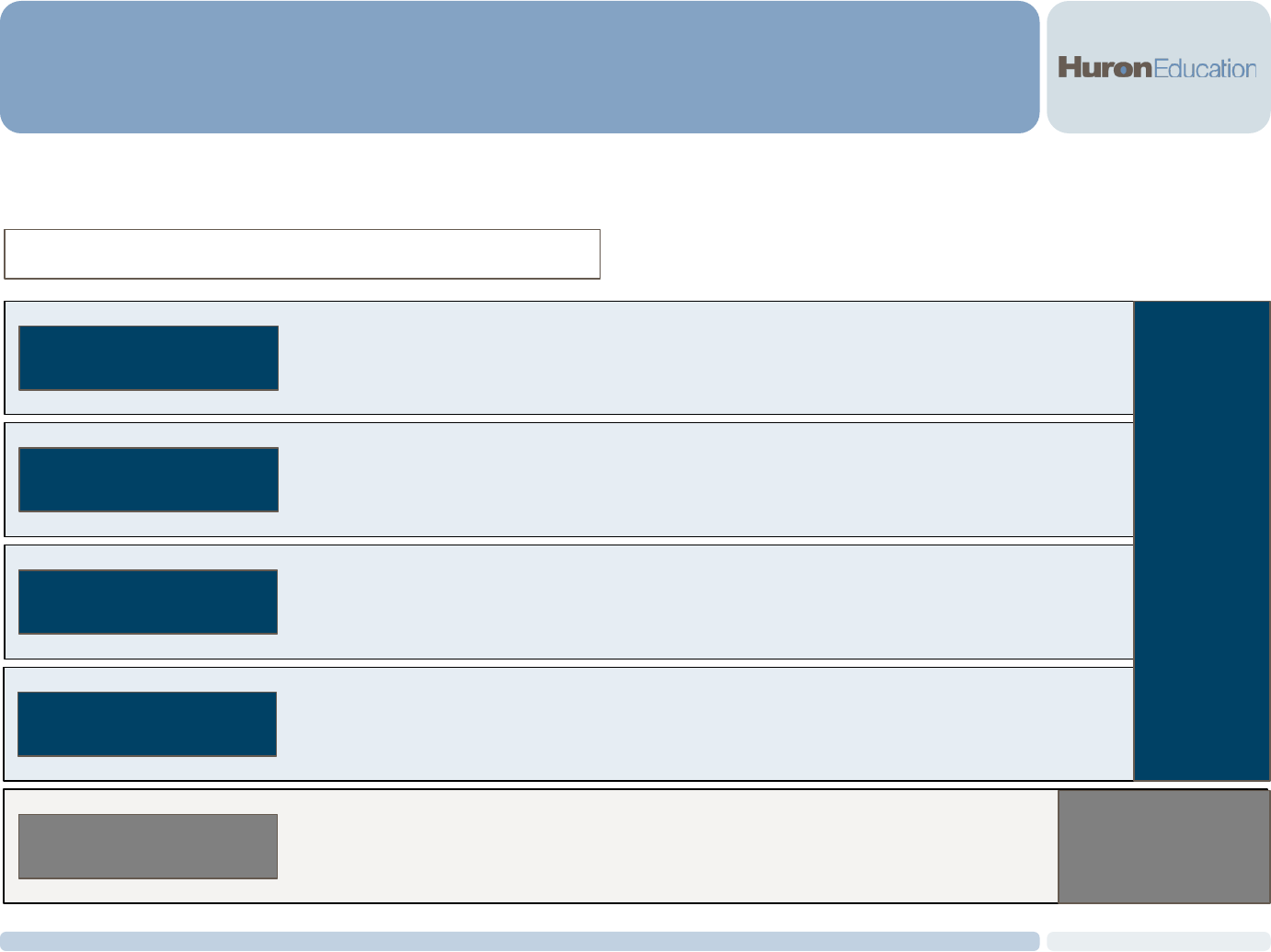
© 2015 Huron Consulting Group. All Rights Reserved. Proprietary & Confidential.
57
RE-ENVISIONING THE ROLE OF CAMPUS-BASED IT SERVICES
If campuses were able to procure more IT services from UW System, the time and attention of CIOs could
shift from operational to strategic. Creating individual specializations would extend the services offered.
Business Case # 2
Illustrative – for discussion purposes only
IT Operations
Responsible for
• Operating (service level and P&L responsive) enterprise-scale applications and services
• Network architecture and maintenance
• Managing vendor relationships
Implementation
Responsible for
• Scaling new technology
• Overseeing management of all IT “projects”
Risk
Responsible for
• Establishing system-wide risk management infrastructure
• Advising institutions where resources don’t exist
• Working with institution-specific resources (where available)
Digital Officer(s)
Responsible for
• Becoming “trusted strategic” and digital leaders on-campus IT
• Supporting institution-specific teaching and learning technology
• Supporting institution-specific strategic planning
Data
Responsible for
• Establishing and maintaining system-wide data governance
• Managing core data inventory
• Working with institution-specific resources (where available)
System-wide Responsibility
Campus-based
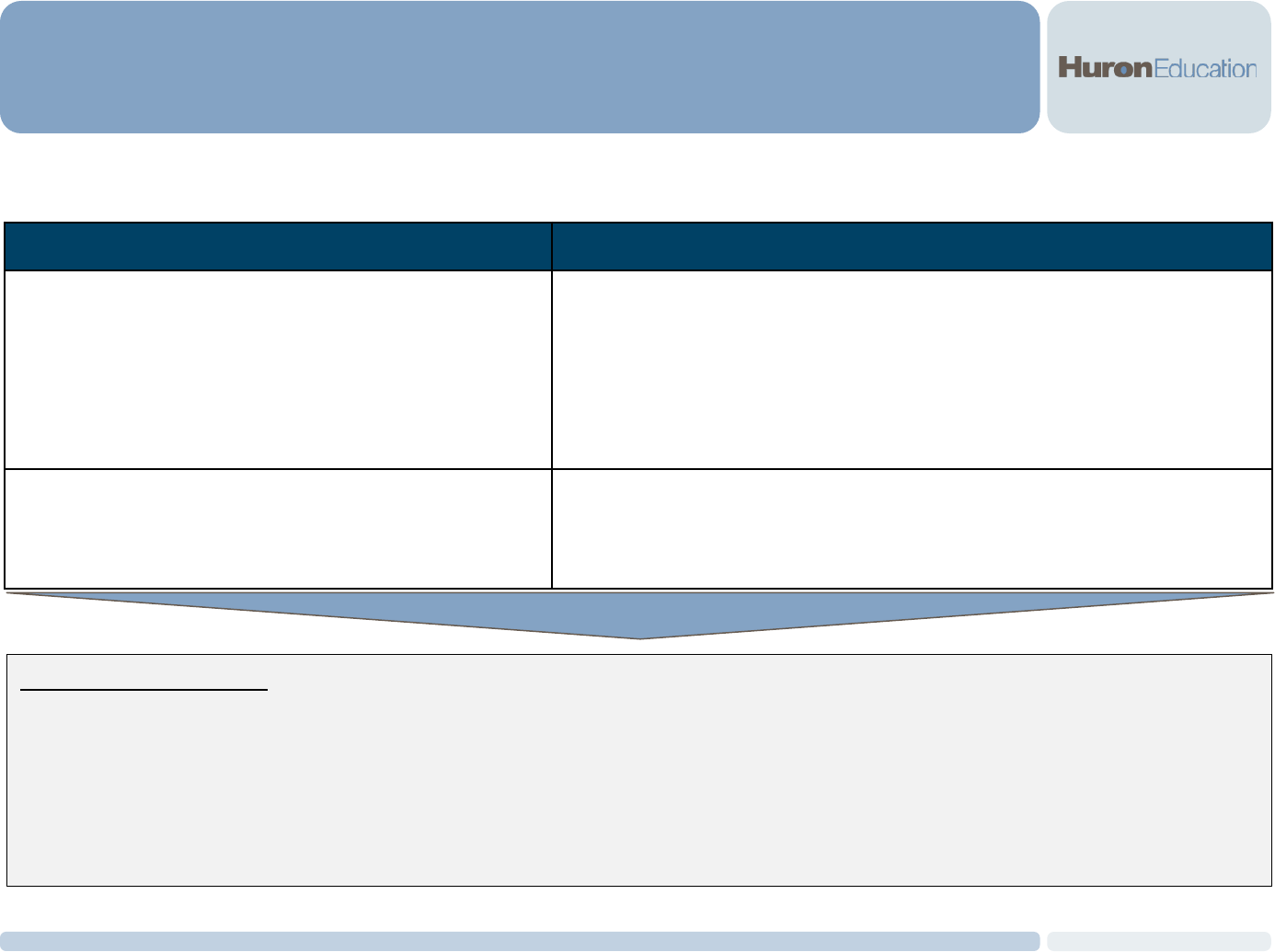
© 2015 Huron Consulting Group. All Rights Reserved. Proprietary & Confidential.
58
POTENTIAL FUTURE-STATE SYSTEM-WIDE IT ADMINISTRATION MODEL (CONT’D)
Business Case # 2
Leadership Component Proposed Role / Governance
System-wide IT Governance Group
• Governed by “board of directors” comprised of institutional and system
leadership (CBOs, IT, Academic, Chancellor)
• Provide strategic and directive oversight over IT related policies and initiatives
• Provide budgetary oversight for systematic IT initiatives
• Focus on transforming UWS IT to best support business / student management
needs
• Engage with other (external) institutions to identify collaborative opportunities
Leadership Components (Alternative CIO Model)
• Re-allocate Institutional IT Leadership – strategic and IT decision-making made
at system-level
• Reduced disparate IT administration services provided – move towards pooled
resources focused on systematic standardization (e.g., Data Center, analytics)
Structure Requirements:
• Systematic support for new approach (UWSA, Chancellors) – draft governing group bylaws and reporting structure
•
Negotiated and enforced SLAs with institutions – board and institutions must be held accountable to each other
• Formalized cost-recovery / funding model
• Decision-making authority for major IT initiatives – reduced campus autonomy for IT decision-making
• Early input into business decisions – IT must be integrated in business decisions and associated analyses
• Accountable to constituencies – elected board, communication channels, feedback loop, etc.
The defined roles of the System-wide IT Governance Group are critical to its success. To achieve a more
strategic approach to IT, Institution- and System-leadership should empower it with decision-making authority.
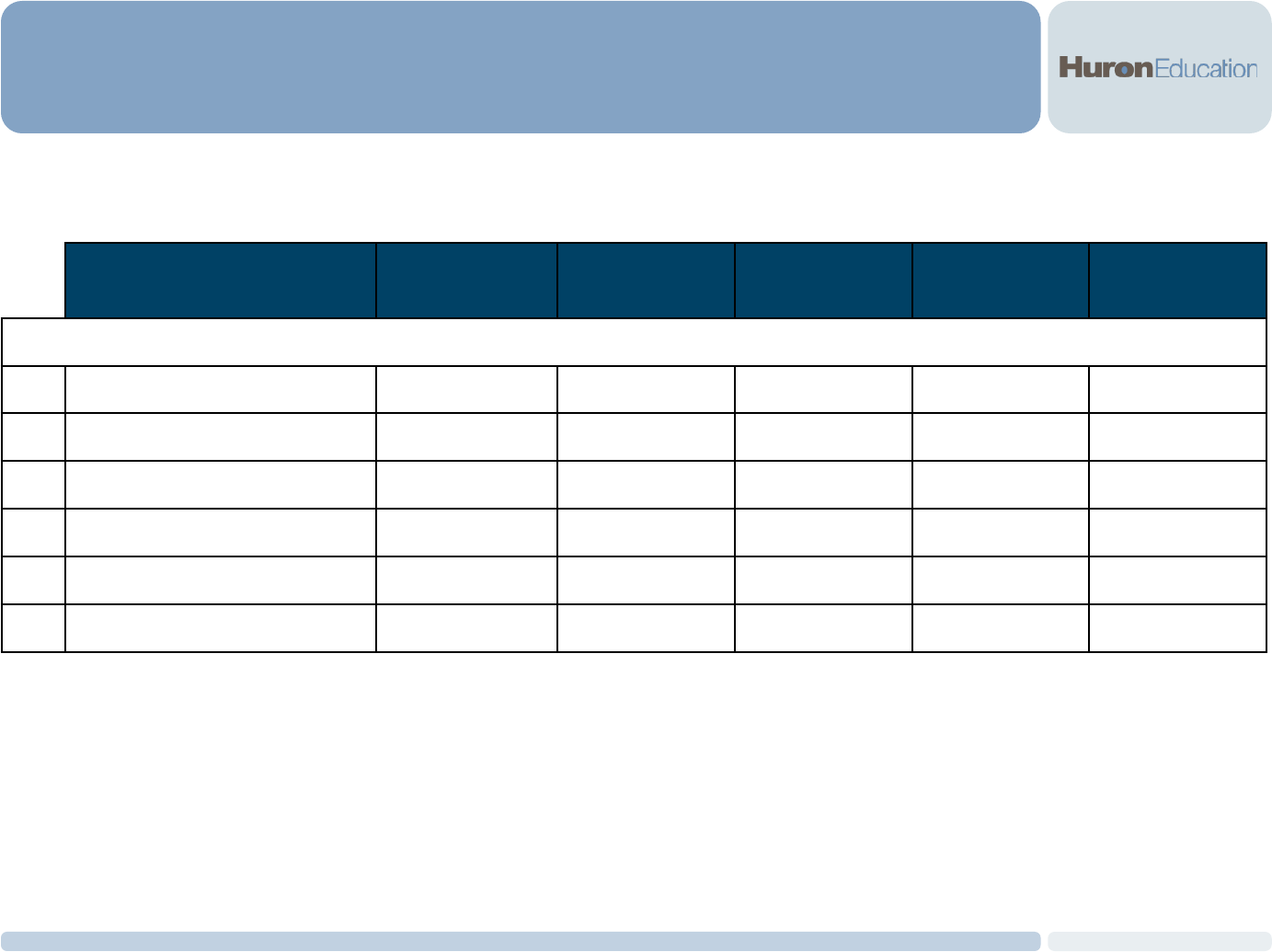
© 2015 Huron Consulting Group. All Rights Reserved. Proprietary & Confidential.
59
RECAP
The UWS should take several steps over the next few years to reorganize the way IT systems and services
are organized and provisioned to realize both medium- and long-term cost reductions.
Business Case # 2
Opportunity
Annual Est.
Savings
UWS Risk
Exposure
Efficiencies
Gained
Implementation
Complexity
Implementation
Timeframe
Business Case # 2
10
Centralize IT security resources Enabling Low High Medium 6-12 Months
11
Consolidate IT Helpdesks
$$$$
Medium Medium High 12-24 Months
12
Consolidate High Performance Computing
Enabling Low Medium Medium 6-24 Months
13
Consolidate datacenter facilities
$$$$
High High High 24-48 Months
14
Identify additional areas for system-wide
collaboration
TBD
TBD TBD TBD TBD
15
Re-Organize IT Leadership
$$$$
Medium High High 24-48 Months

Business Case #3:
Engage in Enhanced Strategic Sourcing for
IT Hardware

© 2015 Huron Consulting Group. All Rights Reserved. Proprietary & Confidential.
Business Case # 3
CONTEXT AND BACKGROUND
Our objective in this business case was to evaluate specific IT categories where increased strategic
sourcing and demand management could provide substantial savings to UW Institutions.
61
Objectives: Huron was asked to evaluate IT spend across the UW-System to determine where substantial cost
savings can be achieved.
• Evaluate System-wide spend on IT-related products
• Evaluate vendor-specific IT spend to determine savings opportunities (Dell, HP, Apple)
• Evaluate the processes and structures by which IT purchases are made
Future-State Considerations:
• Actual cost-savings are dependent on the willingness of individual UW Institutions to collaborate on purchasing
decisions, negotiations, and policy creation and compliance.
• Per UW Madison purchasing staff, collaboration efforts by the UW have historically been focused on the
purchase of software products due to a history of mandatory IT hardware contracts at DOA
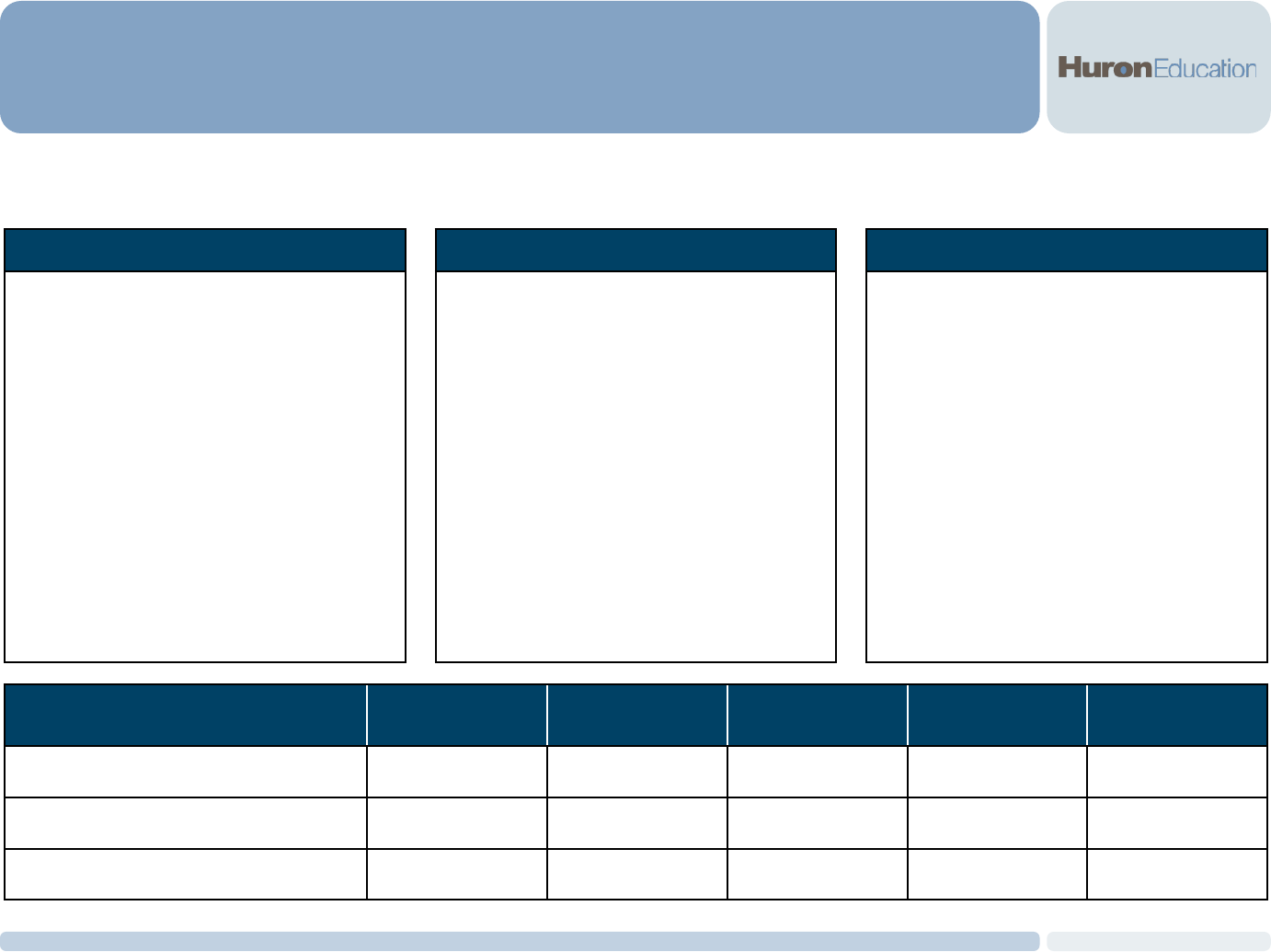
© 2015 Huron Consulting Group. All Rights Reserved. Proprietary & Confidential.
62
RECOMMENDATION OVERVIEW
Opportunity Annual Est. Savings
UWS Risk
Exposure
Efficiencies Gained
Implementation
Complexity
Implementation
Timeframe
Create System-wide standardized bundles for
laptops, desktops, and peripherals
$$$$
Low Medium Medium 6-12 Months
Enforce policies for
preferred purchases (Madison
foregone savings displayed)
$$$$
Low Low Low 0-6 Months
Develop a collaborative, System-wide
procurement function to take advantage of scale
Enabling Low High High 12-24 Months
Business Case #3
Current State Situation Recommendation Components Considerations & Risks
• System-wide collaboration efforts for IT
Hardware purchases are minimal
• IT hardware and software policies vary
across UW institutions
o Models available for purchase vary
significantly across UW institutions
• No data warehouse exists to consolidate
purchasing data across purchasing methods
• Data definitions, such as product naming
conventions, are not standardized making it
difficult to aggregate data for analysis
• Develop a system-wide collaboration
function for IT hardware purchases
• Establish a single set of standardized
desktop and laptop models available for
purchase across all UW institutions
• Develop and establish system-wide policies
related to IT Hardware purchases
• Implement guidelines and policies that
require end users to provide a valid
business need in order to purchase high-
end or non-standardized desktop and laptop
models (may need to reflect academic
missions of UW institutions)
• Actual achievable cost savings are
dependent on the level of collaboration for
contract negotiations, policy establishment,
and implementation of demand
management practice to ensure policy
compliance
• P-card purchases generally represent a
spend method for which no vendor
discounts are received, however there are
incentives at the campus level to use p-
cards due to the rebates received
Source: *Savings Estimates Based on Analysis of Laptops, Desktops, and Monitors; Additional Savings Opportunities are Likely Available in Other Peripheral Categories
The UW should take advantage of the magnitude of system-wide spend and seek opportunities to engage in
enhanced strategic sourcing, demand management, and strategic procurement for IT-related purchases.
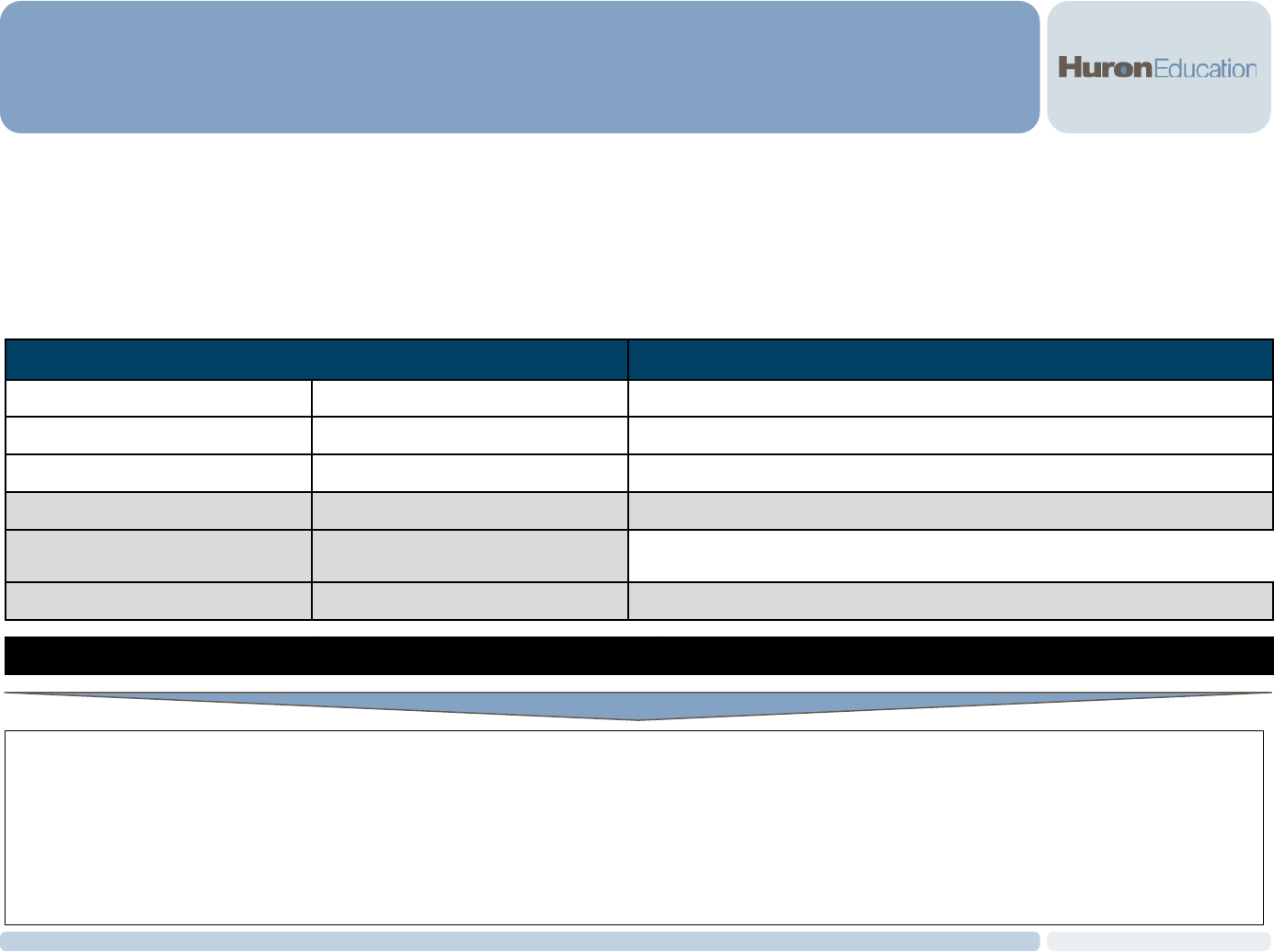
© 2015 Huron Consulting Group. All Rights Reserved. Proprietary & Confidential.
Business Case #3
EXECUTIVE SUMMARY
63
Over the last several weeks, Huron has analyzed IT-spend across the UW System in order to understand the
totality of IT-related spend and develop an understanding of where potential savings opportunities are
available. Huron focused its analyses on laptops, desktops, and monitors for Apple, Dell, and HP. The
analyses presented in this business case represent those areas in which Huron was able to identify
significant cost savings opportunities within the limited timeframe available for analysis.
Total Estimated Spend (000’s) Total Estimated Annual Savings through Model Standardization (000’s)
Dell
$17,572 $
Hewlett-Packard
$7,851 $
Apple
$3,461 $
Total Spend Analyzed
$28,884 $
Total IT-Related Spend
$116,455
UW-Madison Forgone Savings*
$$
Total Estimated Annual Savings $$
The savings presented above represent savings Huron believes the UW could achieve by reducing the number of laptop,
desktop, and monitor models available to employees for purchase from each of the vendors analyzed. Huron believes
additional savings are available to the UWS if it were to consolidate laptop, desktop , and monitor spend to two primary
vendors: Apple and one non-Apple vendor. In addition, Huron believes there to be significant cost savings opportunities
available to UWS in other IT-peripheral spend; however, Huron was unable to perform detailed analyses across peripheral
spend within the limited timeframe available. Further analysis is necessary to determine savings opportunities.
Source: *Savings based on Reducing Foregone Savings by 20%-40%
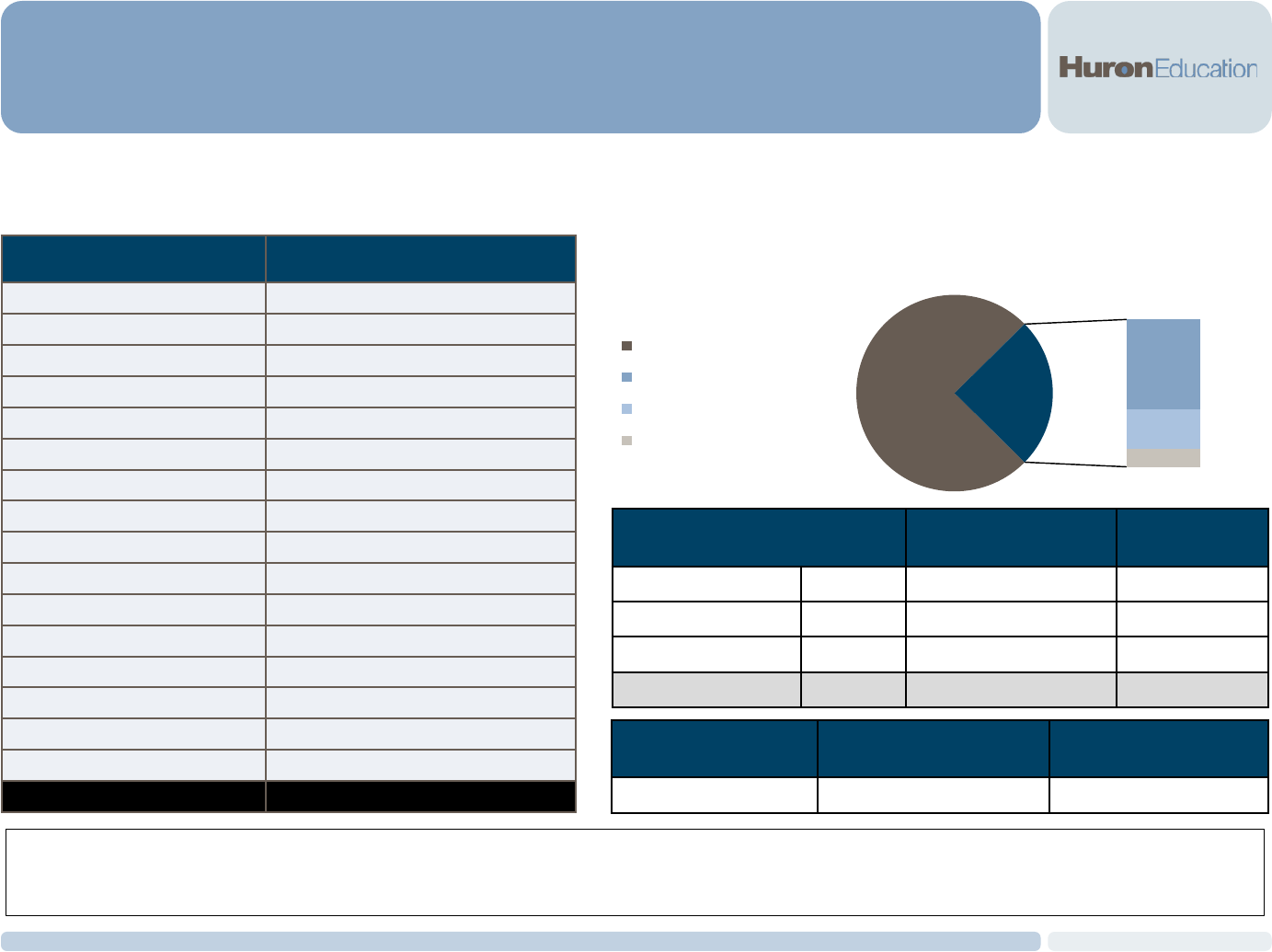
© 2015 Huron Consulting Group. All Rights Reserved. Proprietary & Confidential.
Business Case #3
OVERALL DESKTOP/LAPTOP SPEND AND ANALYSIS SUMMARY
64
Huron estimates that a little over $116M is spent on IT-related products across the System annually, with
desktop and laptop spend from Dell, HP, and Apple accounting for approximately 9%.
Total Estimated Spend (000’s)
Total Estimated Desktop/
Laptop Spend (000’s)
Percentage of
Spend
Dell $17,572 $6,345 36%
Hewlett-Packard $7,851 $2,490 32%
Apple $3,461 $1,345 39%
Total Spend Analyzed $28,884 $10,180 35%
Source: *Savings based on Reducing Foregone Savings by 20%-40%
Institution: Total IT Spend (000’s)
Administration
$129
Colleges / Extension
$4,194
Eau Claire
$4,092
Green Bay
$2,025
La Crosse
$6,004
Milwaukee
$11,096
Madison
$51,670
Oshkosh
$3,744
Parkside
$1,343
Platteville
$2,953
River Falls
$2,566
Stout
$6,777
Stevens Point
$4,132
Superior
$1,303
System
$9,948
Whitewater
$4,479
Total
$116,455
Based on detailed analysis of Dell, HP, and Apple, Huron estimates the UWS can reduce total expenditures on desktops
and laptops through model standardization, and by achieving UW Madison negotiated prices, where applicable.
87,571
17,572
7,851
3,461
28,884
Total IT Spend Analyzed ($000’s)
Unanalyzed IT Spend
Dell
HP
Apple
Spend Category
Estimated Spend Dell, HP, &
Apple (000’s)
Estimated Annual Savings
(000’s)
Desktop/Laptop $10,180 $

© 2015 Huron Consulting Group. All Rights Reserved. Proprietary & Confidential.
Business Case #3
MODEL STANDARDIZATION AND BUNDLING
In order to achieve savings, UW Institutions will need to collaborate and cooperate to ensure standardized
models meet the technological needs of the majority of constituents across all campuses.
65
The UWS must take in to account the following considerations when evaluating potential models for standardization:
• Standardized models should vary in technological capabilities to ensure that administrative, academic,
and research computing needs are all met
• IT organizations across UWS need to be active participants in engaging campus constituents to understand user
preferences to define standardized models, and to build campus support for the established vendor and vendor
products
• UWS needs to ensure that the preferences of all levels of stakeholders are included in the determination of
standardized models to be offered

© 2015 Huron Consulting Group. All Rights Reserved. Proprietary & Confidential.
Business Case #3
DATA CHALLENGES & ANALYSIS METHODOLOGY
Huron obtained and aggregated SFS, MDS, and P-card procurement data from April 2014 through March
2015 to perform detailed IT spend analysis.
66
The following describes the data used for analysis, how it was combined, and the assumptions made by Huron to estimate total IT
spend across the UWSA:
1. SFS, MDS, and P-card data was obtained from UWS and combined to estimate total IT spend in various categories
2. SFS data, as provided by UWSA, included the following IT-related SFS codes:
3. The following P-card categories were included for analysis:
4. MDS data includes all Dell and Staples spend regardless of category; in addition, the following categories were included to
identify IT spend:
5. In addition, Huron included MDS data where Huron was able to assign IT categories based on transaction detail information
6. Due to data and time constraints, Huron focused its analysis on a select high-spend IT vendors, including Dell, Apple, and
Hewlett Packard
•2200 – Telecomm-Blanket Encumbrance
•2201 – Telecomm Services-Centrex
•2210 – Telephone Service-NonSTS Tolls
•2230 – Telephone Service-Install, etc.
•2240 – Telephone Service-STS
•2250 – Telephone-STS Access, Etc.
•2260 – Communication-Misc.
•2270 – Cellular Service
•2271 – Cellular Equipment
•2330 – Rental of DP Equip
•2235 – Lease of DP Equip
•2360 – Rental of Other Equip
•2370 – Lease of Equipment
•2410 – Leasehold Repairs & Maint.
•2460 – Maintenance & Repair-DP Equip
•2670 – Printing & Duplicating-State
•2675 – Printing & Duplicating-NonStat
•3150 – Software-Purchases
•3151 – Software Maintenance Payments
•3194 – Comp & Peripherals not Capital
•3791 – Computer Exchange Repair Parts
•4620 – Computer Equipment
•4625 – Computer Equip-Cap Lease
•4630 – Software Purchase Capitalized
•4635 – Software-Capital Lease
•Electronic Components and Supplies
•Information Technology Broadcasting and Telecommunications
•Office Equipment and Accessories and Supplies
•Printing and Photographic and Audio and Visual Equipment and Supplies
•Computer and Data Process
•Computer Network/Information Systems
•Computer Repair/Maintenance
•Computer Software Stores
•Electronics Stores
•Telecom Equipment
•Wholesale Computers
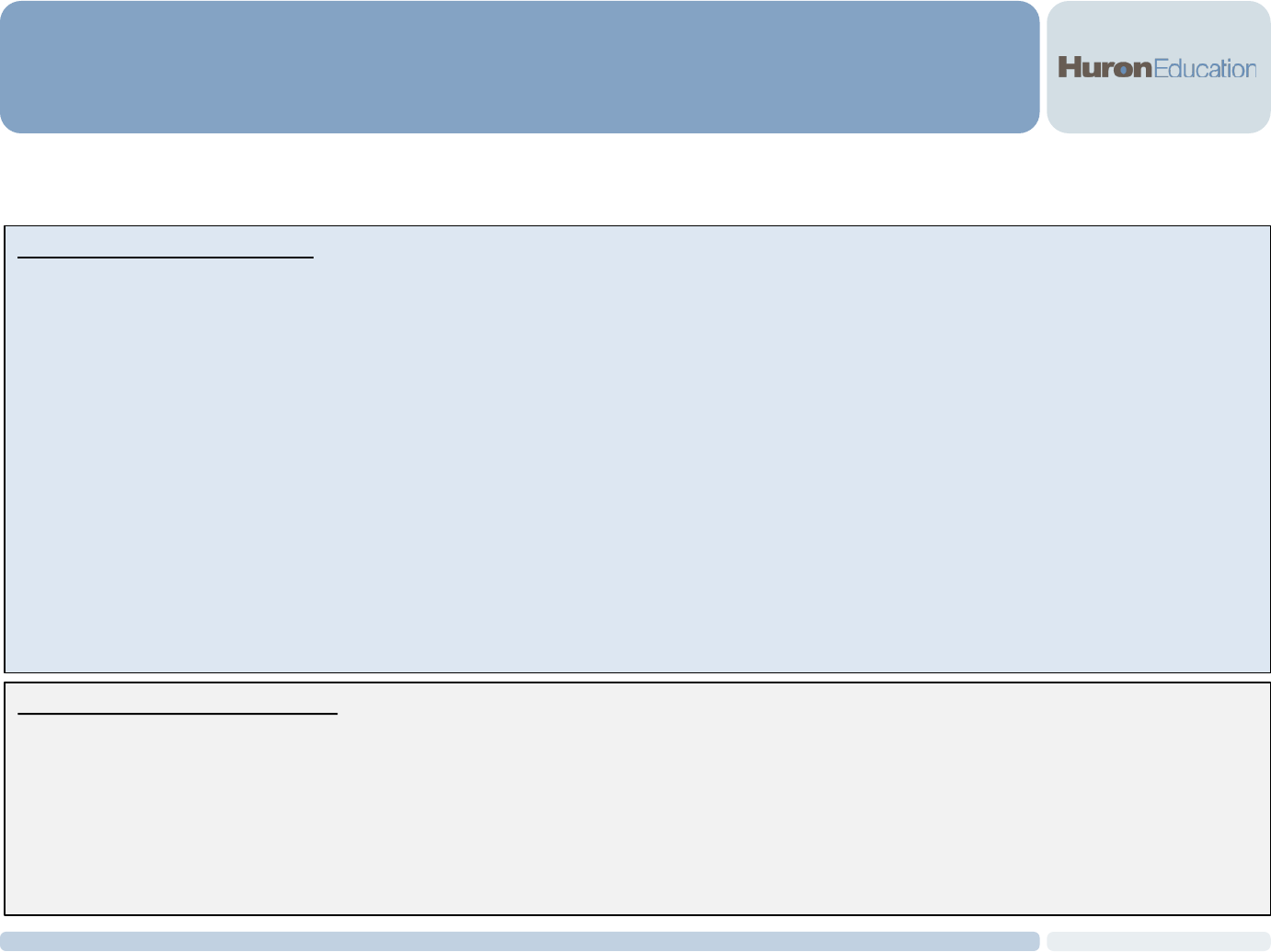
© 2015 Huron Consulting Group. All Rights Reserved. Proprietary & Confidential.
67
DESKTOP, LAPTOP, AND PERIPHERAL MARKET
Business Case #3
The desktop and laptop, and peripheral IT hardware environments have become consolidated and
commoditized, providing high spenders with the opportunity to negotiate favorable discounts with vendors.
Desktop and Laptop Environment:
• The PC market has consolidated through mergers and acquisitions
o Dell, HP, and Lenovo are the major manufacturers in the market
o Lenovo recently overtook HP in 2013 to claim the largest PC market share, in the global market
o Desktops and laptops can also be purchased through major national IT distributors such as CDW-G and GovConnection
o Typical PC life-cycles span 3 to 5 years, most Higher Education institutions employ a 4 year life-cycle
• A continuous cycle of commoditization and technological improvements create challenges in contract optimization (e.g., New technology carries an
initial price premium)
• Pricing for computer hardware products is driven by several key factors; vendors place high value on long-term preferred / primary status contract
relationships
o Standardization: bundled configurations provide deep discounts to universities; many universities have developed preferred supplier
relationships that offer standard/bundled configurations for specific products
o Product configuration and customization: premium pricing for component upgrades
o Volume: buying in bulk provides leverage in pricing negotiations
• Apple, a higher cost option compared to PCs, has recognized an increase in end user preference on college campuses among students, faculties,
and staff members, especially for their iPad line of products
Peripheral IT Hardware Environment:
• Primary national distributors servicing Higher Education institutions include CDW-G and GovConnection, both offer a broad selection of products,
including peripherals, computers, enterprise products, software, office equipment, etc.
• Equipment and supplies are also directly purchased from manufacturers (Dell, HP, etc.)
• Due to the diverse types of products and brand selections, maverick spend outside of main contracted vendors is common in this category, often
through suppliers such as Amazon, Best Buy, TigerDirect, Newegg, etc.
o Small peripherals, accessories, and equipment such as toner, printers, keyboards, etc. are also purchased through office supply vendors
• IT peripherals is a commoditized industry in which major vendors are capable of offering similar, products, pricing, and services
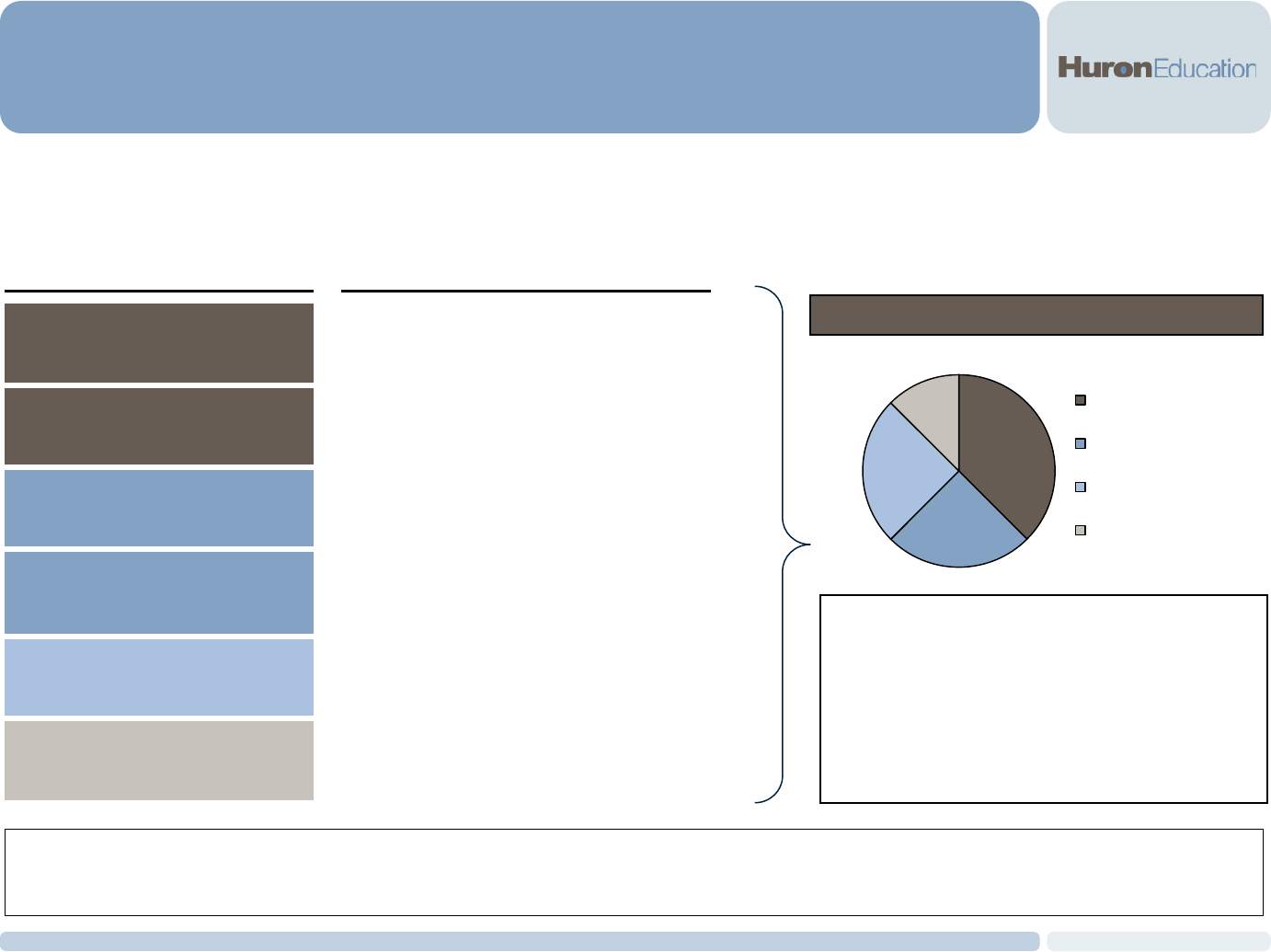
© 2015 Huron Consulting Group. All Rights Reserved. Proprietary & Confidential.
68
PROCUREMENT OVERVIEW
The ability to achieve maximum savings is dependent on organizational willingness to coordinate in establishing buying
power leverage and negotiating contracts, and the ability of the UWS to implement changes beyond the price opportunity.
There are multiple procurement levers the UWS can utilize to realize cost savings in strategic sourcing,
demand management, and strategic procurement.
Business Case #3
Approaches
Procurement Levers
• Evaluate supplier costs
• Obtain lowest cost from incumbent supplier; if not, consider
lower cost suppliers
• Concentrate volume
• Conduct best price evaluation
• Introduce new suppliers
• Modify consumption
• Find alternative ways of fulfilling need
• Standardize specifications
• Simplify specifications to reduce costs
• Increase policy compliance
• Create or modify supplier or consumption policies
• Channel users to preferred supplier agreements
• Provide marketplace visibility for preferred suppliers
• Create operating efficiencies for suppliers
• Ability to pay vendors more rapidly
Typical Savings Opportunity Breakdown
Strategic Sourcing
Demand Management
Strategic Procurement
eProcurement
Price Opportunity
Buying Power Leverage
Demand Management
Product/Service
Specification Rationalization
Policy Review and Compliance
eProcurement
The UW vision should be comprehensive:
• Organizational changes may be required to accomplish
standardization and integration of strategy
• Focus on negotiating additional System-wide master
agreements with high spend, primary suppliers to achieve
greater discounts than currently received and improve
customer relationships
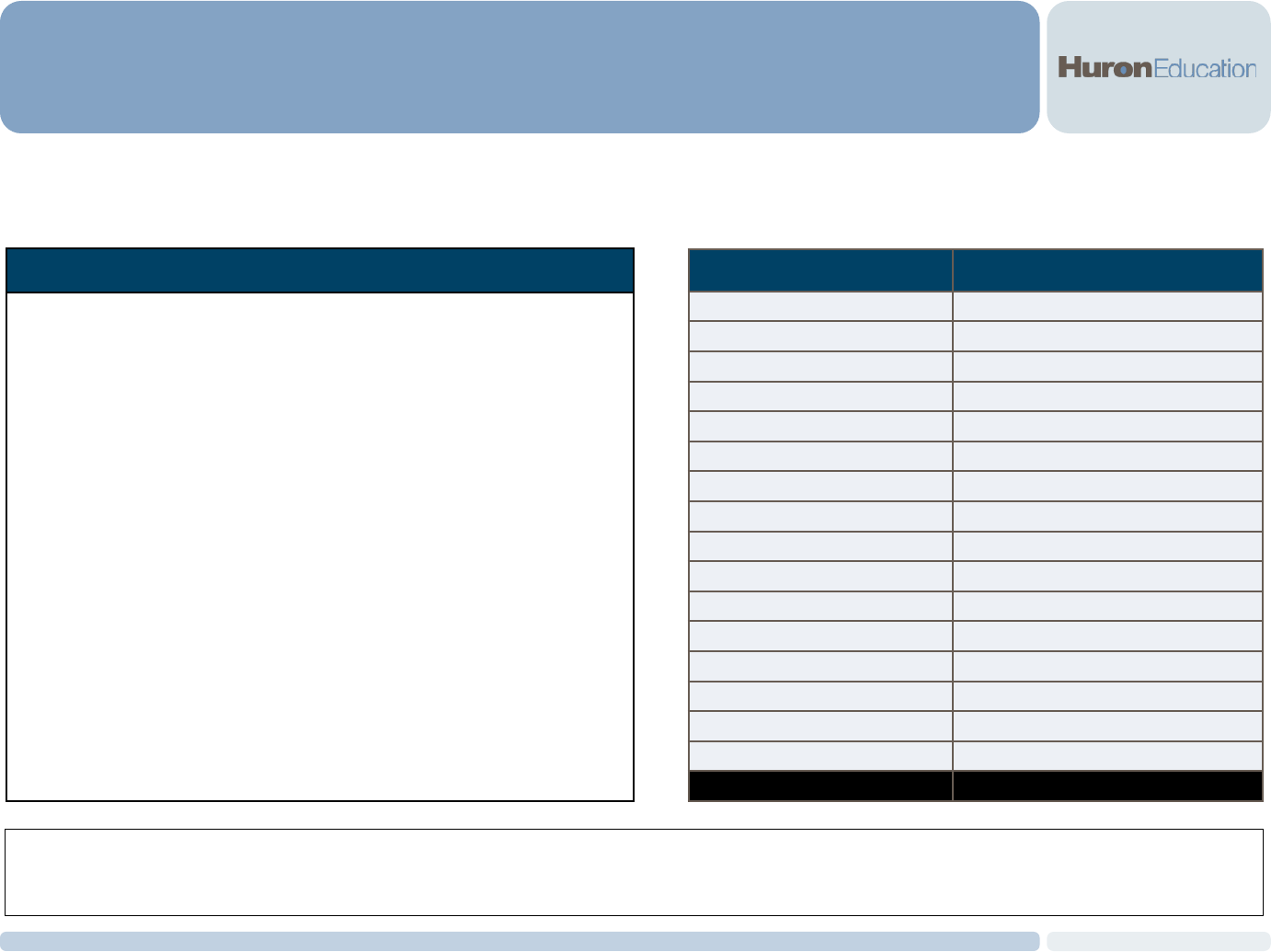
© 2015 Huron Consulting Group. All Rights Reserved. Proprietary & Confidential.
69
CURRENT STATE OVERVIEW
Business Case #3
Current procurement processes, standards, and policies vary across UW Institutions leading to
inefficiencies and increased costs.
Current State Assessment
• Minimal System-wide collaboration efforts to leverage UW
purchasing power to negotiate additional product discounts
• Current System and Institution organizational structures
hinder collaboration efforts with individual institutions
making purchases mostly from State WCSA contracts
• Lack of system-wide standards for desktop and laptop
models available for purchase
• At the institution level, utilization of standard desktop and
laptop models appear to be encouraged but not mandated.
The number of models available at each institution varies
significantly
• End users have the ability to purchase from a variety of
vendors, including Dell, Apple, HP, Lenovo, etc.
•
Huron estimates that approximately $116M is spent on IT-
related items across the System on a yearly basis
Through System-wide collaboration for discount negotiations, product standardization, and improved policy creation and
compliance, Huron believes the UW could achieve additional cost savings.
Institution: Total IT Spend (000’s)
Administration
$129
Colleges / Extension
$4,194
Eau Claire
$4,092
Green Bay
$2,025
La Crosse
$6,004
Milwaukee
$11,096
Madison
$51,670
Oshkosh
$3,744
Parkside
$1,343
Platteville
$2,953
River Falls
$2,566
Stout
$6,777
Stevens Point
$4,132
Superior
$1,303
System
$9,948
Whitewater
$4,479
Total
$116,455
Source: *April 2014-March 2015 Financial Data Provided by UWSA,

© 2015 Huron Consulting Group. All Rights Reserved. Proprietary & Confidential.
Business Case #3
SAVINGS CALCULATIONS DESCRIPTION
Savings calculations were estimated by Huron using the following data and assumptions:
70
Huron obtained Dell, HP, and Apple data from varying sources. The following data sources were used to calculate
weighted-average prices and to estimate savings for the selected vendors:
• Dell – Huron utilized UW institution spend data provided by the DOA
• HP – Huron utilized spend data for UW institutions provided directly by Hewlett-Packard
• Apple – Huron utilized UW institution spend data provided by UWSA
Huron understands that UW Madison bundle prices vary from weighted-average prices calculated using DOA data.
Weighted-average prices calculated would include only those purchases through the state contracts, which do not
have the same level of discounts as those obtained by UW Madison.
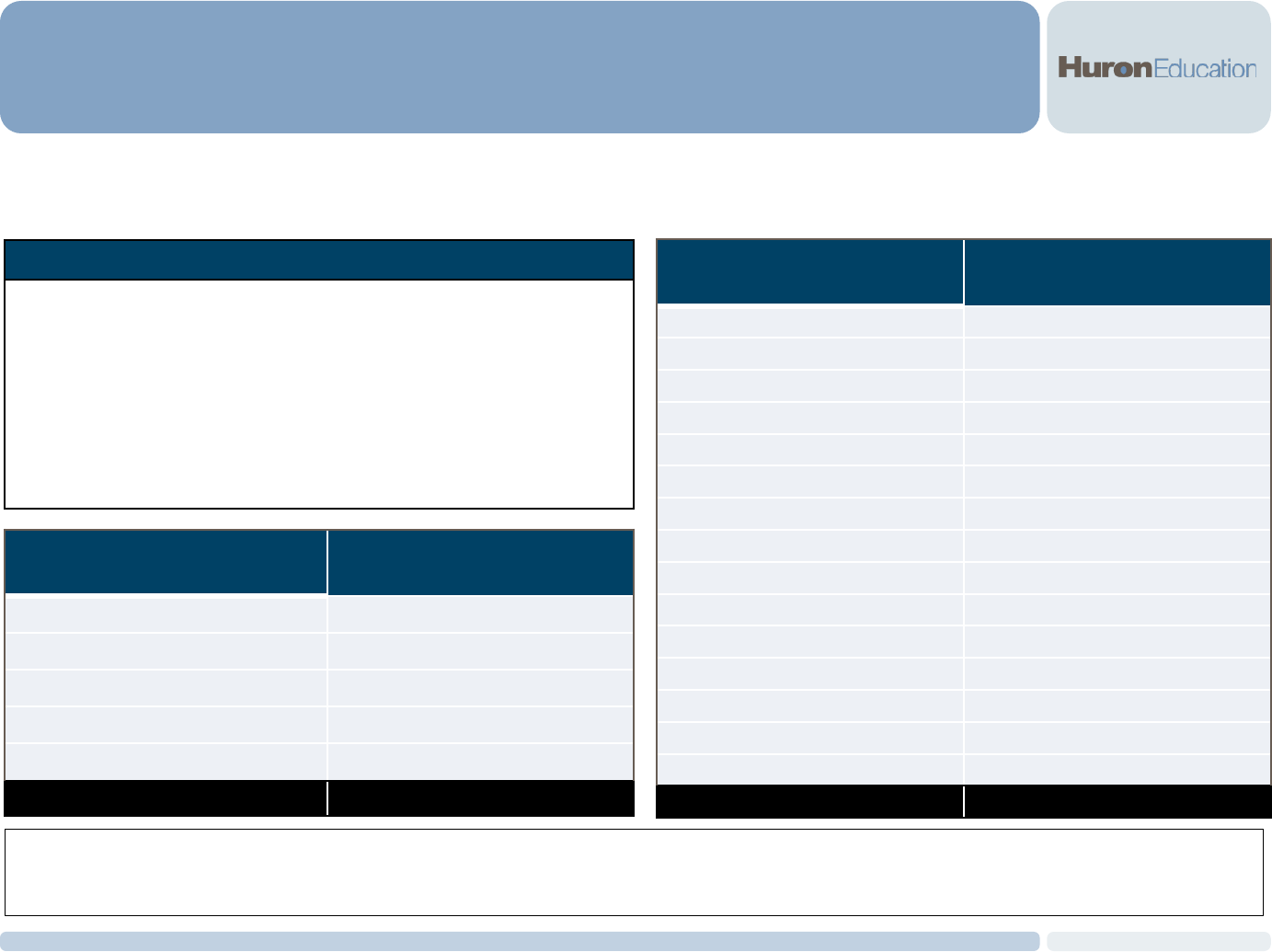
© 2015 Huron Consulting Group. All Rights Reserved. Proprietary & Confidential.
71
DELL SPEND OVERVIEW
Business Case #3
Spend on Dell products is split across a minimum of 14 different vendors, though the majority seems to be
purchased directly from Dell.
Institution: *Total Approximate Dell Spend
(000’s)
Colleges / Extension
$739
Eau Claire
$1,114
Green Bay
$0
La Crosse
$1,220
Milwaukee
$2,244
Madison
$11,127
Oshkosh
$4
Parkside
$303
Platteville
$2
River Falls
$346
Stout
$3
Stevens Point
$20
Superior
$267
Whitewater
$8
Cities, Counties, Found., System
$175
Total
$17,572
The Dell contract on MDS is limited to UW-Madison; however, the opportunity exists to renegotiate with Dell to include all
UW Institutions to purchase Dell products through MDS, providing the greatest total value to UW System.
Source: *April 2014-March 2015 Financial Data Provided by UWSA, Includes Purchases of Dell Products from Non-Dell Suppliers
Current State Assessment and Observations
• Approximately $17.6M was spent on Dell merchandise across the UW
System during the timeframe analyzed
• UW Madison, UW Milwaukee, UW La Crosse, and UW Eau Claire are
among the highest purchasers of Dell merchandise within the system
• UW Madison negotiated additional discounts with Dell on top of the
State contract, however, Dell was unwilling to extend the contract to
the entire UW System during the time of the negotiation
Vendor *Total Approximate Dell Spend
(000’s)
Dell
$17,330
Ronsberg Technology Partners Inc.
$103
Staples
$55
Avalon Technologies
$29
Other
$55
Total
$17,572
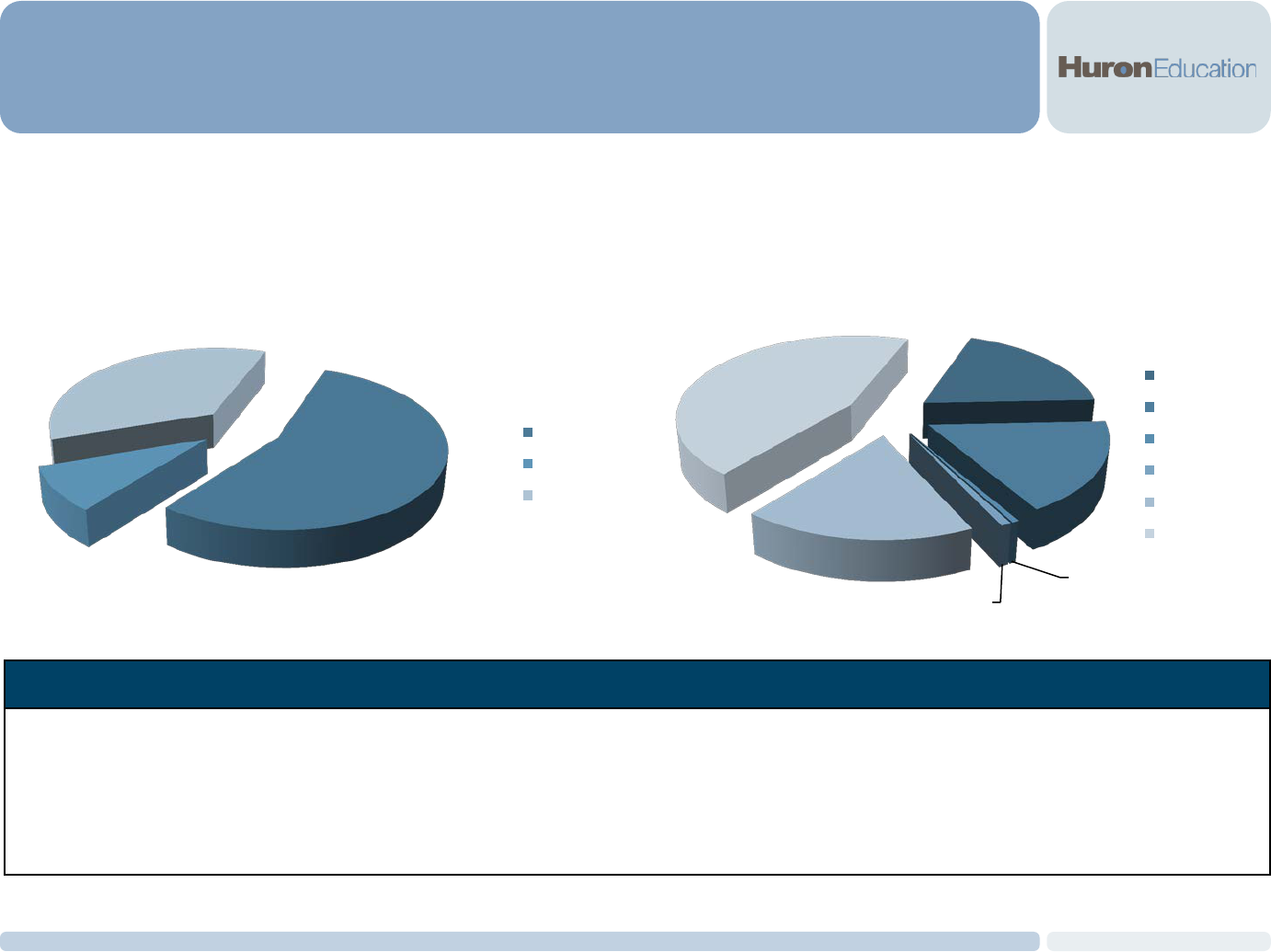
© 2015 Huron Consulting Group. All Rights Reserved. Proprietary & Confidential.
72
DELL SPEND BY PRODUCT CATEGORY
Business Case #3
Spend with Dell is divided into six primary product categories including Desktops, Laptops, Servers,
Workstations, Tablets, and IT Peripheral products (comprised of accessories, toner, monitors, etc.).
Note: Servers include servers, switches, and server storage
$3,301
$3,044
$96
$144
$3,129
$7,857
Dell Spend By Product Category ($000’s)
Desktop
Laptop
Tablet
Workstation
Servers
IT Peripherals
Observations
• Close to $1.6M in Dell goods were purchased with P-cards
• Combined Dell desktop and laptop spend accounts for $6.4M (36% of total Dell spend)
• Server purchases, including rack servers, blade servers, tower servers, server storage expansion, and server switches, account
for approximately $3.1M (18% of total Dell spend)
$9,686
$1,593
$6,292
Dell Spend By Purchasing Method ($000’s)
MDS
P-card
SFS
Source: *April 2014-March 2015 Financial Data Provided by UWSA, Includes Purchases of Dell Products from Non-Dell Suppliers
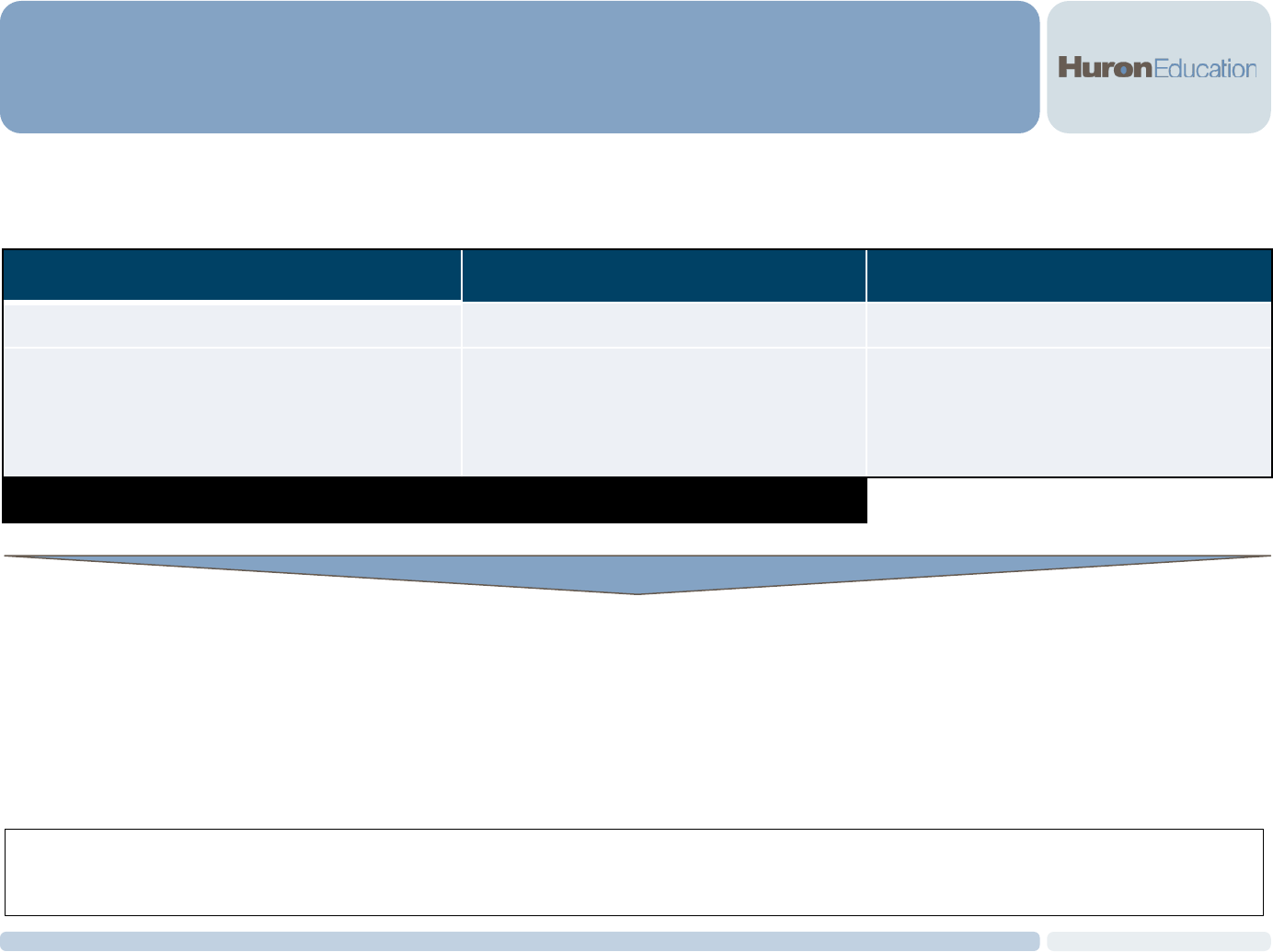
© 2015 Huron Consulting Group. All Rights Reserved. Proprietary & Confidential.
Business Case #3
DELL SPEND ANALYSIS
73
In addition to obtaining UW purchasing data, Huron received Dell spend data from the Department of
Administration (DOA) that allows for a more detailed analysis.
• Based on conversations with UWSA Procurement staff, it was determined that the variance is likely caused by either Dell
purchases that weren’t covered under the State (WSCA) contract, purchases made by the UW on other (non-WSCA) contracts,
or purchases that were not covered by any contract
Source *Total Approximate Dell Spend (000’s) Comments
Department of Administration Data
$12,281
• Date range: April 2014-March2015
UWS Data
$15,761
• Date range: April 2014-March2015
• Data includes IT purchases directly from
Dell from both SFS and MDS (P-card data
would not be included in the DOA data)
Variance
$3,480
Huron utilized the DOA data for UW institutions as the basis for analyzing specific IT categories and for quantifying
savings, as the data definitions were more standardized, providing for a more accurate analysis.
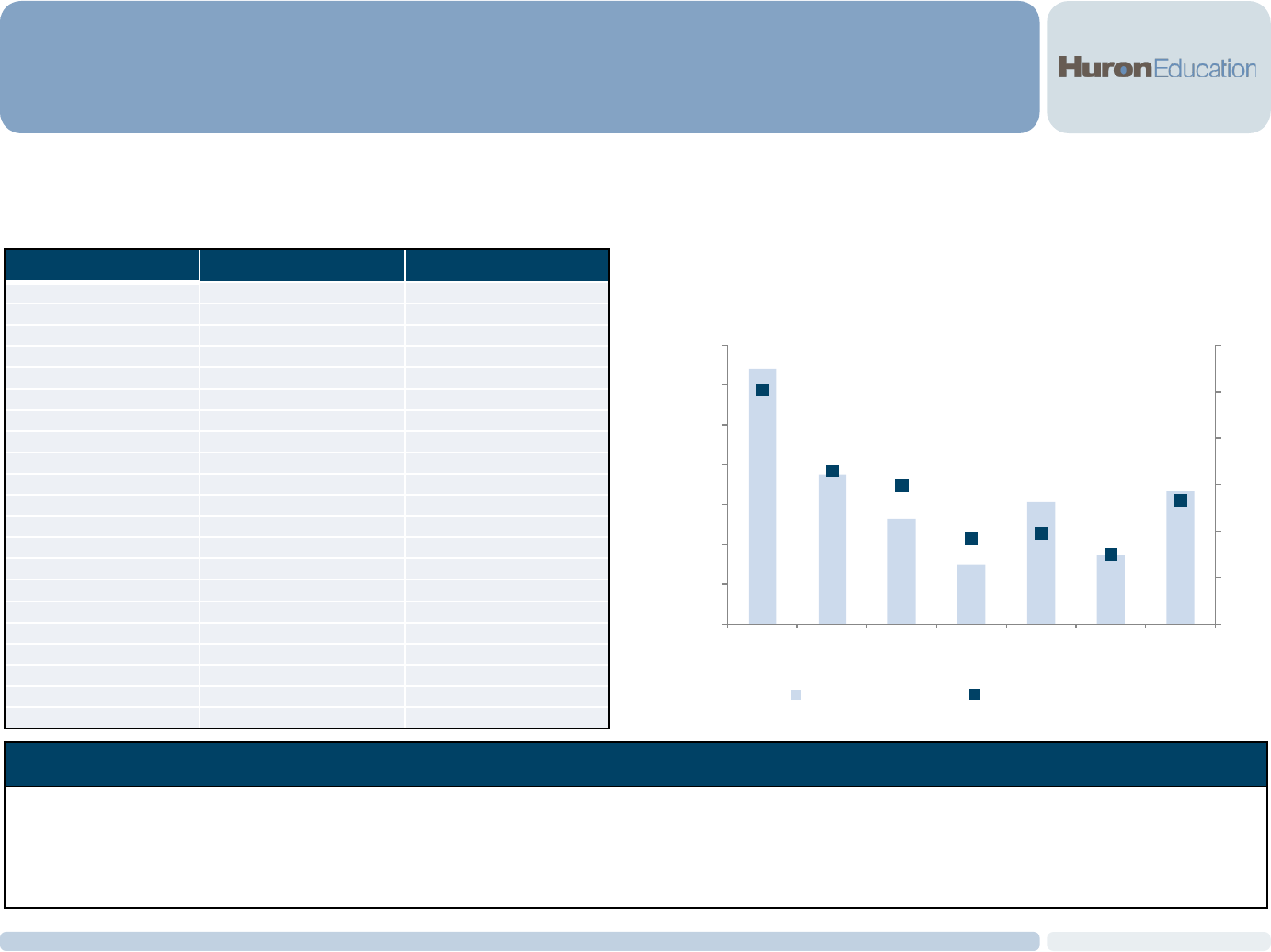
© 2015 Huron Consulting Group. All Rights Reserved. Proprietary & Confidential.
74
DELL LAPTOP OVERVIEW
Business Case #3
There are at least 23 Dell laptop models purchased across the UW, indicating the potential to realize savings
through system-wide laptop model standardization.
504
329
297
184
195
149
266
0
100
200
300
400
500
600
$0
$100,000
$200,000
$300,000
$400,000
$500,000
$600,000
$700,000
LATITUDE
E7440
LATITUDE
E7240
LATITUDE
E5440
LATITUDE
E5540
PRECISION
M6800
LATITUDE
E6440
OTHER
MODEL
Total Dell Laptop Spend & Number of Laptops
Purchased by Model
Total Laptop Spend Number of Laptops
Observations
• “Other” category includes 3 additional laptop models purchased within the UW System
• Most commonly purchased Dell laptop across the UW is the Dell Latitude E7440, accounting for at least 504 laptop purchases
(29% of the total Dell laptop spend through the DOA)
Source: April 2014-March 2015 Financial Data Provided by DOA, Weighted Average Unit Prices were calculated using the number of machines purchased at each different unit price
Laptop Model: Quantity Purchased Weighted-Avg. Price/Unit
LATITUDE E7440
504 $1,271
LATITUDE E7240
329 $1,141
LATITUDE E5440
297 $889
LATITUDE E5540
184 $810
PRECISION M6800
195 $1,568
LATITUDE E6440
149 $1,167
LATITUDE E6540
85 $1,434
XPS13
42 $975
LATITUDE 3340
32 $868
LATITUDE E7450
30 $1,424
LATITUDE E7250
17 $999
LATITUDE 3540
16 $852
LATITUDE 3440
7 $765
PRECISION M4800
7 $2,020
XPS DUO 12
6 $1,693
PRECISION M3800
5 $2,093
LATITUDE E6430
4 $1,181
XPS 9530
4 $1,569
XPS 13 9343
3 $1,271
DELL PRECISION M2800
2 $1,141
OTHER
4 Varies

© 2015 Huron Consulting Group. All Rights Reserved. Proprietary & Confidential.
75
UW MADISON DELL LAPTOP PRICES
Business Case #3
UW Madison was able to negotiate additional discounts with Dell on top of the WSCA contract by creating 6
preferred standardized laptop bundles.
Source: April 2014-March 2015 Financial Data Provided by DOA, Weighted Average Unit Prices were calculated using the number of machines purchased at each different unit price, UW Madison data provided by UW Madison Purchasing
UW Madison Negotiated Prices
Laptop Model
Price Before
Negotiation
Preferred
Pricing
Additional Discount after
WSCA Contract Pricing
Latitude 5450 $1,001.34 $779.00 23%
Latitude 5450
w/SSD
$1,091.04 $827.00 24%
Latitude 5550 $1,001.34 $779.00 23%
Latitude 5550
w/SSD
$1,091.04 $827.00 24%
Latitude E7250 $1,306.99 $949.00 27%
Latitude E7450 $1,283.02
$949.00
26%
Weighted-average prices calculated for comparable Dell laptop models utilizing UW institution data provided by the DOA
are, on average, higher than the prices UW Madison was able to negotiate with Dell.
Laptop Model: Quantity Purchased Weighted-Avg. Price/Unit
LATITUDE E5440 297 $889
LATITUDE E5540 184 $810
Laptop Model: Quantity Purchased Weighted-Avg. Price/Unit
LATITUDE E7440
504 $1,271
LATITUDE E7240
329 $1,141
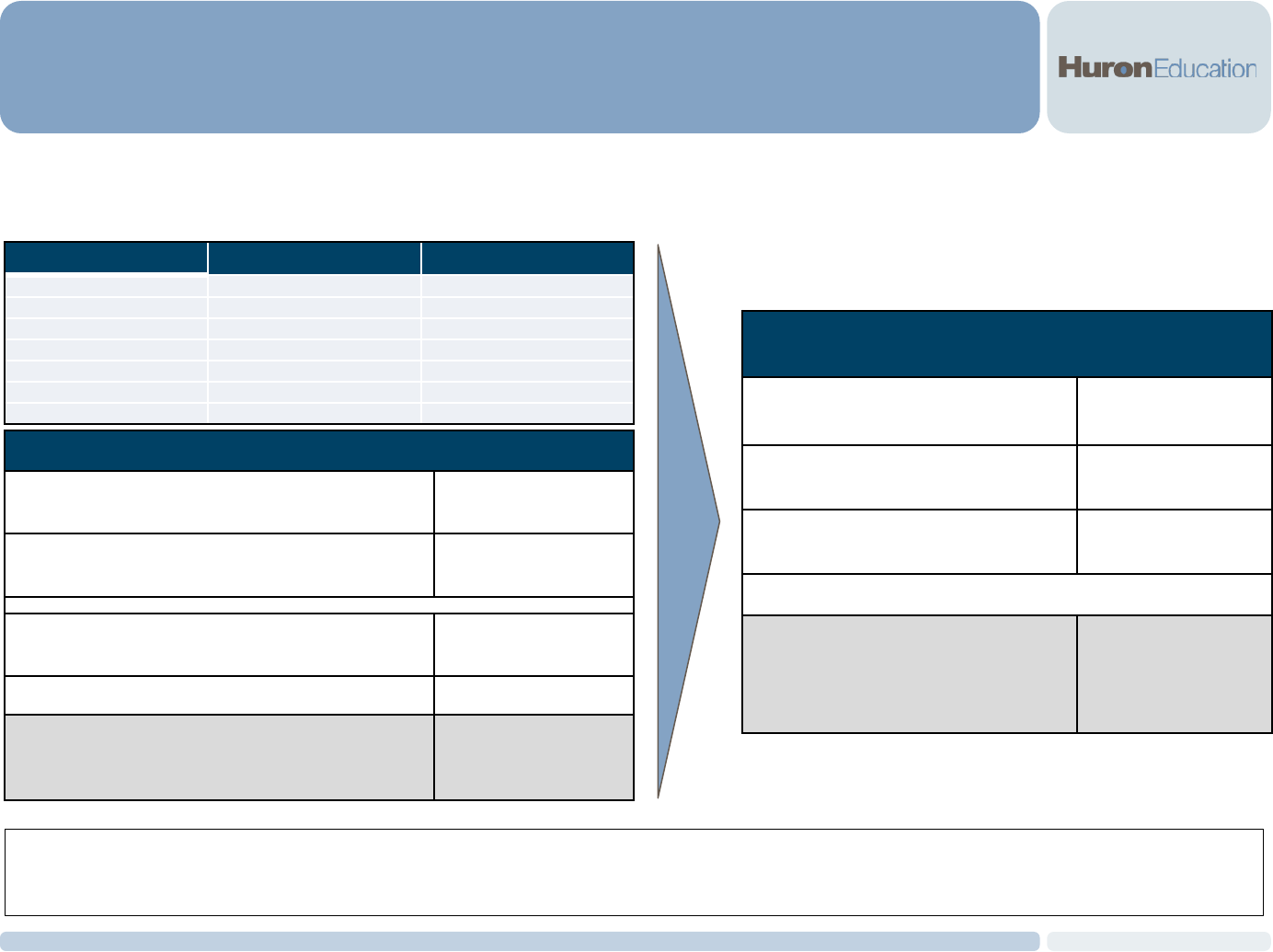
© 2015 Huron Consulting Group. All Rights Reserved. Proprietary & Confidential.
76
DELL LAPTOP SAVINGS OPPORTUNITY
Business Case #3
Huron utilized Dell laptop prices negotiated by UW Madison on the E5 and E7 Series to estimate potential
savings for the entire UW.
Laptop Model: Quantity Purchased Weighted-Avg. Price/Unit
LATITUDE E7440
504 $1,271
LATITUDE E7240
329 $1,141
LATITUDE E5440
297 $889
LATITUDE E5540
184 $810
LATITUDE E7450
30 $1,425
LATITUDE E7250
17 $999
LATITUDE
5250 1 1,136
1
Dell Laptop Savings Through Model Standardization
UW Madison E5 Series Price $779
UW Madison E7 Series Price $949
Total Number of E5 and E7 Series Laptops
Purchased through DOA
1,362
Total DOA Spend on E5 and E7 Series Laptops $1,491K
Estimated Savings from Achieving 50% Adoption
Rate at UW Madison Prices for all E5 and E7 Series
Laptops
$
Huron estimates UW could achieve significant savings annually by renegotiating their contract with Dell to ensure that all
E5 and E7 Series laptops are purchased at UW Madison negotiated prices and achieving a 50% adoption rate.
Additional Savings from Unaccounted SFS and P-Card
Dell Laptop Spend Directly from Dell
2
Estimation of Additional P-Card E5
and E7 Series Laptop Spend
$101K
3
Estimation of Additional SFS E5 and
E7 Series Laptop Spend
$468K
Total Estimated Additional E5 and E7
Series Laptop Spend
$569K
Estimated Additional Savings Based
on Estimated 50% Adoption Rate at
20% Savings Rate on E5 and E7 Series
Laptops
$
Weighted Average Unit Prices were calculated using the number of machines purchased at each different unit price
Percentage Savings Rate: Estimated Savings achieving UW Madison E5 and E7 Series
Prices/ Total DOA Dell E5 and E7 Series Laptop Spend
Source:
1
April 2014-March 2015 Financial Data Provided by DOA,
2
P-card Desktop Spend Estimated from April 2014-March 2015 Data Provided by UWS,
3
Additional SFS Desktop Spend Estimated from Data Provided by UWS
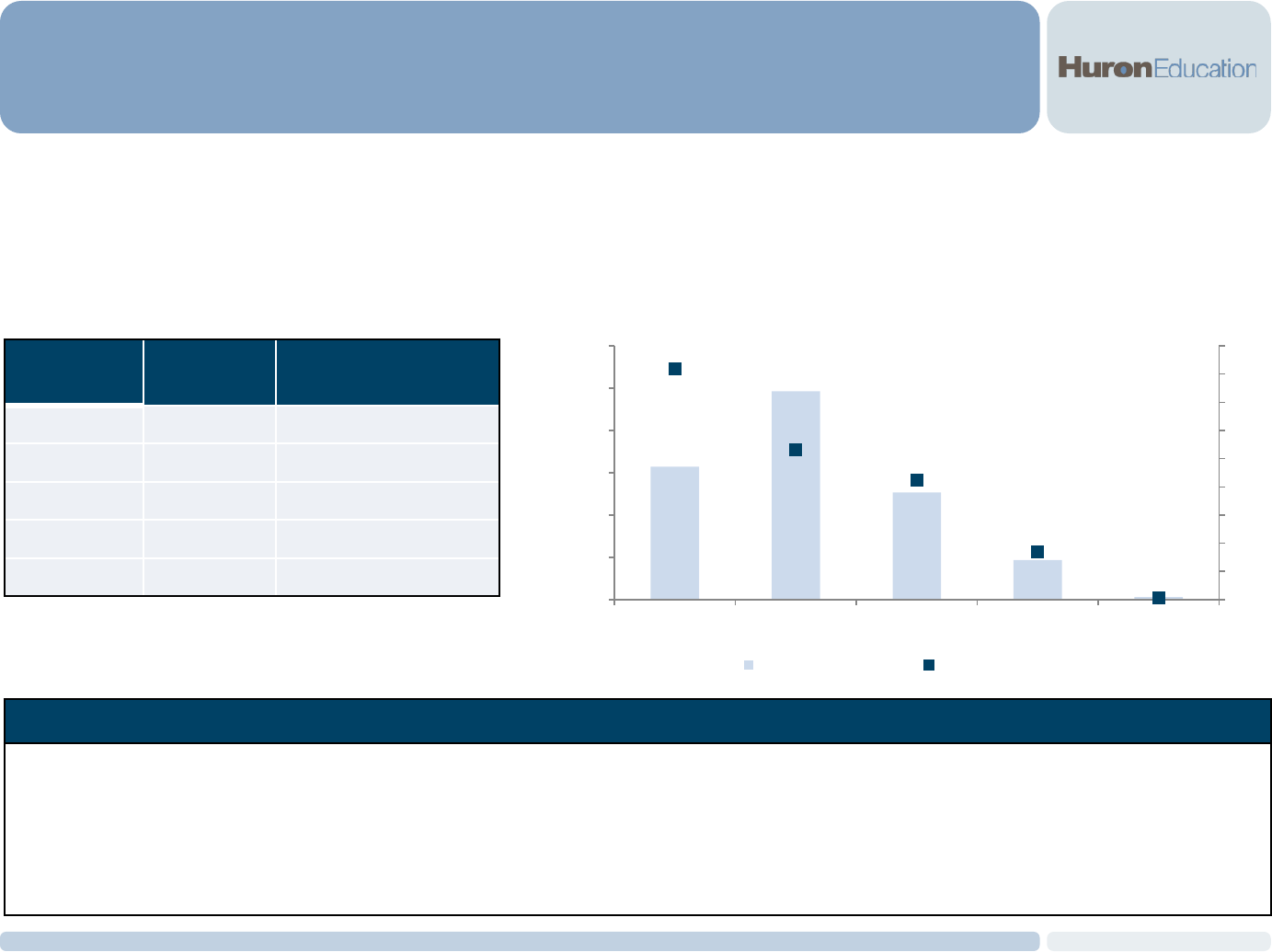
© 2015 Huron Consulting Group. All Rights Reserved. Proprietary & Confidential.
77
DELL DESKTOP OVERVIEW
Business Case #3
There are at least five known non-all-in-one Dell desktop models being purchased across UWS; Huron
believes that by standardizing Dell desktop models, UWS could achieve significant cost savings.
1,635
1,064
850
337
10
0
200
400
600
800
1000
1200
1400
1600
1800
$0
$200,000
$400,000
$600,000
$800,000
$1,000,000
$1,200,000
OPTIPLEX 7020 OPTIPLEX 9020 OPTIPLEX 7010 OPTIPLEX 3020 OPTIPLEX XE2
Total Dell Desktop Spend & Number of Desktops
Purchased by Model
Total Desktop Spend Number of Desktops
Observations
• The most common Dell desktop purchased across the system is the Dell Optiplex 7020, accounting for 1,635 desktop purchases (27% of total Dell
desktop spend)
• The second most common Dell desktop purchased across the system is the Dell Optiplex 9020, accounting for 1,064 desktop purchases (42% of total
spend)
• The Optiplex 9020, which accounts for more than 42% of total spend, has a significantly higher weighted-average price when compared to other
commonly purchased models
Desktop
Model
Quantity
Purchased
Weighted-Avg.
Price/Unit
OPTIPLEX 7020
1,635 $384
OPTIPLEX 9020
1,064 $926
OPTIPLEX 7010
850 $596
OPTIPLEX 3020
337 $556
OPTIPLEX XE2
10 $1,116
Source: April 2014-March 2015 Financial Data Provided by DOA, Weighted Average Unit Prices were calculated using the number of machines purchased at each different unit price
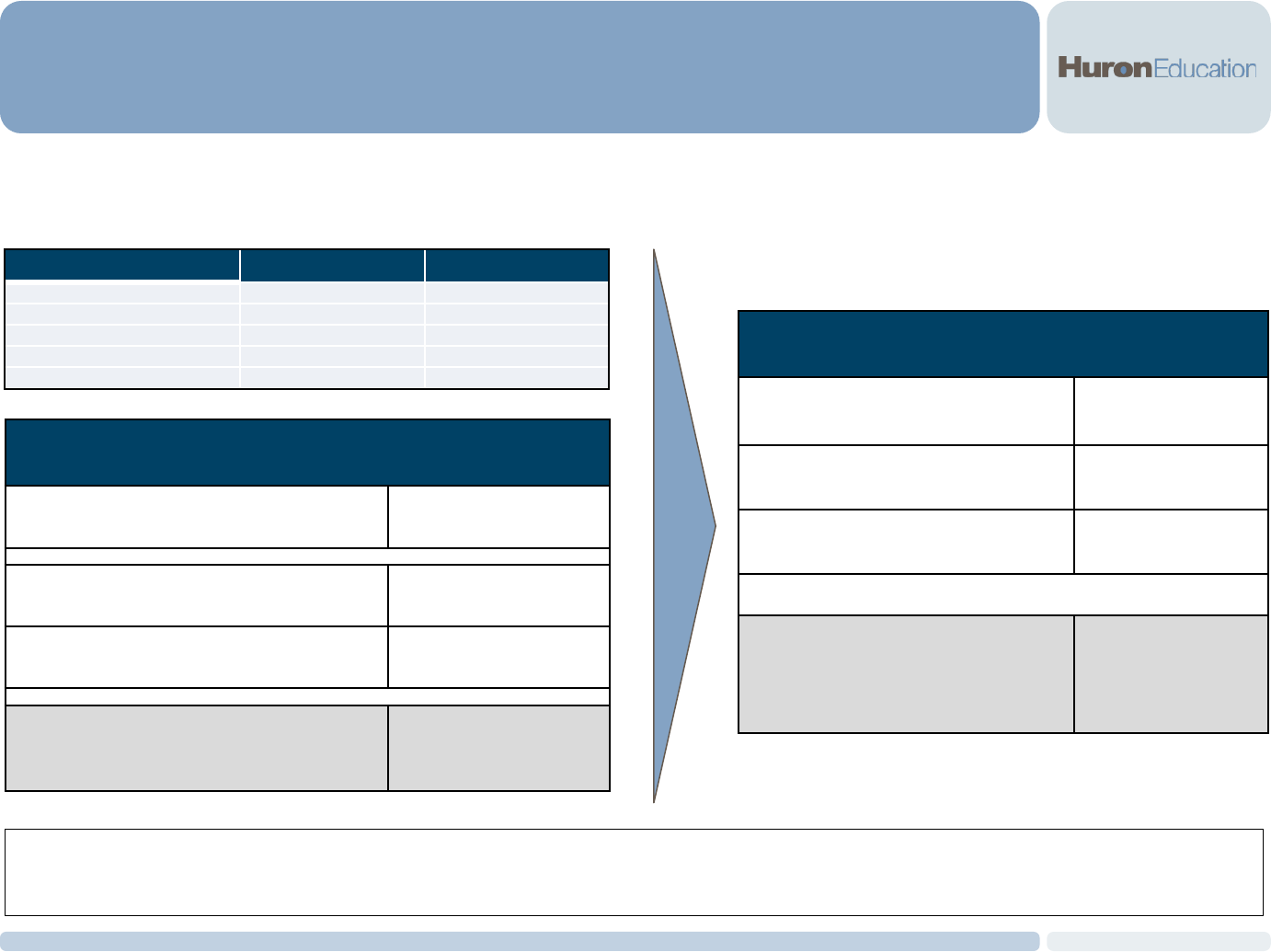
© 2015 Huron Consulting Group. All Rights Reserved. Proprietary & Confidential.
78
DELL DESKTOP SAVINGS OPPORTUNITY
Business Case #3
Huron estimated savings based on the prices UW Madison was able to negotiate with Dell on the Optiplex
7020 desktop model.
Source:
1
April 2014-March 2015 Financial Data Provided by DOA,
2
P-card Desktop Spend Estimated from April 2014-March 2015 Data Provided by UWS,
3
Additional SFS Desktop Spend Estimated from Data Provided by UWS
Huron estimates the UW could achieve significant annual savings if it were able to obtain the UW Madison price on the
Optiplex 7020 machine and shift 50% of non-Optiplex 7020 purchases to the Optiplex 7020.
Additional Savings from Unaccounted SFS and P-Card
Dell Laptop Spend Directly from Dell
2
Estimation of Additional Non-Optiplex
7020 and 7010 P-Card Desktop Spend
$466K
3
Estimation of Additional Non-Optiplex
7020 and 7010 SFS Desktop Spend
$245K
Total Estimated Additional Desktop
Spend
$1,292K
Estimated Additional Savings Based
on Shifting 50% of Non-Optiplex 7020
and 7010 Machines at 16% Savings
Rate to UW Madison Purchasing Price
$
Weighted Average Unit Prices were calculated using the number of machines purchased at each different unit price
Desktop Model Quantity Purchased Weighted-Avg. Price/Unit
OPTIPLEX 7020
1,635 $384
OPTIPLEX 9020
1,064 $926
OPTIPLEX 7010
850 $596
OPTIPLEX 3020
337 $556
OPTIPLEX XE2
10 $1,116
Dell Desktop Savings Through Adoption of UW Madison Preferred
Desktops
UW Madison OptiPlex 7020 SFF with 8gig
Price
$579
Number of Non-Optiplex 7020 and 7010
Machines Purchased
1,411
Total Spend Outside of Optiplex 7020 and
7010 Models
$1,183K
Estimated Annual Savings by Shifting 50% of
Non-Optiplex 7020 and 7010 Machines to the
UW Madison Purchasing Price
$
Percentage Savings Rate: Estimated Savings from Achieving Optiplex 7020 Price for Non-
Optiplex 7020 and 7010 Machines/Total Non-Optiplex 7020 and 7010 DOA Dell Desktop
Spend
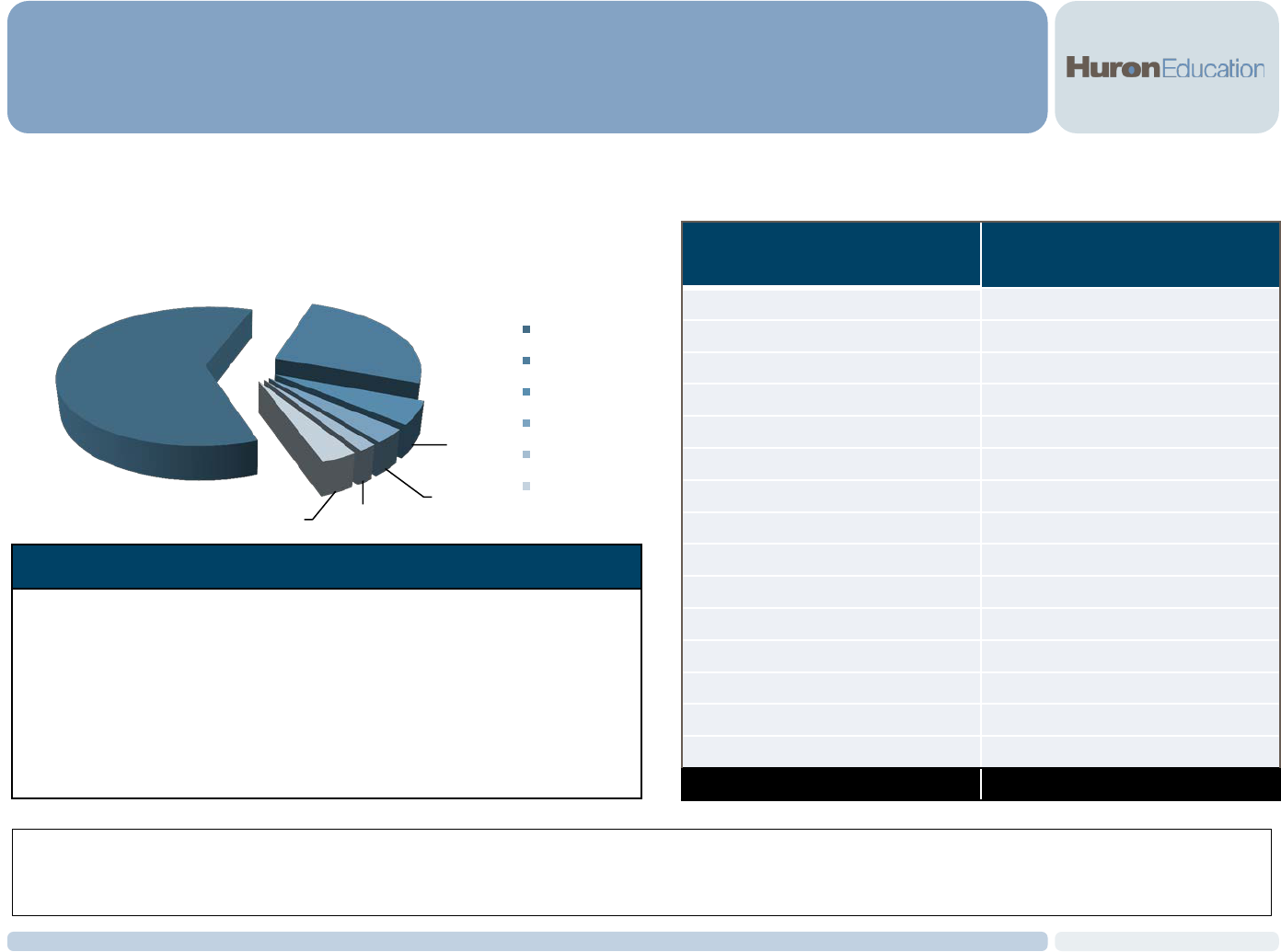
© 2015 Huron Consulting Group. All Rights Reserved. Proprietary & Confidential.
79
HEWLETT-PACKARD SPEND OVERVIEW
Business Case #3
Hewlett-Packard spend varies significantly across UW Institutions, and many vendors currently supply the
UWS with Hewlett-Packard merchandise.
Institution: Total Approximate HP Spend
(000’s)
Colleges / Extension
$143
Eau Claire
$140
Green Bay
$291
La Crosse
$84
Milwaukee
$240
Madison
$1,085
Oshkosh
$837
Parkside
$ 21
Platteville
$432
River Falls
$58
Stout
$1,983
Stevens Point
$1,094
Superior
$77
Whitewater
$1,234
Cities, Counties, Fed, State, etc.
$131
Total
$7,851
There may be an opportunity to achieve savings by consolidating all Hewlett-Packard spend to a single vendor.
Source: April 2014-March 2015 Financial Data Provided by UWSA
Current State Assessment and Observations
• Approximately $7.9M is spent on Hewlett-Packard merchandise
across the UW System; however, only approximately $4.9M, or 61%,
of the merchandise is purchased directly from Hewlett-Packard
• UW Stout, UW Stevens Point, and UW Whitewater are among the
highest spenders of HP merchandise across UWSA, accounting for
approximately 55% of total HP spend
• There are at least 19 vendors that provide the UWS with HP goods
4,777
2,002
417
253
137
265
HP Spend by Vendor ($000’s)
Hewlett-Packard
Staples
Vanguard Computers
Camera Corner
Southern Computer
Warehouse
Other
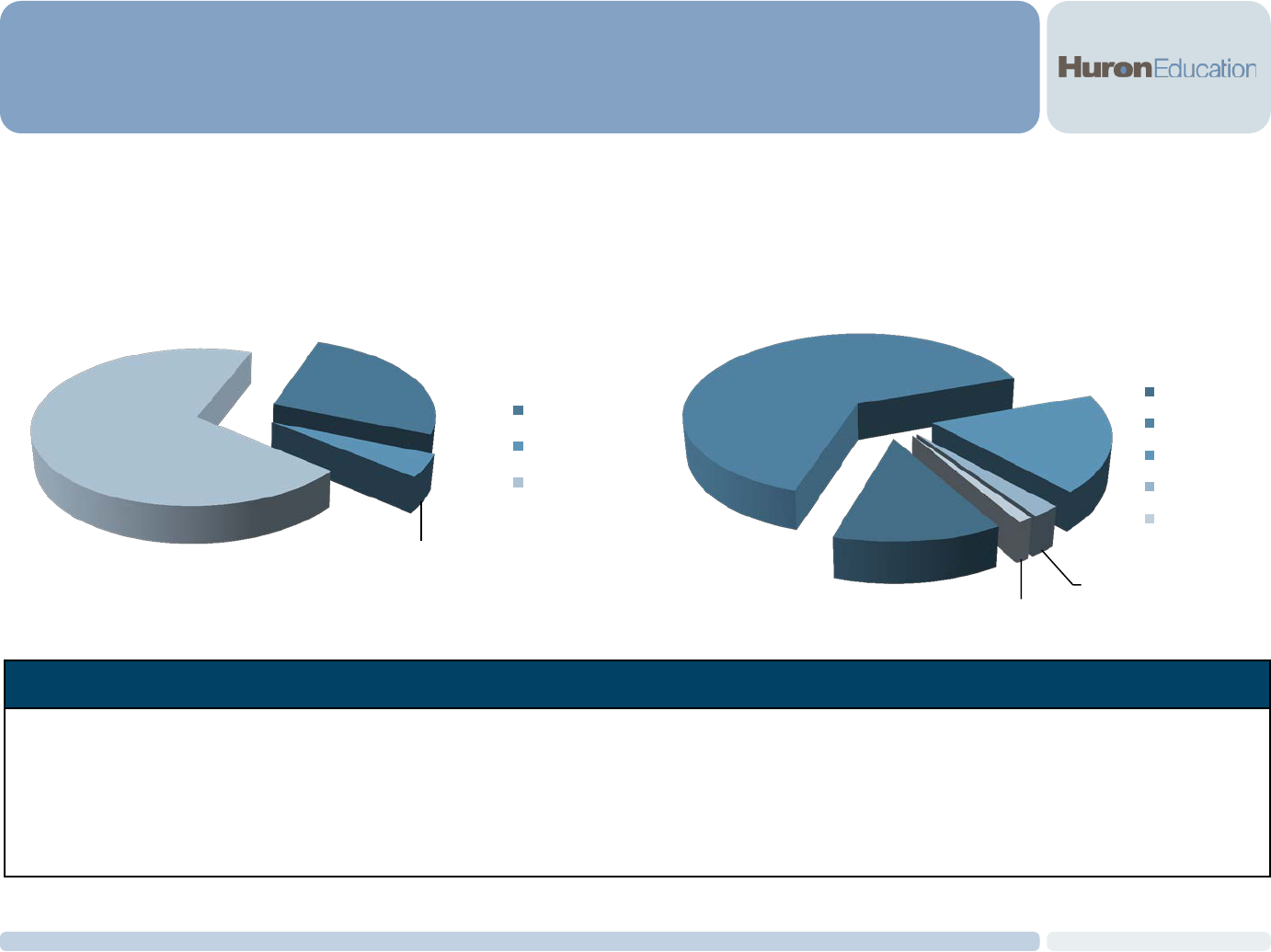
© 2015 Huron Consulting Group. All Rights Reserved. Proprietary & Confidential.
80
HEWLETT-PACKARD SPEND BY PRODUCT CATEGORY
Business Case #3
Source: April 2014-March 2015 Financial Data Provided by UWSA
Spend with HP is divided into five primary categories including Desktop, Laptop, Workstation, IT Peripherals,
and Unclassifiable, which included items that Huron was unable to classify due to deficient data.
$1,026
$5,088
$1,464
$179
$93
HP Spend By Product Category ($000’s)
Desktop
IT Peripherals
Laptop
Unclassifiable
Workstation
Observations
• The majority of Hewlett-Packard merchandise is purchased through the SFS, accounting for approximately $5.4M (70% of total
HP spend)
• UW purchased approximately $2.5M worth of HP desktops and laptops (32% of total HP spend)
• Due to blanket order purchases (purchases of multiple machines) and deficient description data, Huron was unable to classify
close to $180K worth of HP spend
$2,024
$368
$5,458
HP Spend By Purchasing Method ($000’s)
MDS
P-card
SFS
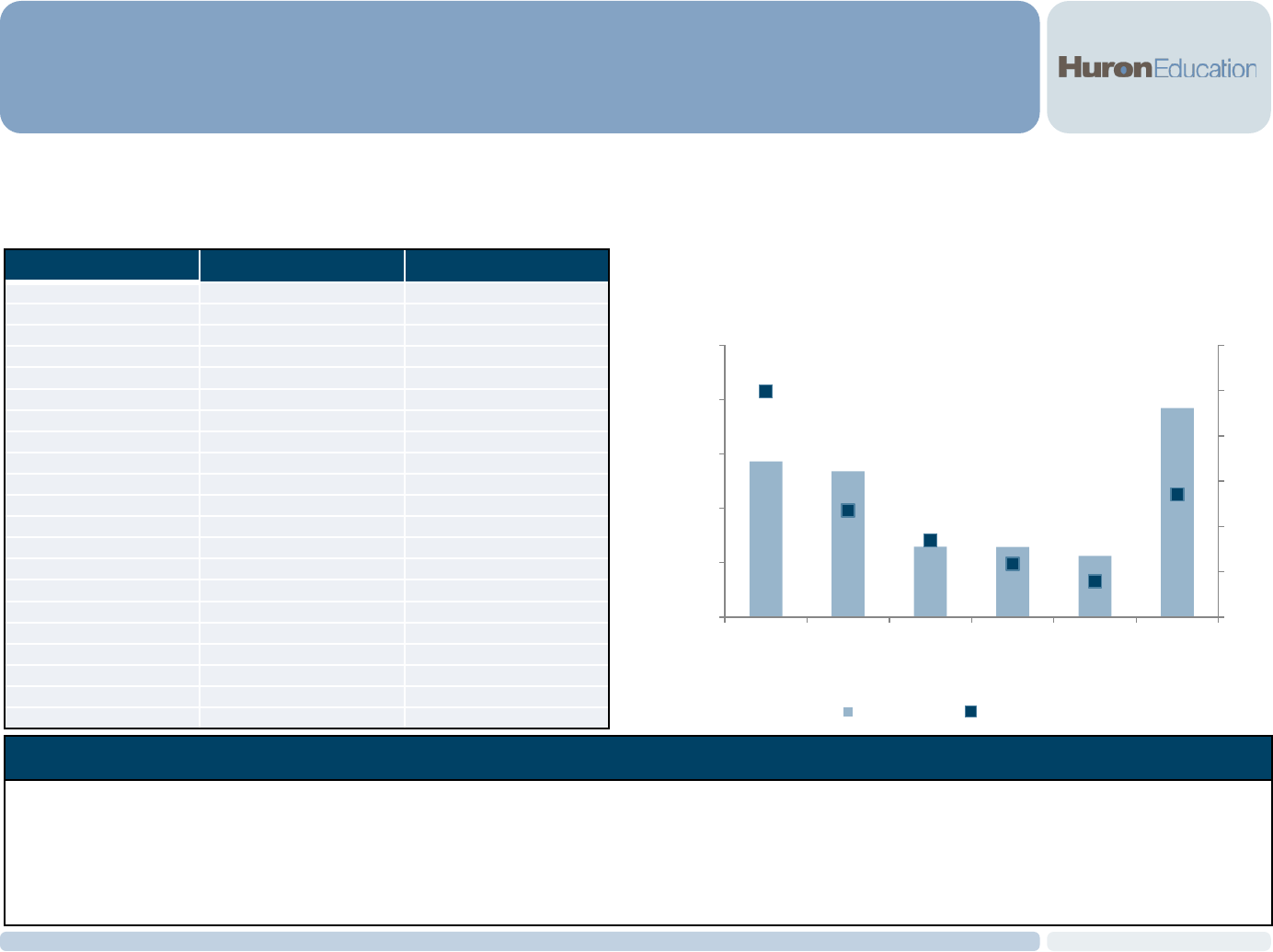
© 2015 Huron Consulting Group. All Rights Reserved. Proprietary & Confidential.
81
HEWLETT-PACKARD LAPTOP OVERVIEW
Business Case #3
Huron analyzed FY14 spend data provided by Hewlett-Packard and identified 21 different laptop models
purchased directly from HP by UW Institutions.
498
235
169
117
79
271
0
100
200
300
400
500
600
$0
$50,000
$100,000
$150,000
$200,000
$250,000
HP
EliteBook
8470p
HP
EliteBook
850 G1
HP
EliteBook
8570p
HP
EliteBook
840 G1
HP
EliteBook
9470m
Other
FY14 Total HP Laptop Spend and Number of
Units Purchased by Model
Total Spend Quantity Purchased
Observations
• There were 21 different laptop models were purchased with a weighted-average price ranging from $240-$2,965
• The most commonly purchased laptop across UWS purchased directly from HP is the HP EliteBook 8470p, accounting for 498 total machines and
approximately 22% of total HP laptop spend
• Weighted-average prices per unit for laptop models vary significantly indicating that a cost savings opportunity exists through model standardization and
improved demand management.
Source: FY14 Data (July 2013-June 2014) Provided by Hewlett-Packard, Weighted Average Unit Prices were calculated using the number of machines purchased at each different unit price
Laptop Model: Quantity Purchased Weighted-Avg. Price/Unit
HP EliteBook 8470p
498 $411
HP EliteBook 850 G1
235 $570
HP EliteBook 8570p
169 $383
HP EliteBook 840 G1
117 $575
HP EliteBook 9470m
79 $711
HP EliteBook Revolve 810
54 $766
HP EliteBook 820 G1
33 $627
HP EliteBook 2570p
30 $475
HP Pav 14 Chromebook
30 $299
HP ProBook 6570b
26 $274
HP EliteBook Revolve 810 G2
22 $846
HP ProBook 650 G1
16 $443
HP ProBook 6470b
15 $253
HP EliteBook 8770w
15 $2,966
HP ProBook 640 G1
11 $240
HP ZBook 17
7 $2,132
HP EliteBook 8570w
4 $840
HP EliteBook 2170p
3 $723
HP ZBook 15
3 $514
HP EliteBook Folio 1040 G1
1 $860
HP Chromebook 11
1 $279
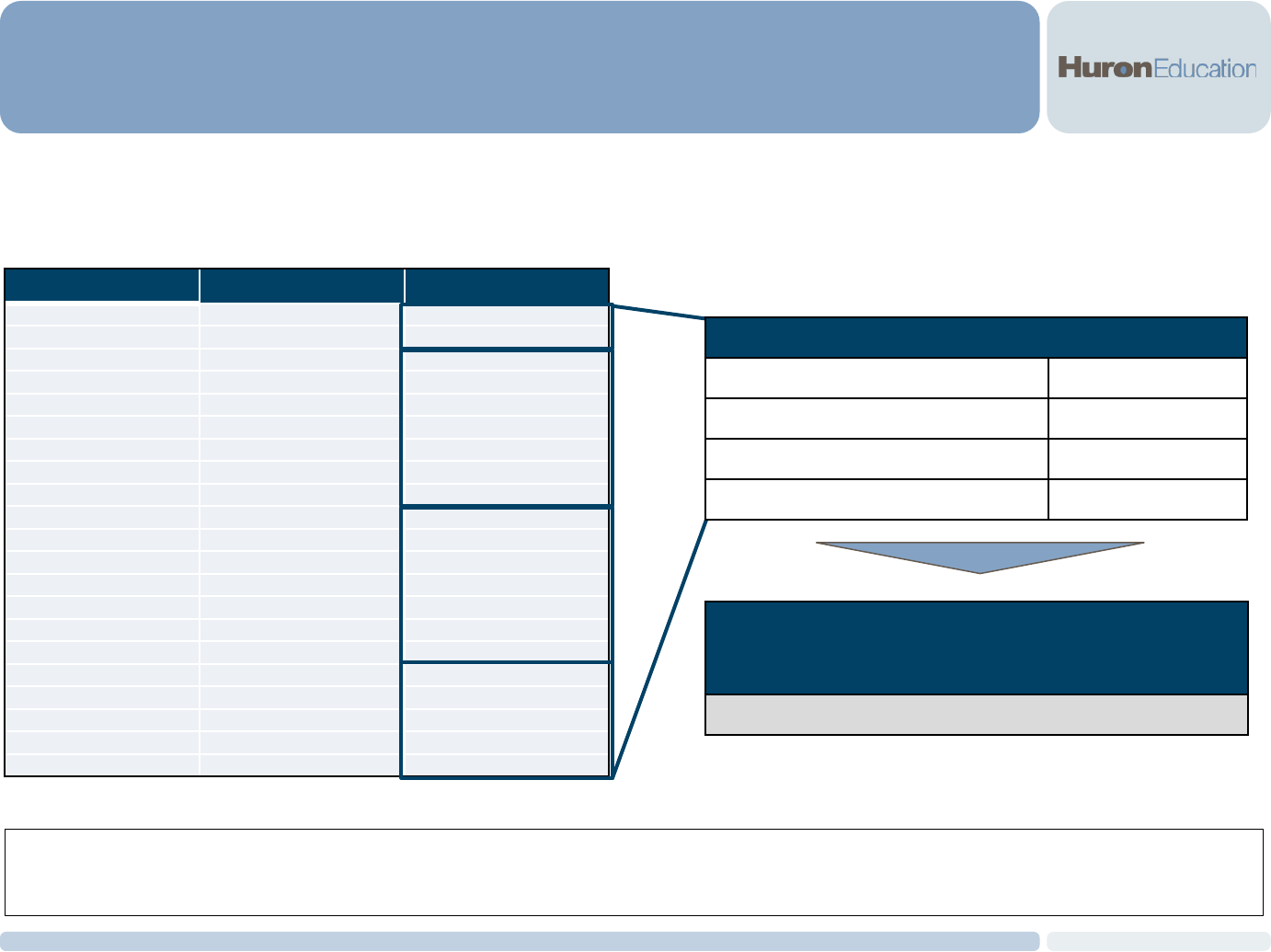
© 2015 Huron Consulting Group. All Rights Reserved. Proprietary & Confidential.
Laptop Model: Quantity Purchased Weighted-Avg. Price/Unit
HP EliteBook 8770w
15 $2,966
HP ZBook 17
7 $2,132
HP EliteBook Folio 1040 G1
1 $860
HP EliteBook Revolve 810 G2
22 $846
HP EliteBook 8570w
4 $840
HP EliteBook Revolve 810
54 $766
HP EliteBook 2170p
3 $723
HP EliteBook 9470m
79 $711
HP EliteBook 820 G1
33 $627
HP EliteBook 840 G1
117 $575
HP EliteBook 850 G1
235 $570
HP ZBook 15
3 $514
HP EliteBook 2570p
30 $475
HP ProBook 650 G1
16 $443
HP EliteBook 8470p
498 $411
HP EliteBook 8570p
169 $383
HP Pav 14 Chromebook
30 $299
HP Chromebook 11
1 $279
HP ProBook 6570b
26 $274
HP ProBook 6470b
15 $253
HP ProBook 640 G1
11 $240
82
HEWLETT-PACKARD LAPTOP SAVINGS OPPORTUNITY
Business Case #3
Huron estimates that the UW could achieve a small amount of savings by creating 4 standardized HP laptop
bundles in varying price ranges and ensuring that those are the models purchased by UWS employees.
Savings were based on approximately $650K of total HP laptop spend across UWS. The System may be able to achieve
additional cost savings by negotiating higher discounts for standardized laptop models or consolidating vendors.
Source: FY14 Data (July 2013-June 2014) Provided by Hewlett-Packard, Weighted Average Unit Prices were calculated using the number of machines purchased at each different unit price
1
2
3
4
Estimated savings achievable by establishing 1
standardized model for each group at the group’s weighted-
average price point
$
Weighted-Average Price for Groups
Group 1 $2700
Group 2 $731
Group 3 $462
Group 4 $275
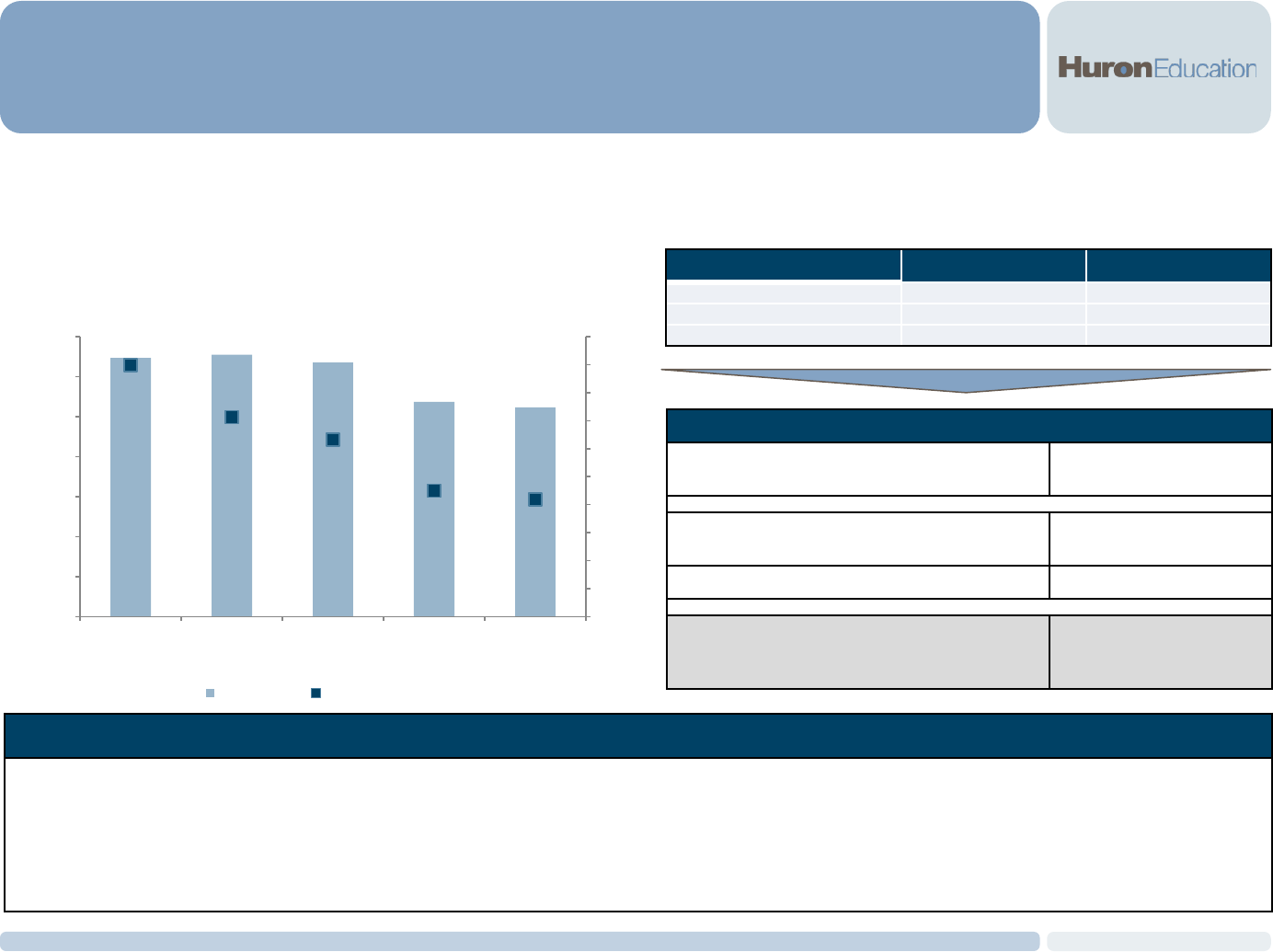
© 2015 Huron Consulting Group. All Rights Reserved. Proprietary & Confidential.
83
HEWLETT-PACKARD MONITOR OVERVIEW AND SAVINGS OPPORTUNITY
Business Case #3
Based on analysis of FY14 spend data provided by HP, Huron estimates that UWS could achieve small
savings by standardizing on the top 3 HP monitor models.
449
356
316
225
209
-
50
100
150
200
250
300
350
400
450
500
$0
$10,000
$20,000
$30,000
$40,000
$50,000
$60,000
$70,000
20-inch Flat Panel
Monitor (3-3-3)
21.5-inch Flat
Panel Monitor (3-
3-3)
23-inch Flat Panel
Monitor (3-3-3)
24-inch Flat Panel
Monitor (3-3-3)
Other
FY14 Total HP Monitor Spend and Number of Units
Purchased by Model
Total Spend Quantity Purchased
Observations
• The most commonly purchased HP monitor across the UWS is the 20-inch Flat Panel Monitor, accounting for 449 machines and approximately 27.5% of
total HP monitor spend
• 19 different HP monitor models were purchased in FY14, with weighted average prices ranging from $144 to $599
• Weighted-average prices per unit for HP monitor models vary significantly indicating that a cost savings opportunity exists through model standardization
and improved demand management
Monitor Model: Quantity Purchased Weighted-Avg. Price/Unit
20-inch Flat Panel Monitor (3-3-3) 449 $144
21.5-inch Flat Panel Monitor (3-3-3) 356 $184
23-inch Flat Panel Monitor (3-3-3) 316 $201
HP Monitor Savings Through Model Standardization
Weighted-Average Price per Unit for Top 3 Models
Purchased
$173
Total Number of Units Purchased Outside of the Top 3
Models
434
Total Spend Outside of Top 3 Models $106K
Estimated Annual Savings by Moving All Purchases
with Prices Greater than $173 to a Top 3 Model at a
Weighted-Average Price of $172
$
Source: FY14 Data (July 2013-June 2014) Provided by Hewlett-Packard, Weighted Average Unit Prices were calculated using the number of machines purchased at each different unit price
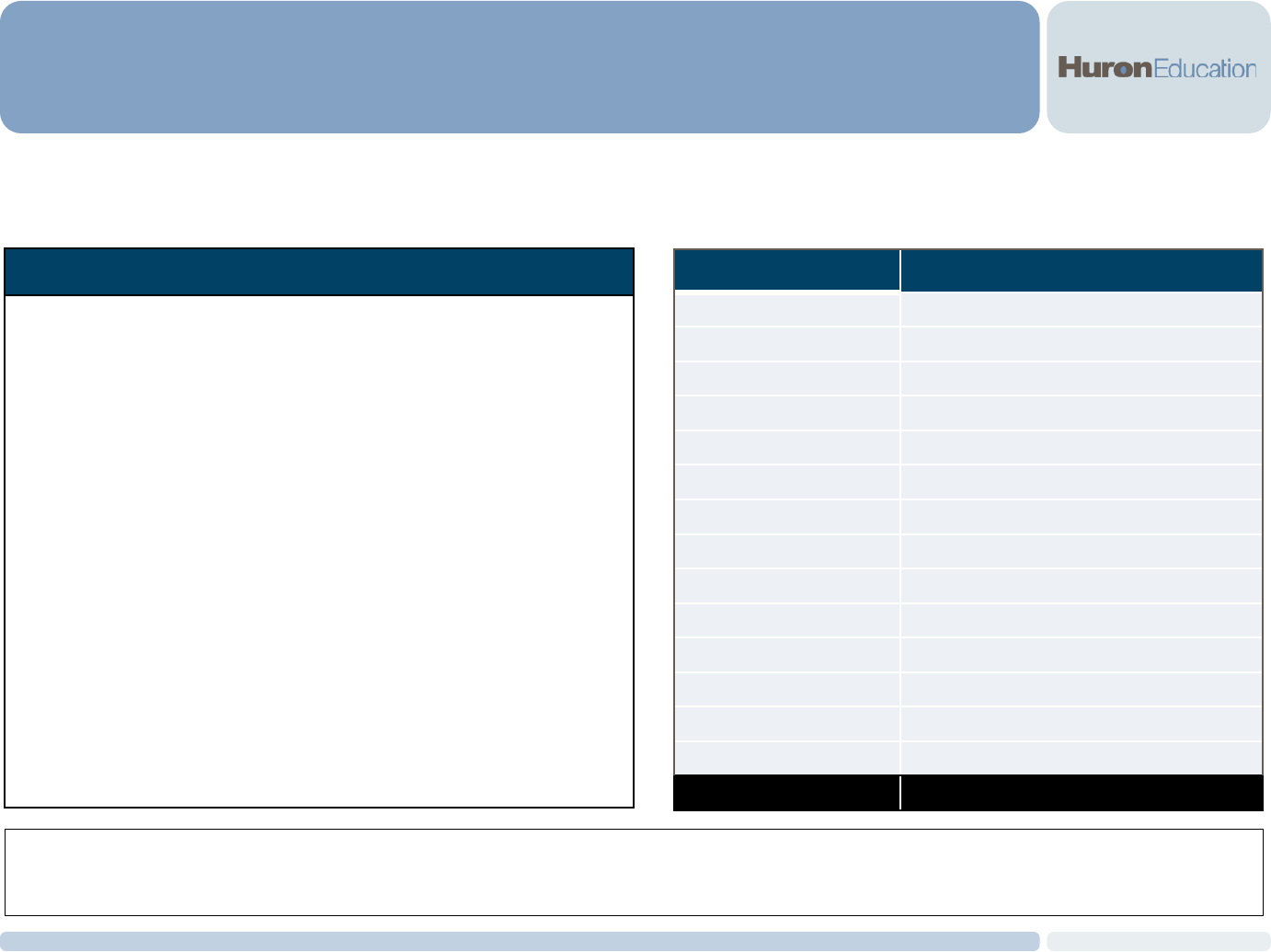
© 2015 Huron Consulting Group. All Rights Reserved. Proprietary & Confidential.
84
APPLE SPEND OVERVIEW
Business Case #3
Huron estimates that close to $3.5M was spent on Apple products between April 2014 and March 2015, with
UW-LAC, UW-OSH, and UW-WTW accounting for approximately 44% of total spend.
Institution: Total Approximate Apple Spend (000’s)
Colleges / Extension
$43
Eau Claire
$242
Green Bay
$173
La Crosse
$602
Milwaukee
$292
Madison
$254
Oshkosh
$481
Parkside
$75
Platteville
$105
River Falls
$165
Stout
$208
Stevens Point
$330
Superior
$58
Whitewater
$432
Total
$3,461
Typically, it difficult to obtain discounts on Apple products, however, the UW should consider moving buyers towards
competing products for which the UW has been able to obtain discounts.
Source: April 2014-March 2015 Financial Data Provided by UWSA, Apple Items Purchased for Resale Excluded from Totals
Current State Assessment and Observations
• Close to $3.5M is spent on Apple merchandise across the
UW
• UW La Crosse, UW Oshkosh, and UW Whitewater are
among the highest purchasers of Apple products
• Over $1.1M worth of Apple spend was unclassifiable, as the
invoice description data was either absent or insufficient to
determine the type of merchandise being purchased
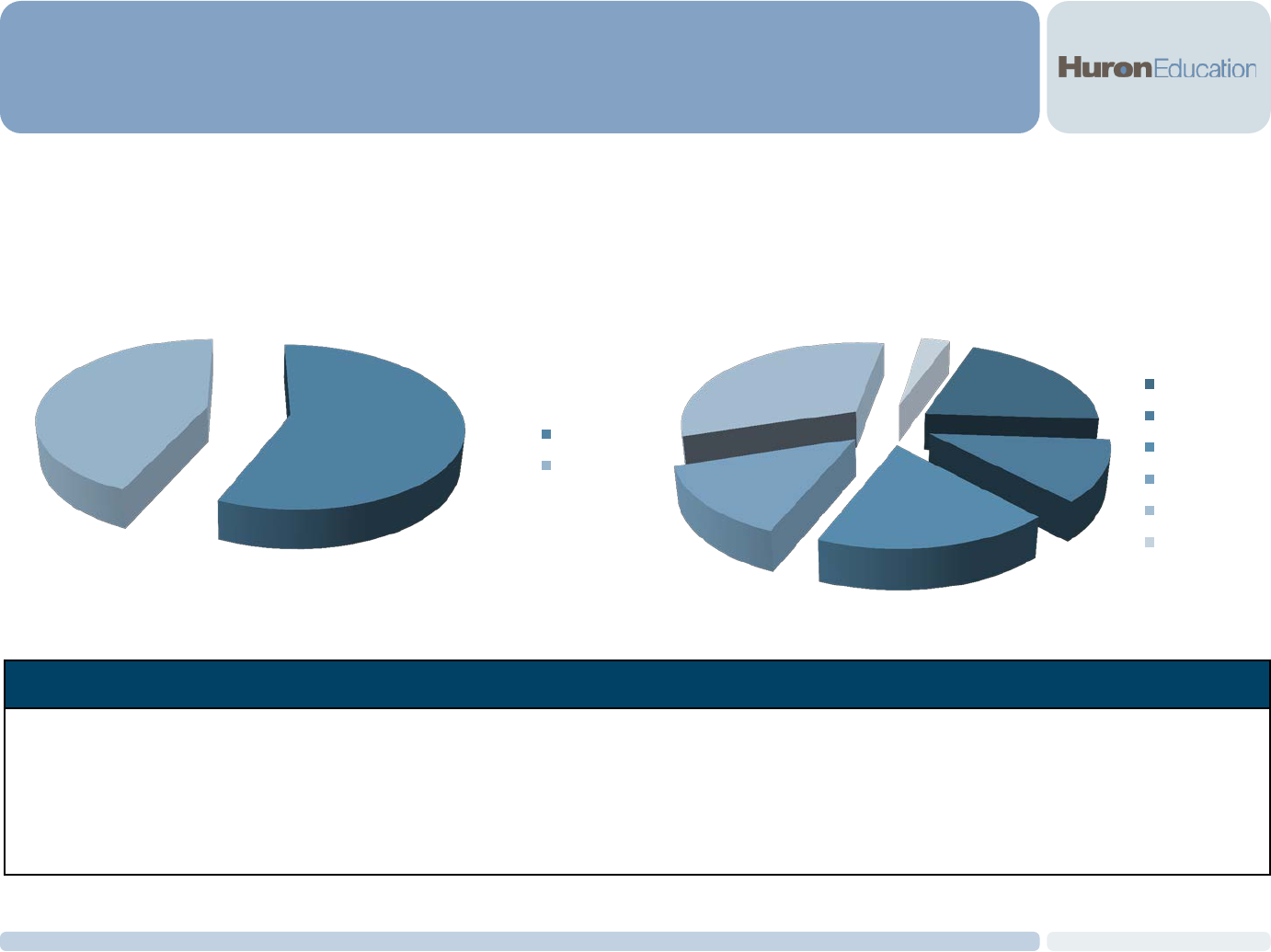
© 2015 Huron Consulting Group. All Rights Reserved. Proprietary & Confidential.
85
APPLE SPEND BY PRODUCT CATEGORY
Business Case #3
Source: April 2014-March 2015 Financial Data Provided by UWSA
Spend with Apple is divided into six primary product categories including Desktops, Laptops, iPads,
Warranties, IT Peripherals, and spend that Huron was unable to classify due to missing description data.
$709
$410
$636
$481
$1,120
$106
Apple Spend By Product Category ($000’s)
Desktop
iPad
IT Peripherals
Laptop
Unclassifiable
Warranty
$1,956
$1,505
Apple Spend By Purchasing Method ($000’s)
P-card
SFS
Observations
• The majority of Apple merchandise is purchased with P-cards, accounting for 57% of total Apple spend at ~$2.0M
• UWS spends approximately $1.2M on Apple desktops and laptops, accounting for approximately 34% of total Apple spend
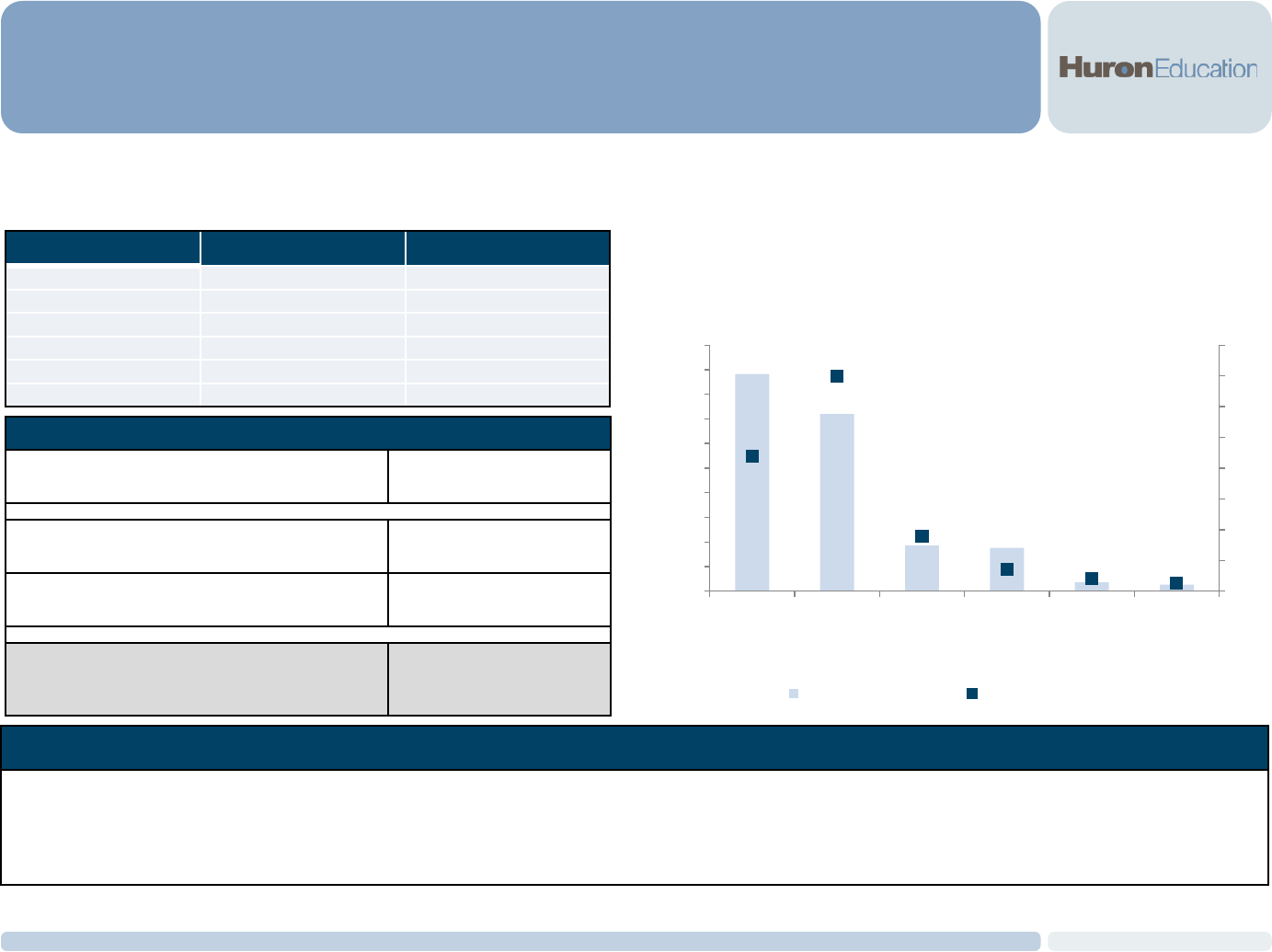
© 2015 Huron Consulting Group. All Rights Reserved. Proprietary & Confidential.
86
APPLE LAPTOP OVERVIEW AND SAVINGS OPPORTUNITY
Business Case #3
Huron estimates that UWS could achieve cost savings by limiting Apple laptop purchases to either the
Macbook Pro 13 Inch or the Macbook Air 13 Inch models.
88
140
36
14
8
5
0
20
40
60
80
100
120
140
160
$0
$20,000
$40,000
$60,000
$80,000
$100,000
$120,000
$140,000
$160,000
$180,000
$200,000
Macbook
Pro 15 Inch
Macbook
Pro 13 Inch
Macbook Air
13 Inch
Macbook
Pro
Unknown
Macbook Air
11 Inch
Macbook Air
Unknown
Total Apple Laptop Spend & Number of Laptops
Purchased by Model
Total Laptops Spend Number of Laptops
Source: April 2014-March 2015 Financial Data Provided by UWSA
Laptop Model: Quantity Purchased Weighted-Avg. Price/Unit
Macbook Pro 13 Inch
140 $1,029
Macbook Pro 15 Inch
88 $2,006
Macbook Air 13 Inch
36 $1,032
Macbook Pro Unknown
14 $2,509
Macbook Air 11 Inch
8 $908
Macbook Air Unknown
5 $1,047
Apple Laptop Savings Through Model Standardization
Weighted-Average Price per Unit for Macbook Pro 13
Inch and Macbook Air 13 Inch
$1,030
Total Number of Units Purchased Outside of Chosen 2
Models with Prices Greater than $1,030
107
Total Spend Outside of Chosen 2 Models with Prices
Greater than $1,030
$217K
Estimated Annual Savings by Moving 50% of
Purchases Outside of Chosen 2 Models with Prices
Greater than $1,030 to one of the 2 Chosen Models
$
Observations
• Huron estimates that over $400K was spent on Apple laptops during the timeframe used for the analysis
• Huron was unable to identify Apple laptop models for approximately $48K in spend
• The most commonly purchased Apple laptop purchased was the 13 inch Macbook Pro, accounting for approximately 36% of total Apple laptop spend
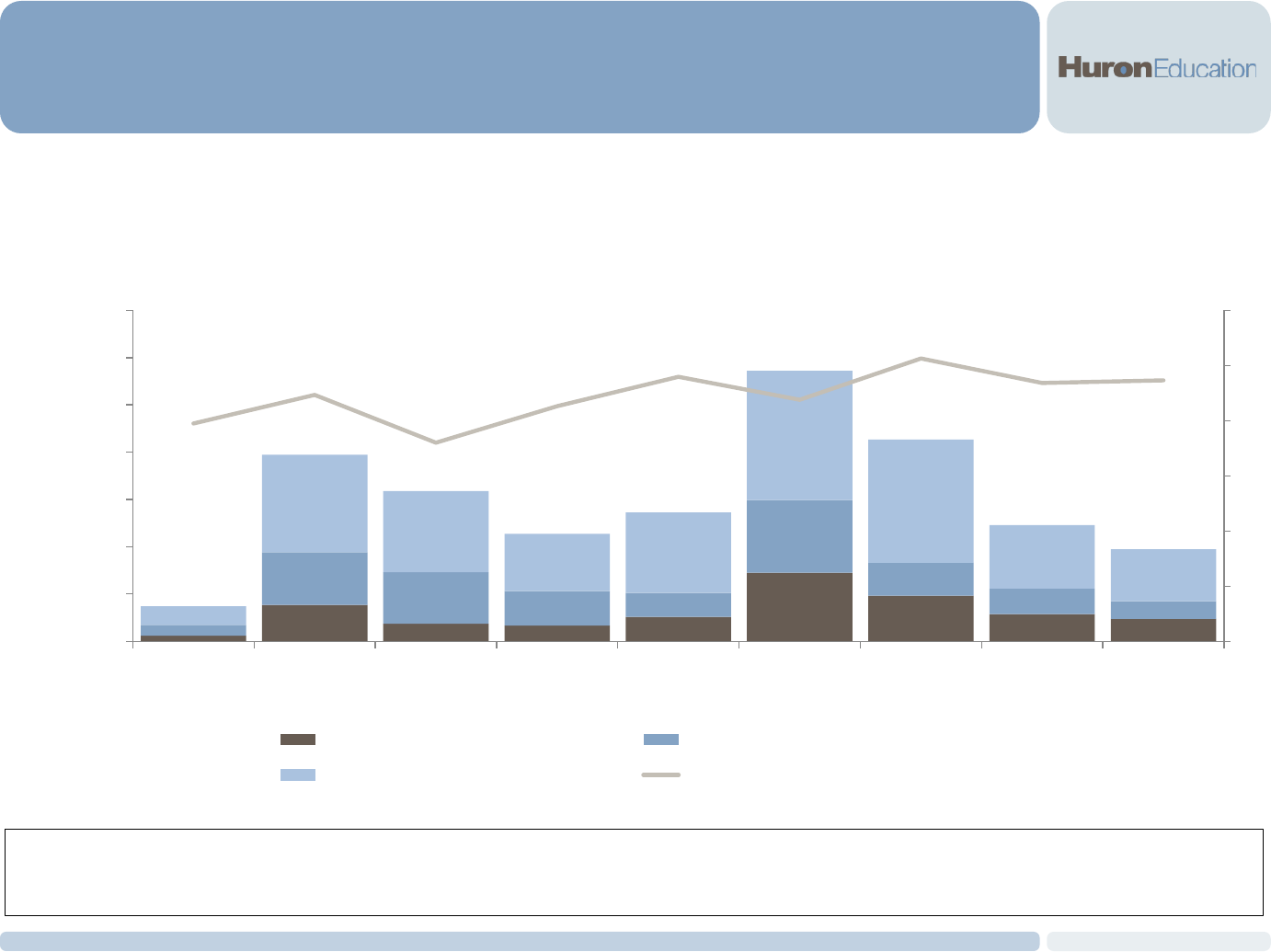
© 2015 Huron Consulting Group. All Rights Reserved. Proprietary & Confidential.
87
SAVINGS CASE STUDY
Business Case #3
UW Madison negotiated a contract with Dell which has allowed the University to realize additional savings
of approximately $1.1M over the previous 2 years.
$23K
$154K $74K $66K $103K $290K $193K $115K $95K
39%
45%
36%
43%
48%
44%
51%
47%
47%
$-
$200,000
$400,000
$600,000
$800,000
$1,000,000
$1,200,000
$1,400,000
Q3
2013
Q4 Q1
2014
Q2 Q3 Q4 Q1
2015
Q2 Q3
Savings from Purchases of UW-Preferred Dell Computers, March 2013-March 2015
Actual Savings on Preferred Computers Estimated Forgone Dell Savings
Estimated Forgone Apple Savings Adoption Rate
Source: Estimated Savings provided by UW Madison
Savings were based on approximately $3.8M of Dell Preferred spend; in addition, UW Madison estimates that
approximately $4.3M of additional savings were forgone through Non-Preferred Dell and Apple purchases.
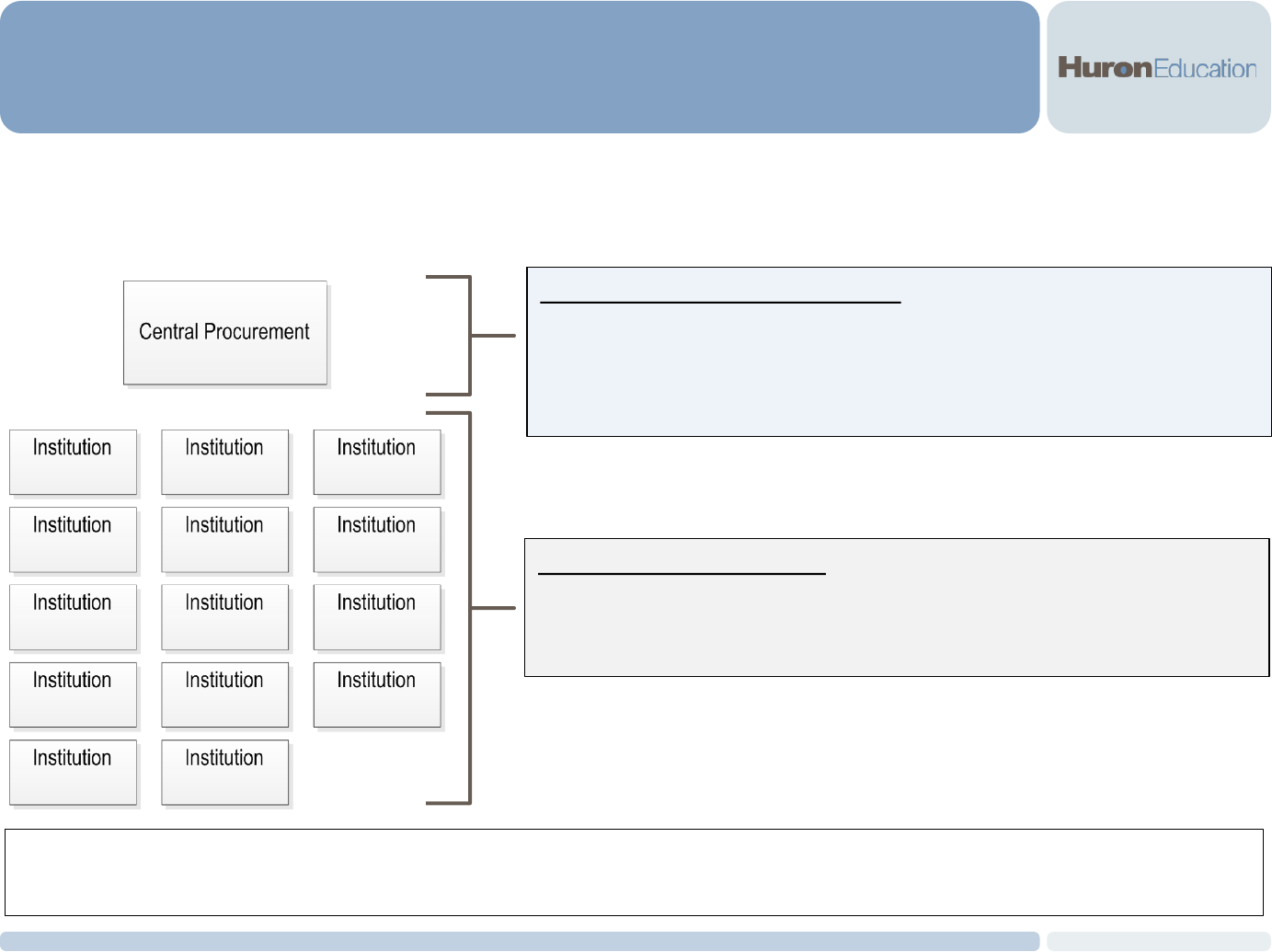
© 2015 Huron Consulting Group. All Rights Reserved. Proprietary & Confidential.
88
COLLABORATIVE PROCUREMENT FUNCTION
Business Case #3
The UW should develop a centralized procurement office that negotiates contracts, establishes policies and
procedures, enforces demand management, and ensures policy review and compliance.
System-wide Procurement Function
• Develop a robust, system-wide procurement function to centrally
negotiate contracts and manage high-spend vendors with highly trained
procurement staff to take advantage of the purchasing power of the
entire UW System
Distributed Representatives:
• Individuals from each campus would, where appropriate, aid in
identifying high-spend vendors and coordinate with campuses to
evaluate negotiating leverage
A system-wide procurement function does not necessarily need to be located at UWSA, however, there should be a
central organizational effort to negotiate system-wide contracts and establish system-wide policies and standards.
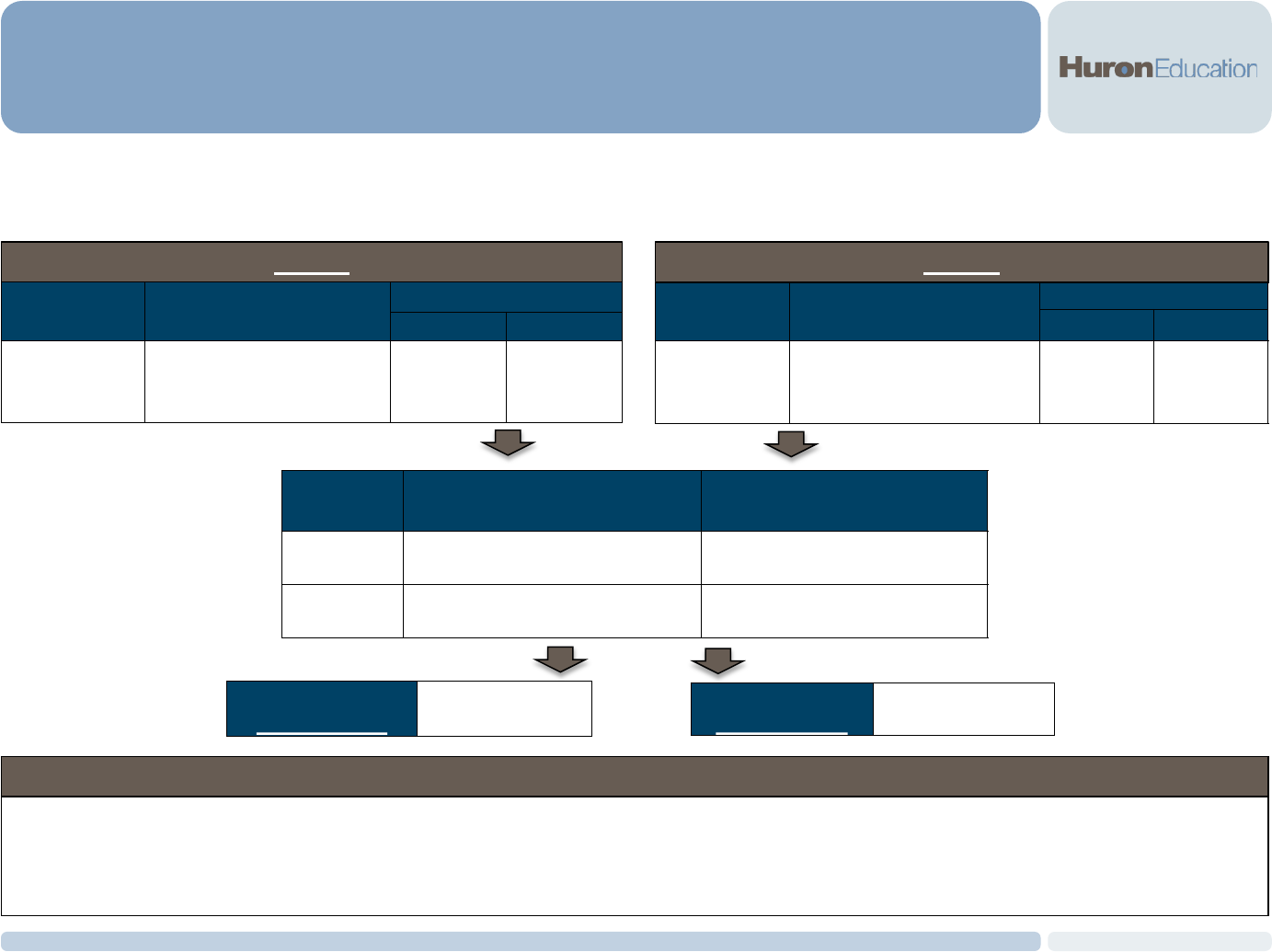
© 2015 Huron Consulting Group. All Rights Reserved. Proprietary & Confidential.
89
NEXT STEPS
Business Case #3
Huron estimates that UWS could achieve significant costs savings through laptop, desktop, and IT
peripheral standardization, and by renegotiating contracts to receive additional price discounts.
General Sourcing Tactics
• Consolidate non-Apple Laptop and Desktop spend to one primary vendor
• Use policy, marketing efforts, and contract tracking and analysis to drive utilization of established contract(s)
• Review competitiveness of current pricing
• Review demand patterns to identify opportunities to change service levels with minimal impact to end user
Option A
Option B
Area Opportunity Overview
Est. 5 Year Savings ($M)
Low High
IT Hardware
Laptop, Desktop, and
Peripheral Model
Standardization
$$ $$$
Area Opportunity Overview
Est. 5 Year Savings ($M)
Low High
IT Hardware
Standard Bundle Creation,
Vendor Consolidation, and
Apple Demand Management
$$ $$$
Area Opportunity Overview
Est. 5 Year Savings ($M)
IT Hardware
Reduce UW-Madison Forgone
Savings
$$
Organization
System-wide Collaborative
Procurement Function
Strategic Enabler
5 Year Total Savings
Given Option A
$$-$$$
5 Year Total Savings
Given Option B
$$-$$$
1. UW-Madison Forgone Savings
Based on Reduction by 20%-
40% on a Yearly Basis
2. Apple Demand Management
Involves Shifting 20-40% of
Apple Spend to the Selected
Non-Apple Vendor
Source: *Savings Estimates Based on Analysis of Laptops, Desktops, and Monitors; Additional Savings Opportunities are Likely Available in Other Peripheral Categories

Appendix

© 2015 Huron Consulting Group. All Rights Reserved. Proprietary & Confidential.
Project Oversight
91
Committee Members
Executive Leadership Team
• Ray Cross, President, University of Wisconsin System
• David Miller, Senior Vice President for Administration & Fiscal Affairs
• Jane Radue, Executive Director & Corporate Secretary, Board of Regents
• Jessica Tormey, Chief of Staff, Office of the President
• James Villa, Vice President, University Relations
• David Ward, Interim Senior Vice President, Academic & Student Affairs
• Julie Gordon, Associate Vice President, Financial Administration
Project Management Group
• Sasi Pillay, Associate Vice President, Office of Learning and Information Technology
• Jenna Weidner, Program & Policy Analyst – Advanced, Office of Senior Vice President for Administration
• David Kieper, Interim CIO, UW Green Bay
• Elena Pokot, CIO, UW Whitewater
• Robert Beck, CIO UW Milwaukee
Advisory Committee
• Sasi Pillay, Associate Vice President, OLIT
• David Kieper, Interim CIO, UW Green Bay
• Elena Pokot, CIO, UW Whitewater
• Robert Beck, CIO UW Milwaukee
• Mohammed Elhindi, CIO, UW La Crosse
• Stephen Reed, CIO, UW River Falls
• Chip Eckhardt, CIO, UW Eau Claire
• Ilya Yakovlev, CIO, UW Parkside
• John Krogman, COO of DoIT, UW Madison
• Werner Gade, CIO, UW Colleges / Extension
• Doug Wahl, CIO, UW Stout
• Bob Hetzel, CBO, UW La Crosse
• Tom Sonnleitner, CBO, UW Oshkosh
• Rob Cramer, CBO, UW Platteville
• Greg Summers, Provost, UW Stevens Point
• Faith Hensrud, Provost, UW Superior
• Johannes Britz, Provost, UW Milwaukee
COMMITTEE MEMBERSHIP
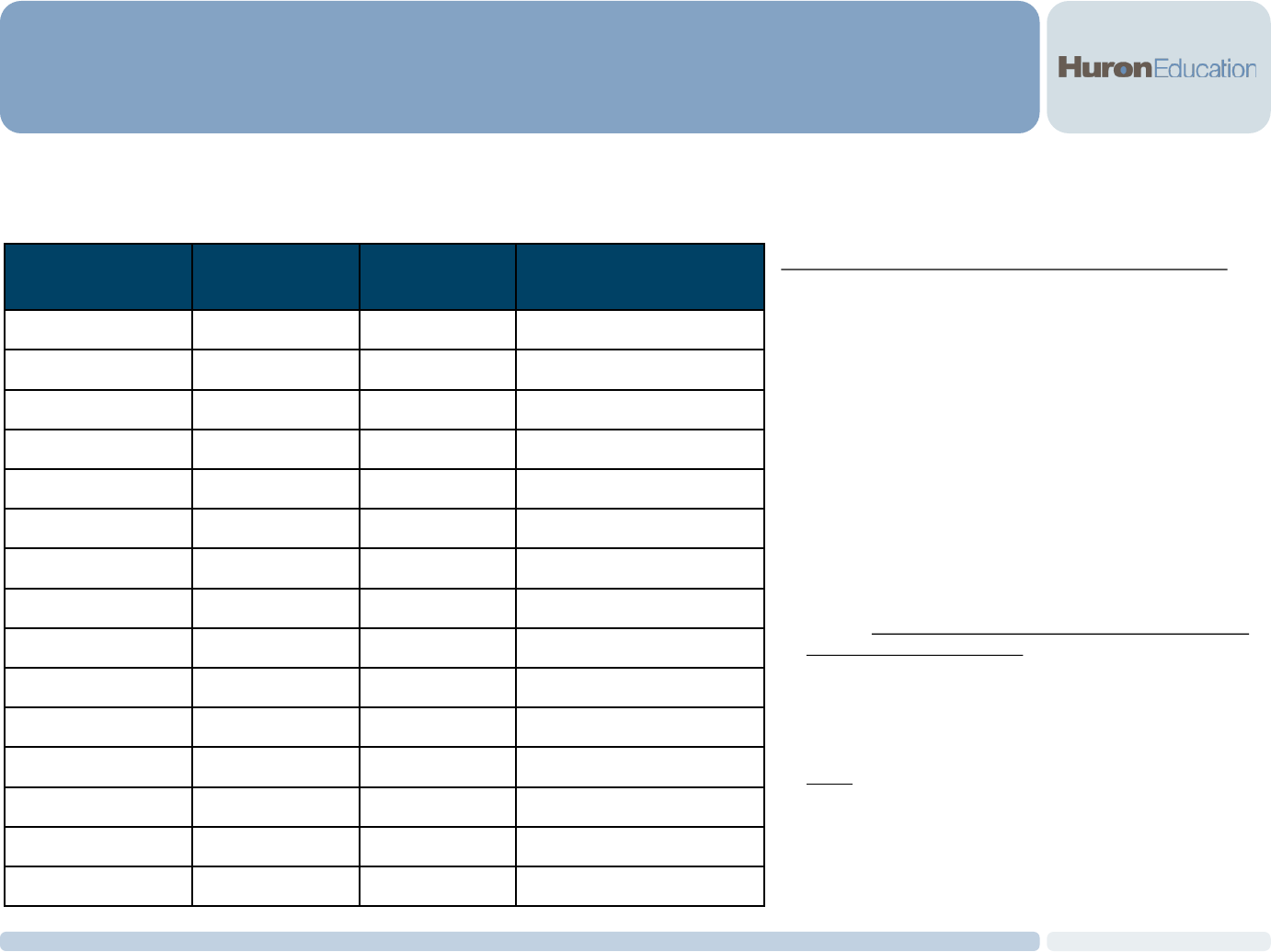
© 2015 Huron Consulting Group. All Rights Reserved. Proprietary & Confidential.
Business Case # 1
SIS FINANCIAL CONSIDERATIONS – INSTITUTIONAL CURRENT STATE COSTS
92
The following represents estimated current state infrastructure costs associated with supporting localized
hosting of SIS. Annual localized hosting costs identified through survey conducted by UWSA CIO.
Current-State and Projection Notes & Assumptions:
• Annual PeopleSoft Administration and Maintenance
costs are $900,805
• Huron analyzed work completed to date with respect to
current-state infrastructure support costs associated
with Student Information Systems.
• Discussion between CIOs and UWSA CIO indicate
base-level FTE support lowered to approximately 20
• Estimated current state costs may not fully represent
true current state due to data available at time of
analysis. Additional costs may be attributable to
hardware, etc.
• Figures do not include FTE supporting localized bolt-on
development (applications)
• Assumptions were made for certain institutions not
participating in data collection process conducted by
UWSA CIO
• Note: FTE personnel estimated assume salary and
fringe of $95,000 rather than actual amount
*Indicates institutions for which Huron made assumptions regarding current-state costs –
actual data not provided during survey or available at the time of analysis
**Includes contracted fully burdened labor
***Numbers may not add due to rounding
Institution FTE Support
FTE Costs
($000s)**
Infrastructure Costs
($000s)
Colleges* 118.3
Eau Claire 1 40 45.1
Green Bay 1.15 118.4 13.0
La Crosse 7.76 792.7 253.5
Madison 9.3 880.8 442.0
Milwaukee 1.9 213.1 8.0
Oshkosh* 1.8 129.1 4.6
Parkside 0.3 141.9
Platteville 1.2 368.8 234.0
River Falls 4 325.0 36.8
Stevens Point* 1.2 368.8 234.0
Stout 1.5 128.6 69.0
Superior* 2 141.9
Whitewater 1.8 129.1 4.6
Total 34.91 $4,000 $1,344.6

© 2015 Huron Consulting Group. All Rights Reserved. Proprietary & Confidential.
Business Case # 1
ADDITIONAL IT SERVICES AMENDABLE TO CLOUD COMPUTING
93
The advent of cloud computing has fundamentally changed the way IT services can be delivered. Additional
examples of vendor managed solutions can be found below.
Additional Cloud-based Solutions:
• Hosting of most / all current applications
• Network Hosting (e.g., VoIP)
• Website Hosting
• Datacenter Management and Storage Resources
• High Performance Computing – Via Consortium or
Third-party Vendor
• Learning Technologies (e.g., LMS)
• CRM Solutions
Change Management Considerations:
• Organizational commitment to change / development
of a long-term strategy for cloud computing
• Reduced ability to customize
• Customer support shits to vendor rather than local
staff – may result in varied response times (can be
managed via contact / SLA)
• Changes in SaaS application interfaces will occur
more often – requires staff to be open to change

© 2015 Huron Consulting Group. All Rights Reserved. Proprietary & Confidential.
Business Case #2
CURRENT STATE IT ADMINISTRATION (CONT’D)
The categories presented in the table below were used to segment University employees to determine
where overlap occurs and where alternative administration models may be implemented.
94
Types of
Cloud
IT Unit Categorization Unit Description
Client Services
• Includes campus Help Desks, hardware and software support,
IT training, computer repair, technology use consulting, asset
management, and IT service management
Network & Infrastructure Services
• Includes network management and engineering, campus
infrastructure management and maintenance, data center
management, firewall administration, and information security
Enterprise Software & Application
Services
• Includes application design, development, and support,
database administration and management, and reporting
development
Instructional Technology Services
• Includes the design, development, and evaluation of learning
technologies, and the provision of faculty and staff trainings on
instructional technology
Categorization methodologies for all UW Institutions are included in the appendix.
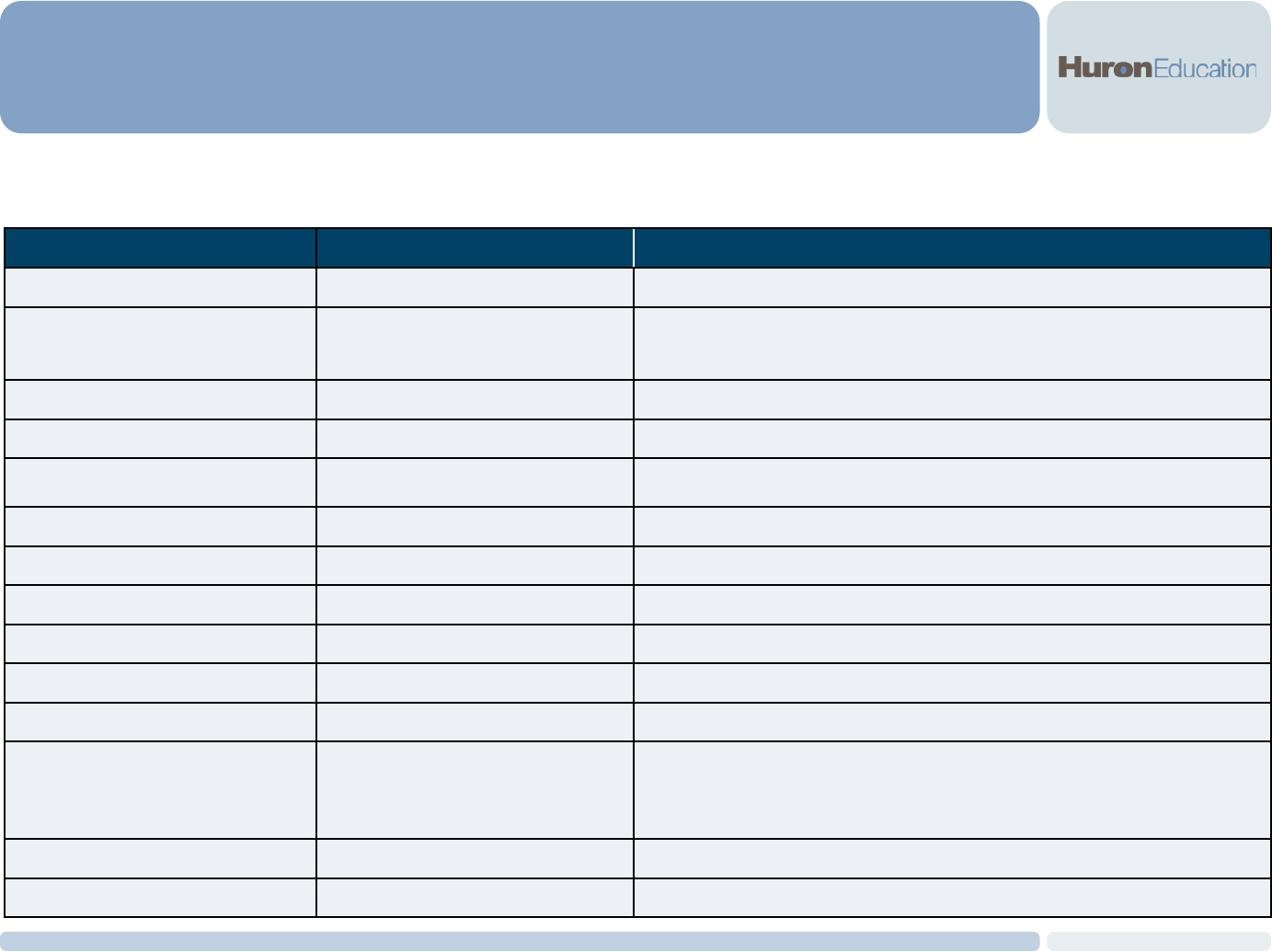
© 2015 Huron Consulting Group. All Rights Reserved. Proprietary & Confidential.
Client Services
IT CATEGORIZATION BASIS
The following institution-specific IT units were included as part of Client Services for the analysis
conducted by Huron.
95
Institution Total FTEs Institution-specific Units Included
UW Eau Claire
13.75
• Client Support Services
UW Extension/Colleges
4
• Account & Identity Management and Desktop Support (Est. 4 from
Account & Identity Management, Information Security, and Desktop
Support)
UW Green Bay
7
• User Support Services
UW La Crosse
13
• Client Services
UW Milwaukee
25
• Client Services (Excluding Classroom Services and Learning
TECHniques)
UW Madison
67.5
• User Services
UW Oshkosh
12
• Academic Computing
UW Parkside
4
• Support Services
UW Platteville
12
• Support Services
UW River Falls
4
• Professional Services
UW Stout
9
• Client Technology Services
UW Stevens Point
24.8
• Administrative Information Systems
• Workstation and Endpoint Technology
• College Support Team
• IT Support Services
UW Superior
5
• Technology Support Services
UW Whitewater
2
• User Environment Technology
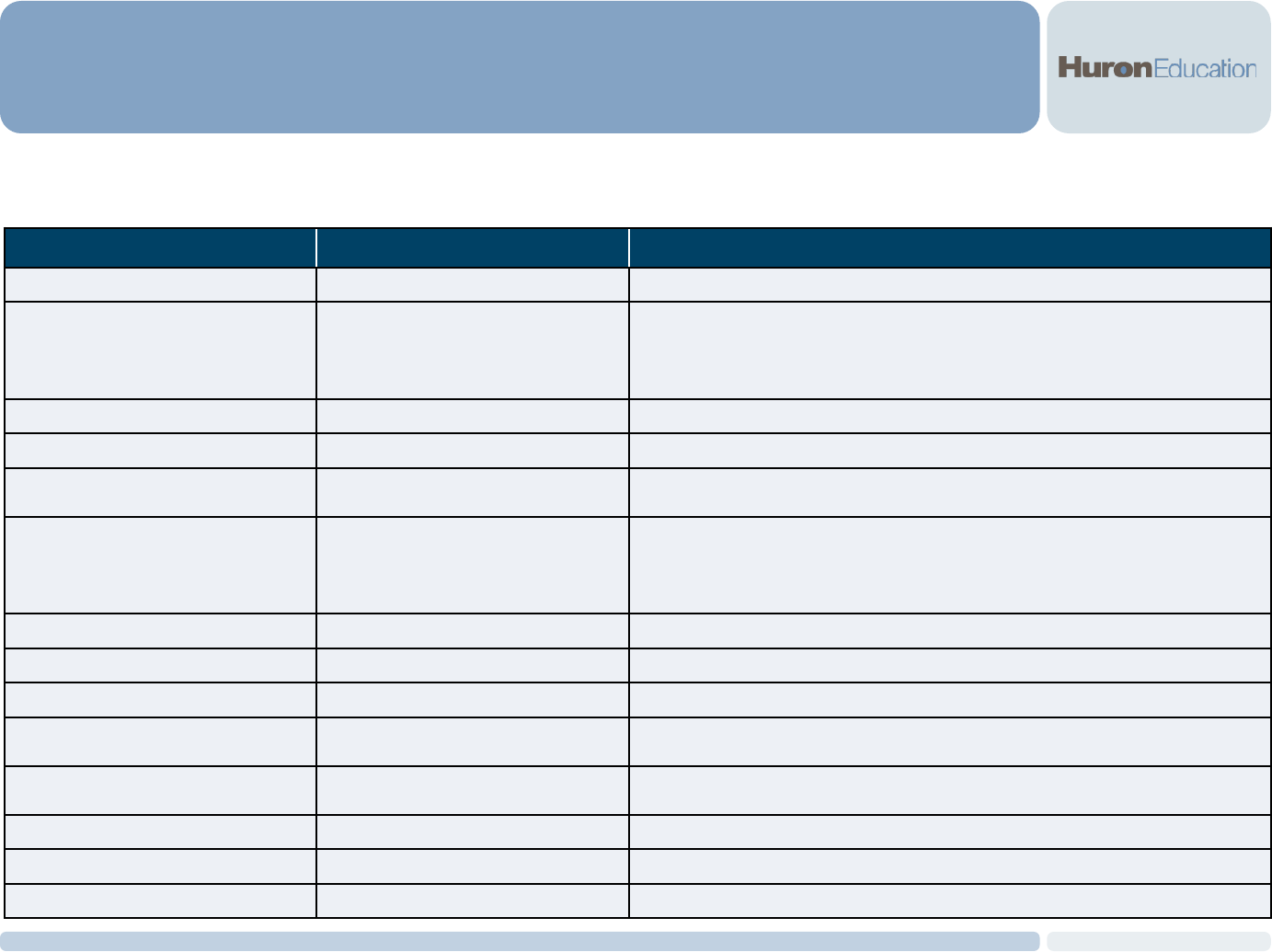
© 2015 Huron Consulting Group. All Rights Reserved. Proprietary & Confidential.
Network and Infrastructure Services
IT CATEGORIZATION BASIS
The following institution-specific IT units were included as part of Infrastructure and Network Services for
the analysis conducted by Huron.
96
Institution Total FTEs Institution-specific Units Included
UW Eau Claire
13
• Technical Support Services
UW Extension/Colleges
18.7
• Hosting, Messaging and Collaboration, and Network Management
• Network Administrator
• Information Security (Est. 2 from Account & Identity Management,
Information Security, and Desktop Support)
UW Green Bay
4
• Infrastructure and Networking Systems / Info Security
UW La Crosse
10
• Network Services
UW Milwaukee
39
• Network and Operations Services
• Information Security Office
UW Madison
204.2
• Network Services
• Systems Engineering and Operations
• Enterprise Internet Services
• Information Security Office
UW Oshkosh
7
• Networking and Security
UW Parkside
3
• Infrastructure Team
UW Platteville
12
• Systems and Infrastructure
UW River Falls
13
• Enterprise Systems and Services
• Infrastructure and Security Technologies
UW Stout
9
• Security and Network
• Telecommunications and Networking
UW Stevens Point
10
• Network and Infrastructure
UW Superior
6
• Technology Infrastructure Services
UW Whitewater
Unknown
•
Network Operations Center
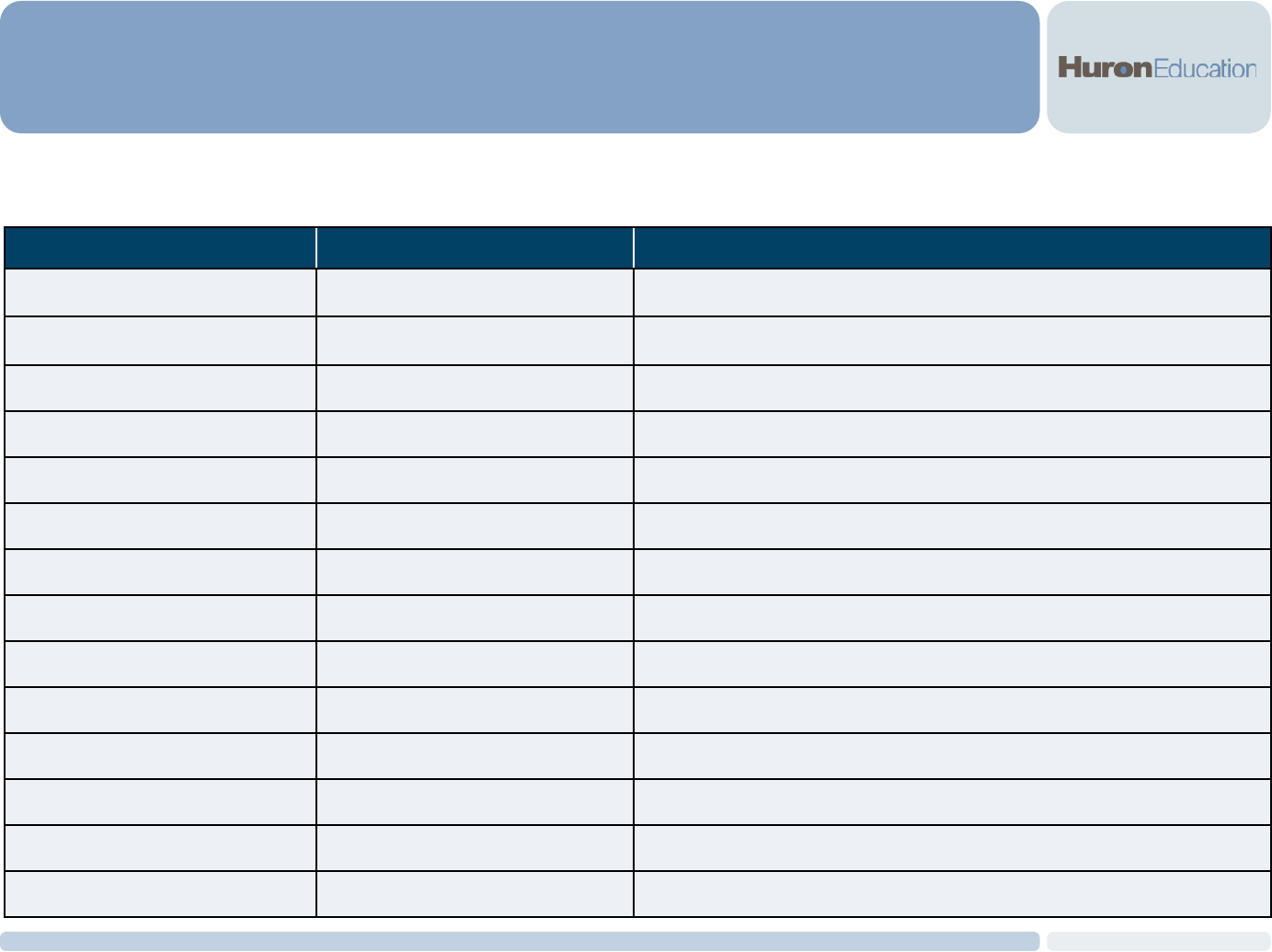
© 2015 Huron Consulting Group. All Rights Reserved. Proprietary & Confidential.
Enterprise Software and Application Services
IT CATEGORIZATION BASIS
The following institution-specific IT units were included as part of Enterprise Software and Application
Services for the analysis conducted by Huron.
97
Institution Total FTEs Institution-specific Units Included
UW Eau Claire
15.9
• Enterprise Software systems
• Projects and Software Applications
UW Extension/Colleges
1
• Application Management (Est. 1 from Learning Technology, Application
Management, and Media Services)
UW Green Bay
9.6
• Management Information Systems
UW La Crosse
4.96
• Enterprise Services
UW Milwaukee
16.8
• Application Development
UW Madison
90.7
• Application Development and Integration
UW Oshkosh
9
• Administrative Computing
UW Parkside
5
• Applications Development
UW Platteville
12
• Information Systems and Reporting
UW River Falls
10
• Enterprise Applications and Services
UW Stout
7.5
• Enterprise Information Services
UW Stevens Point
UW Superior
6
• Application Services
UW Whitewater
Unknown
• Administrative Information Services
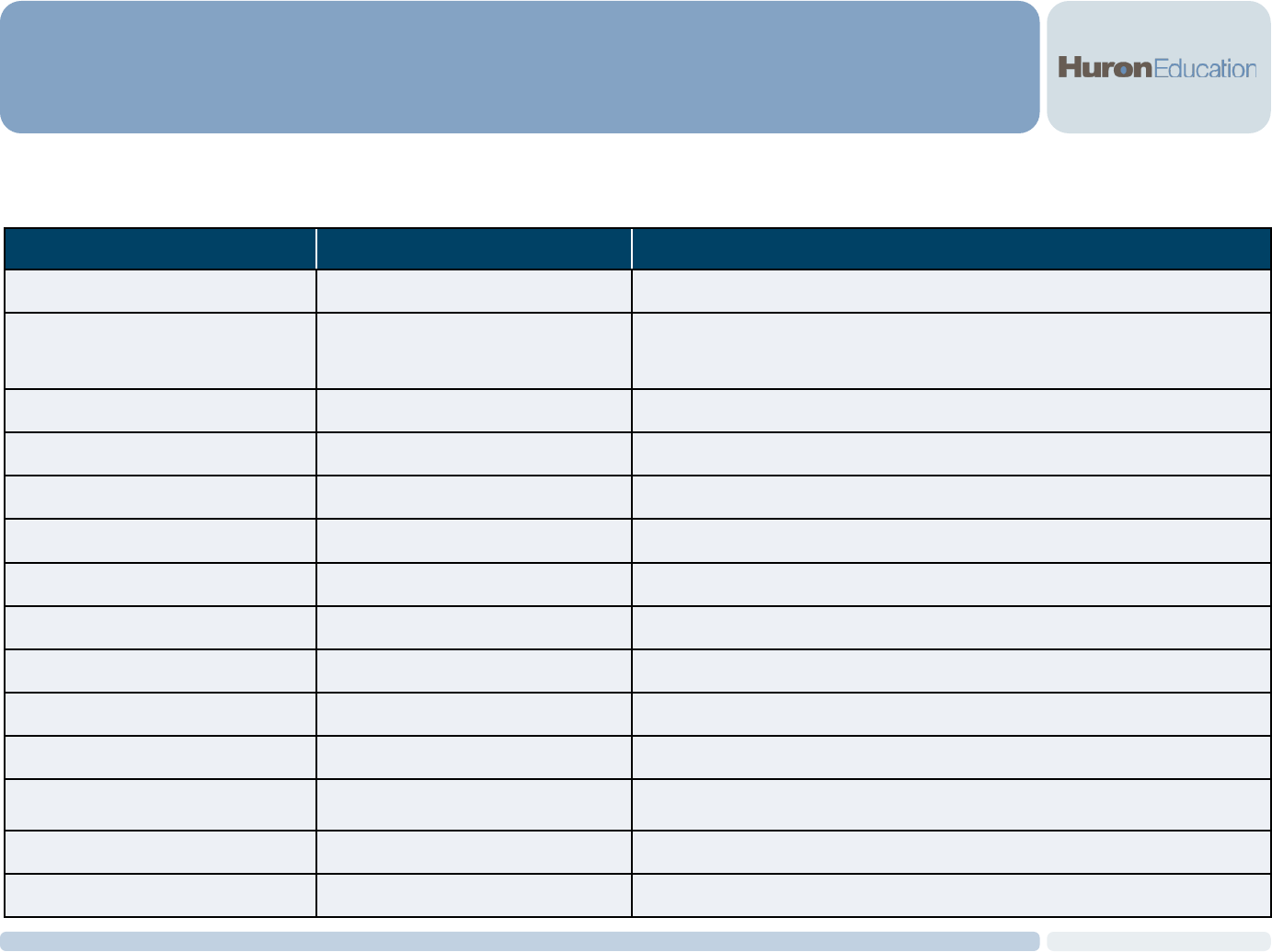
© 2015 Huron Consulting Group. All Rights Reserved. Proprietary & Confidential.
Instructional Technology Services
IT CATEGORIZATION BASIS
The following institution-specific IT units were included as part of Instructional Technology Services for the
analysis conducted by Huron.
98
Institution Total FTEs Institution-specific Units Included
UW Eau Claire
10.93
• Media and Learning Services
UW Extension/Colleges
6
• Learning Technology (Est. 2 from Learning Technology, Application
Management, and Media Services)
• Distance Education
UW Green Bay
12
• Academic Technology Services
UW La Crosse
8
• Academic Technology Services
UW Milwaukee
8
• Classroom Services and Learning TECHniques under Client Services
UW Madison
75.6
• Learning Technologies and Academic Technology
UW Oshkosh
13.5
• Learning Technologies
UW Parkside
5
• Learning Technology Center
UW Platteville
7
• Media Development Technology
UW River Falls
2
• Teaching and Learning Technologies
UW Stout
10
• Learning Technology Services
UW Stevens Point
2
• TEC (Teaching and Learning Resource Network)
UW Superior
UW Whitewater
4
• Instructional Technology Service
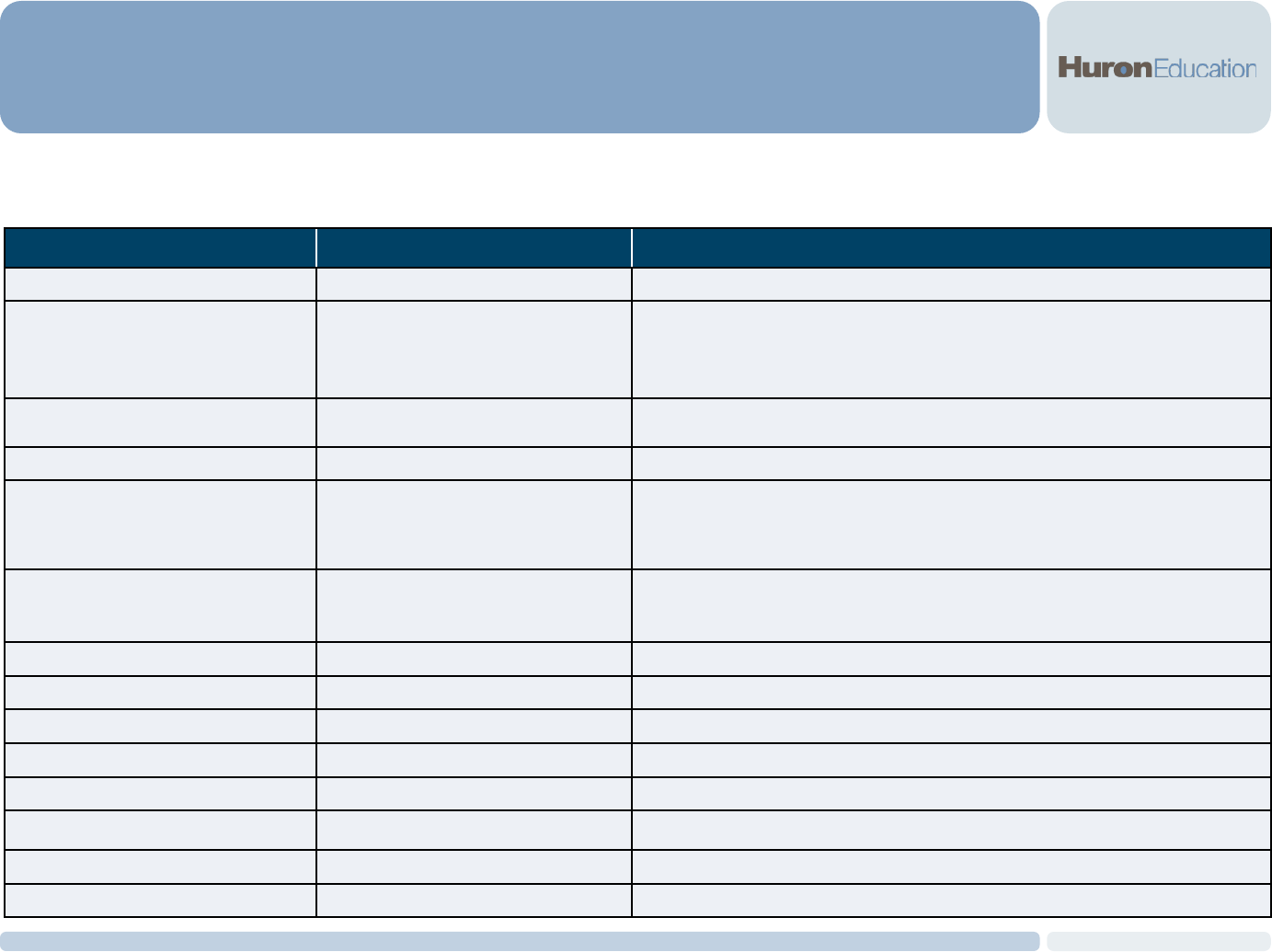
© 2015 Huron Consulting Group. All Rights Reserved. Proprietary & Confidential.
Administration / Finance / Other
IT CATEGORIZATION BASIS
The following institution-specific IT units were included as part of Administration / Finance / Other for the
analysis conducted by Huron.
99
Institution Total FTEs Institution-specific Units Included*
UW Eau Claire
1
UW Extension/Colleges
11
• Service Success and Projects and Service Delivery
• Media Services (Est. 1 from Learning Technology, Application
Management, and Media Services)
UW Green Bay
4
• Web Services
• Administrative and Finance Support Staff
UW La Crosse
2
• Administrative Support Staff
UW Milwaukee
7
• Research Computing
• IT Strategic Communications
• Chief Operating Officer
UW Madison
25.75
• Communications, Financial Services, Information Tech. Academy, and
Policy & Planning
• Division Office (Non-Security)
UW Oshkosh
3
• Business Operations
UW Parkside
8
• Creative Services and Administrative Support Staff
UW Platteville
2
• Administrative Support Staff
UW River Falls
2
• Administrative Support Staff
UW Stout
4
• Administrative Support Staff
UW Stevens Point
10
• Web and Media Services, and Information Technology Administration
UW Superior
.75
• Administrative Support Staff
UW Whitewater
33
• Unable to Categorize Based on Publically Available Information
Source: Chief Information Officers were Included in Administration / Finance / Other
